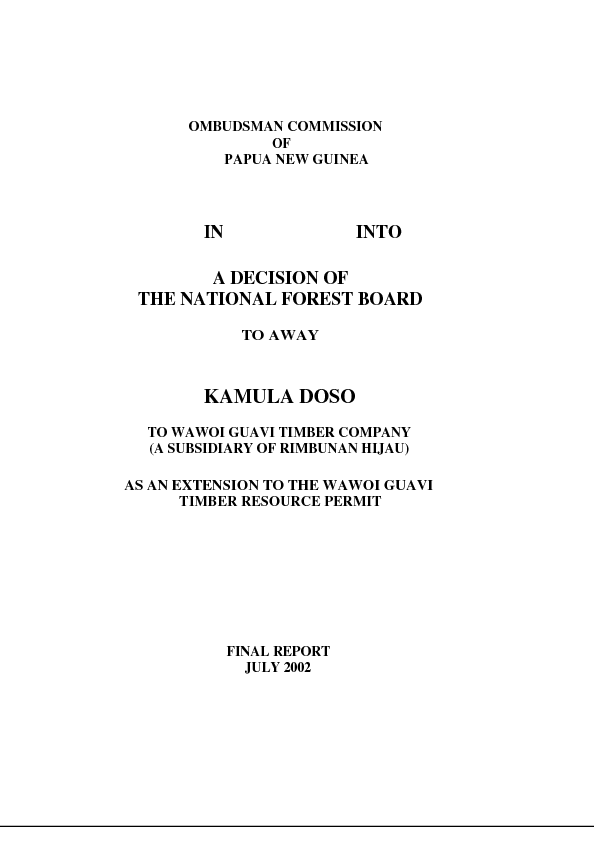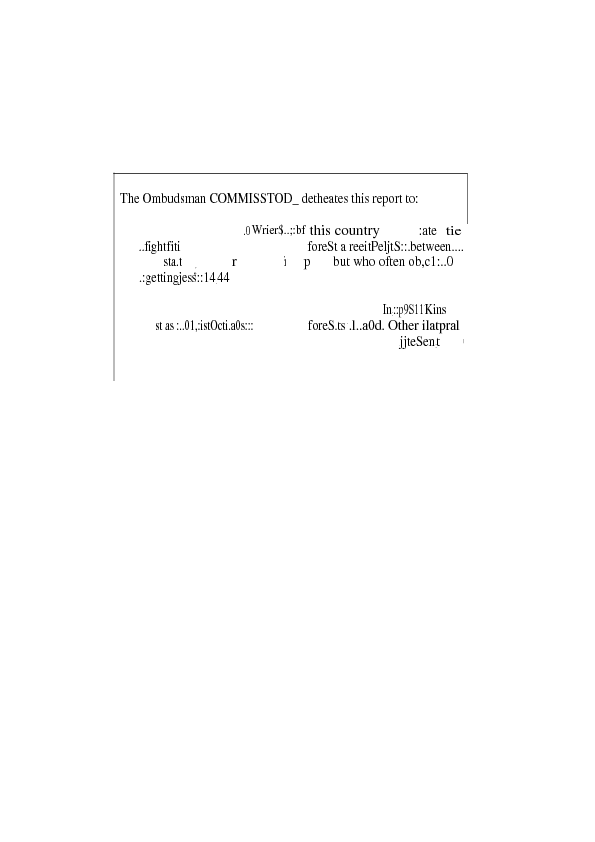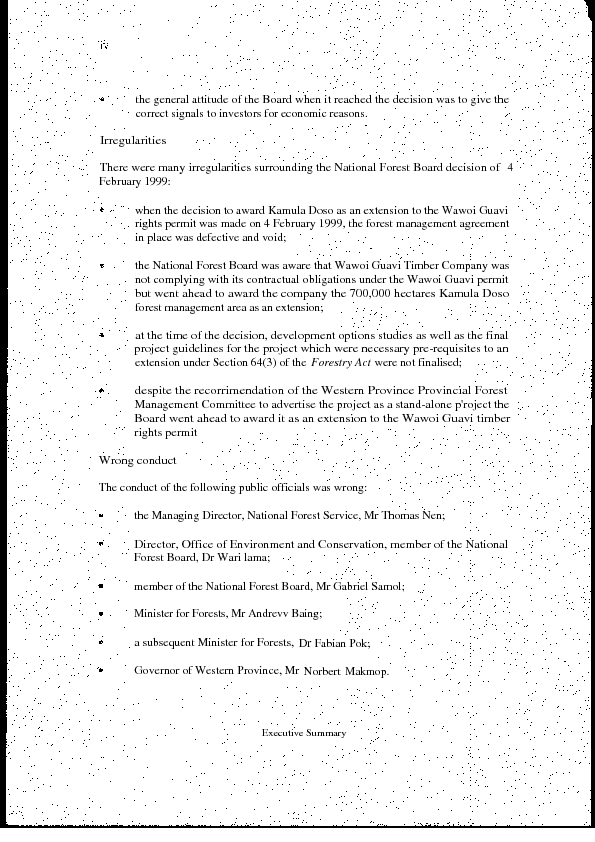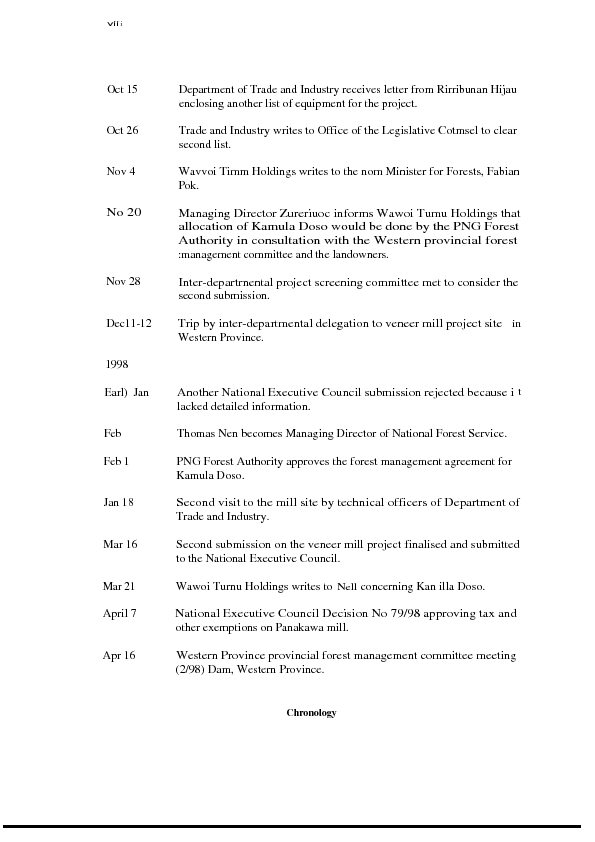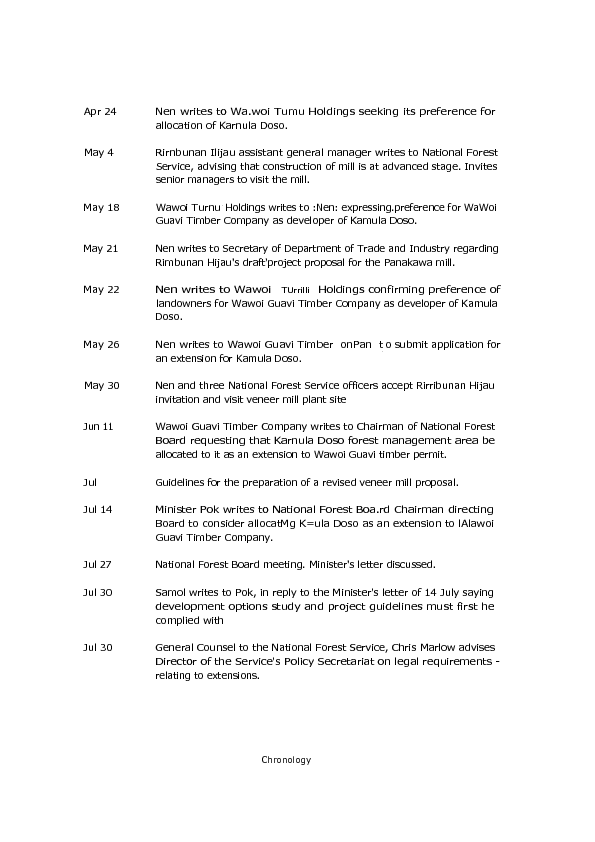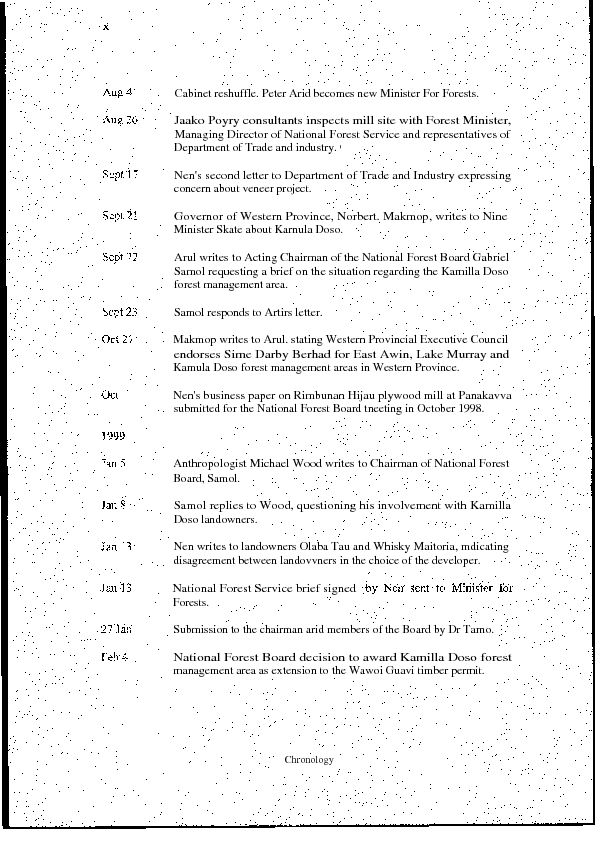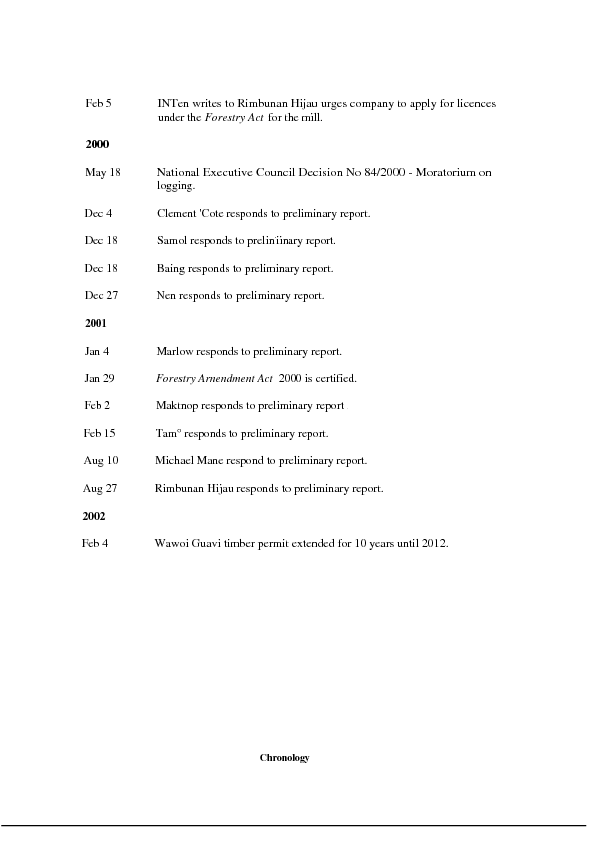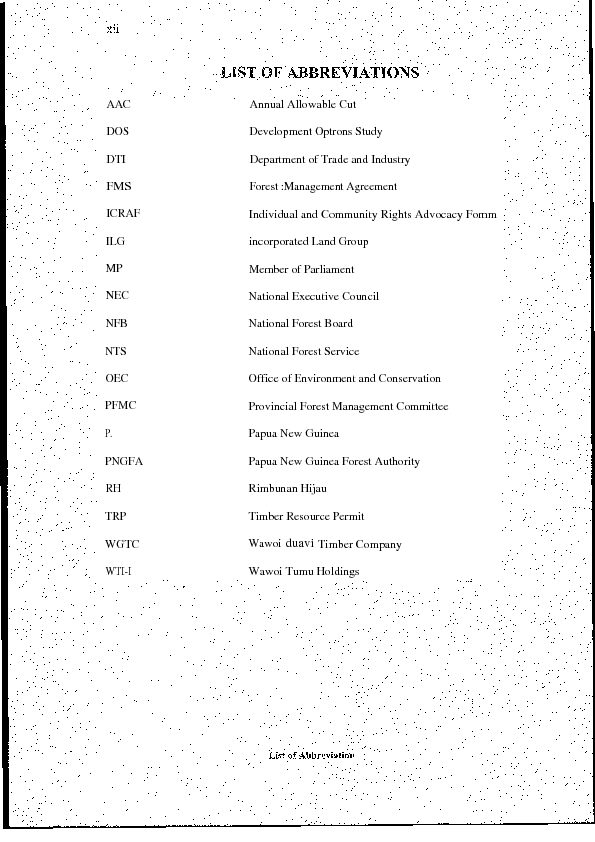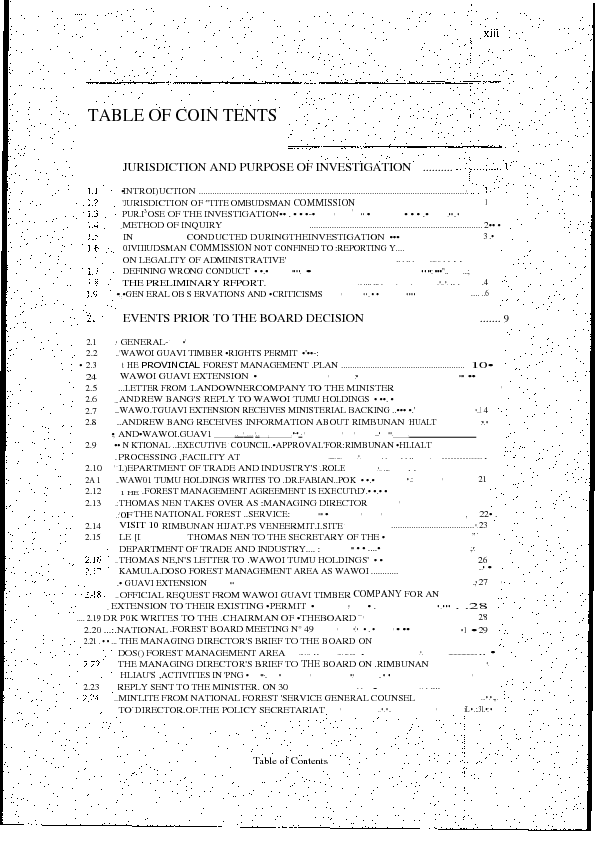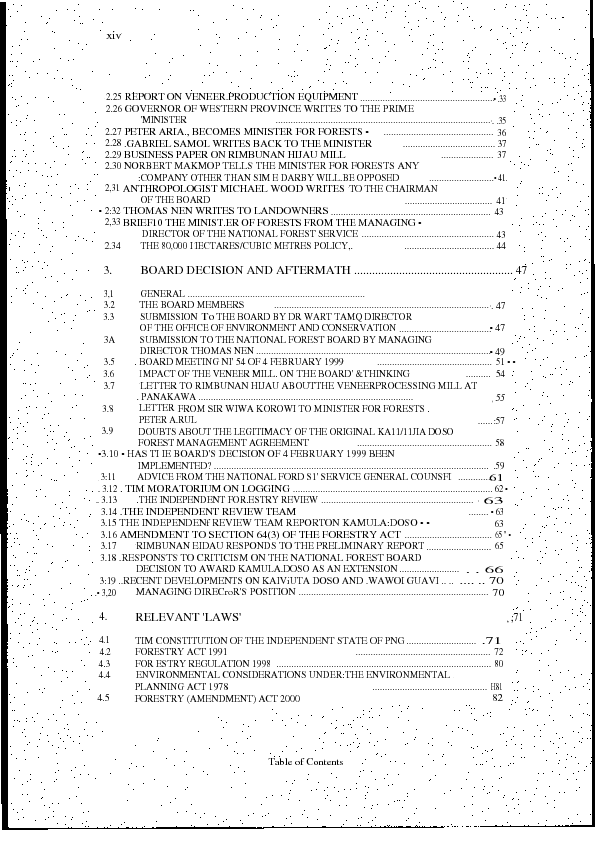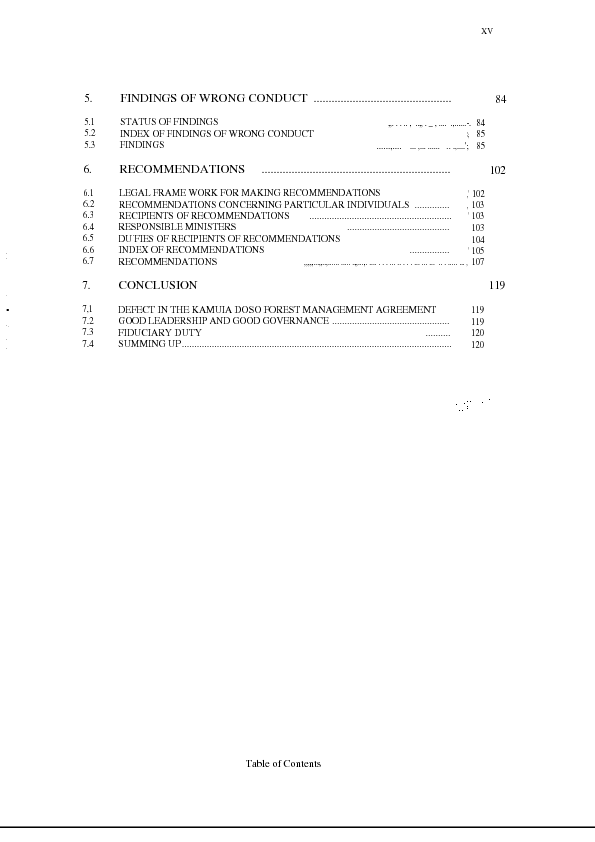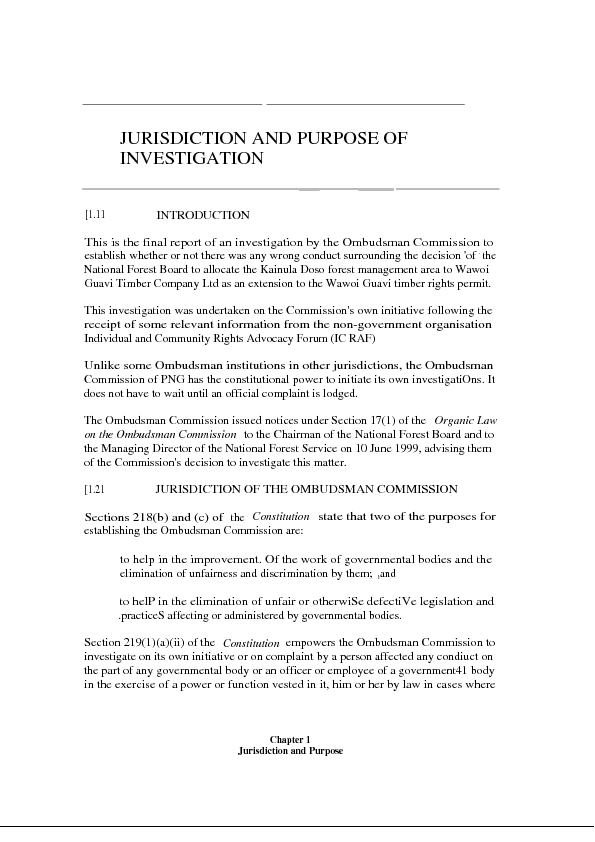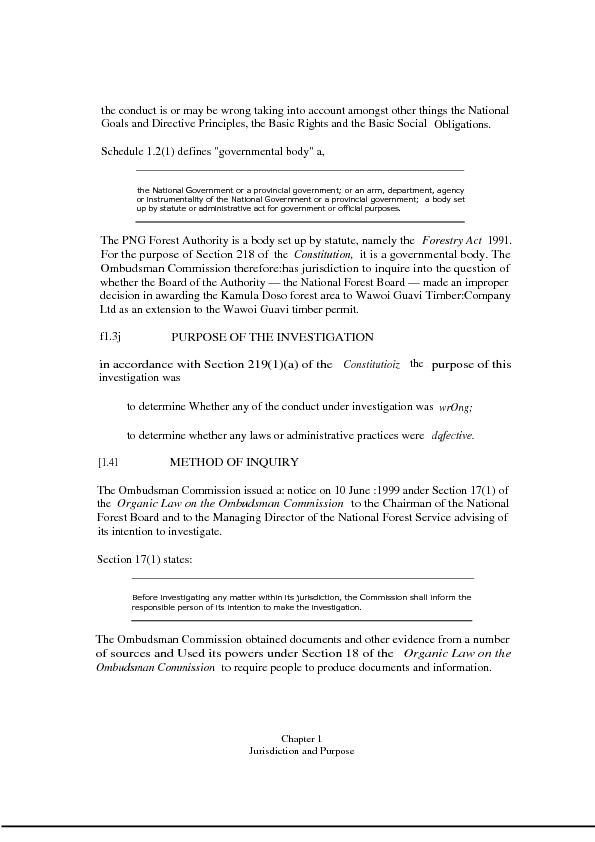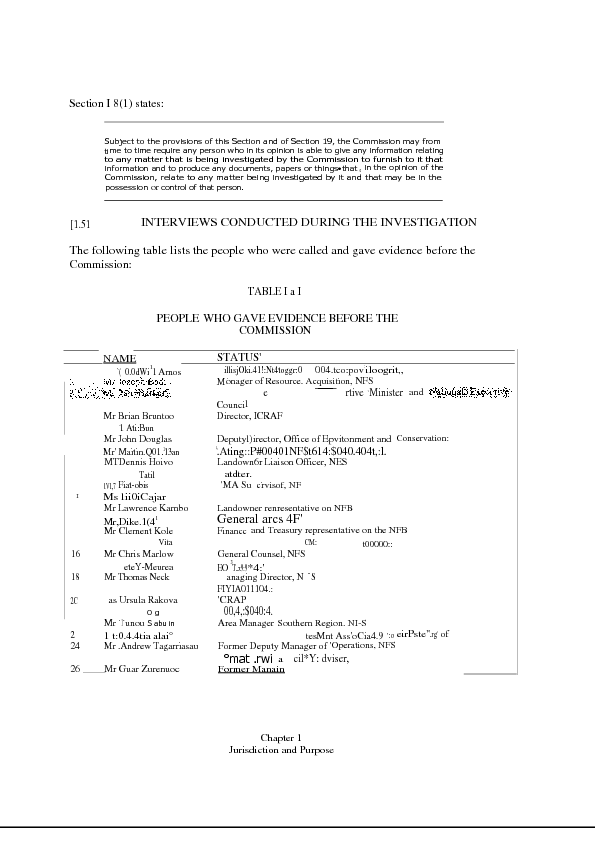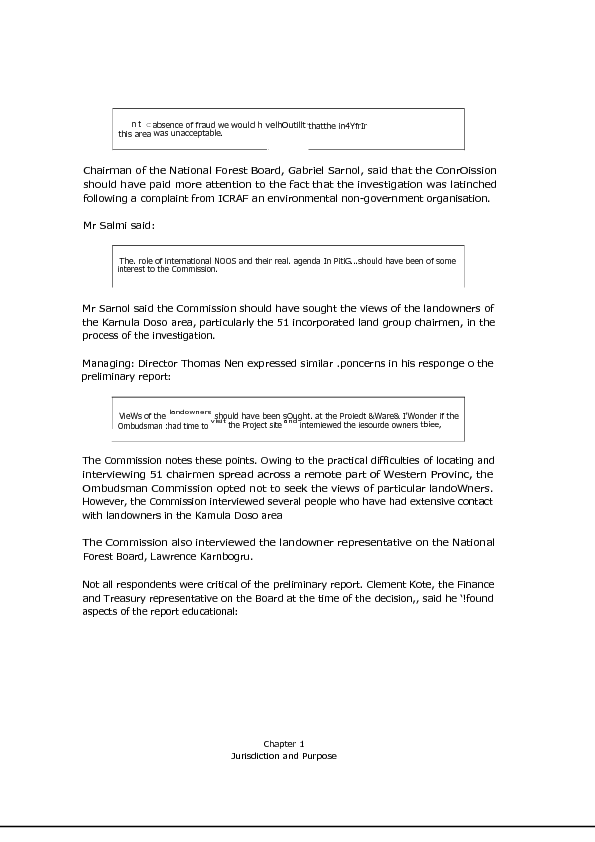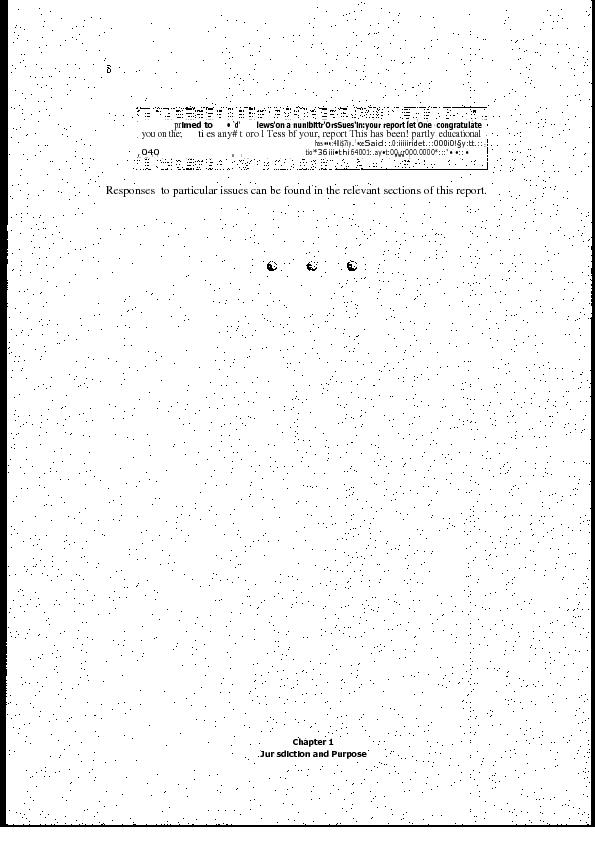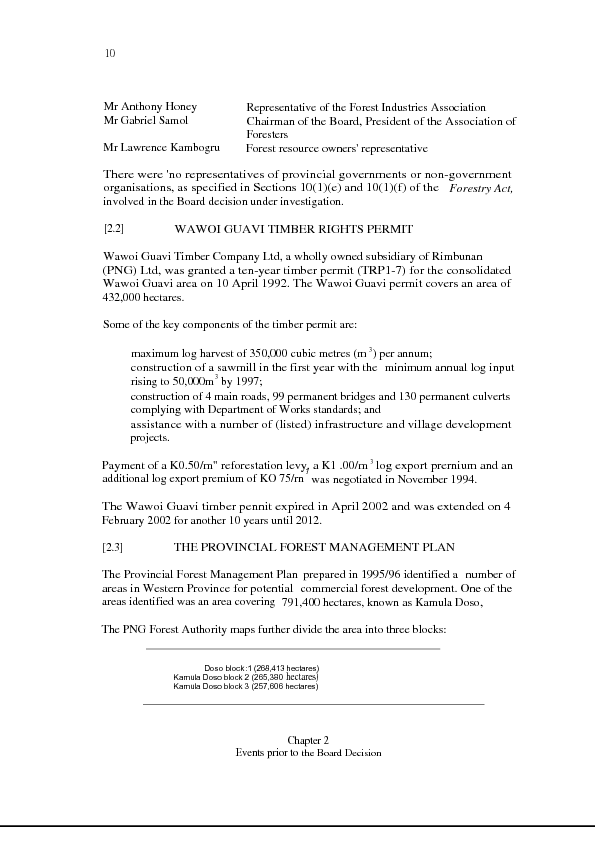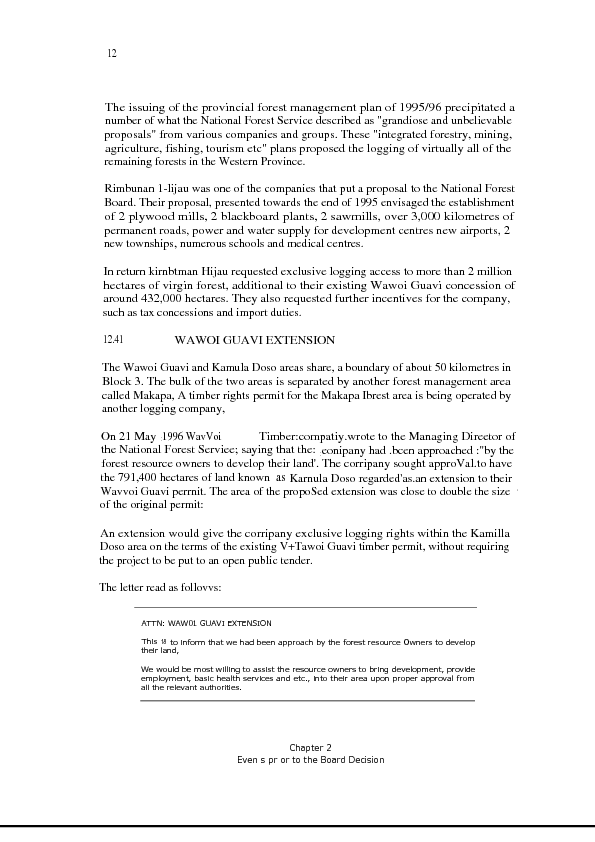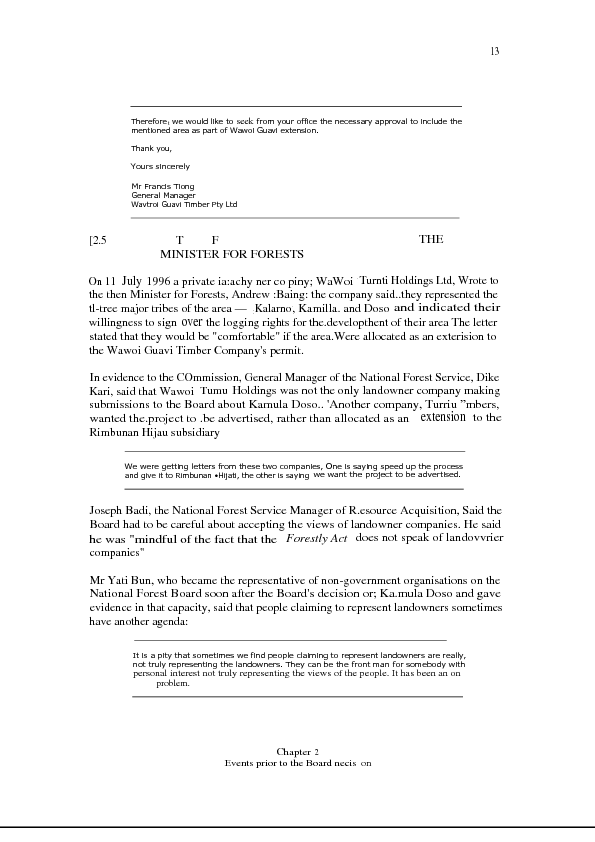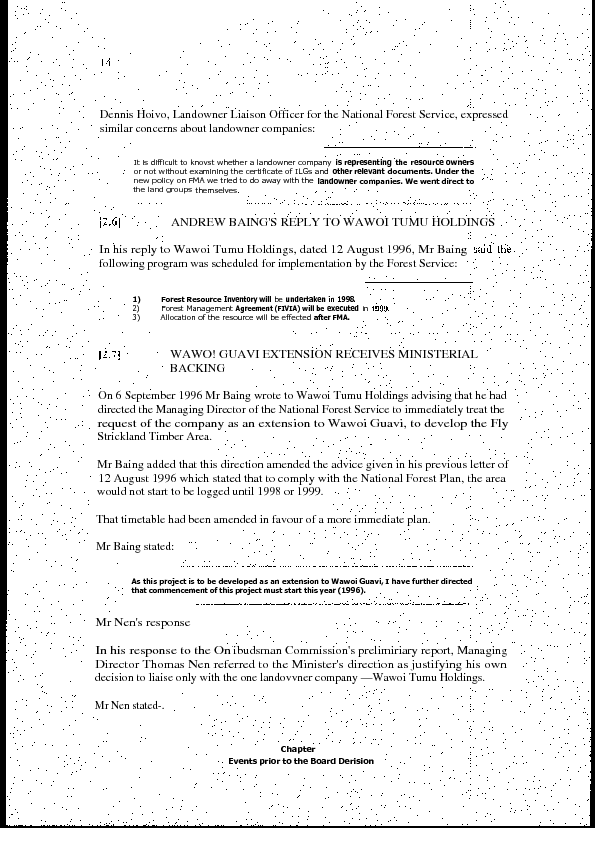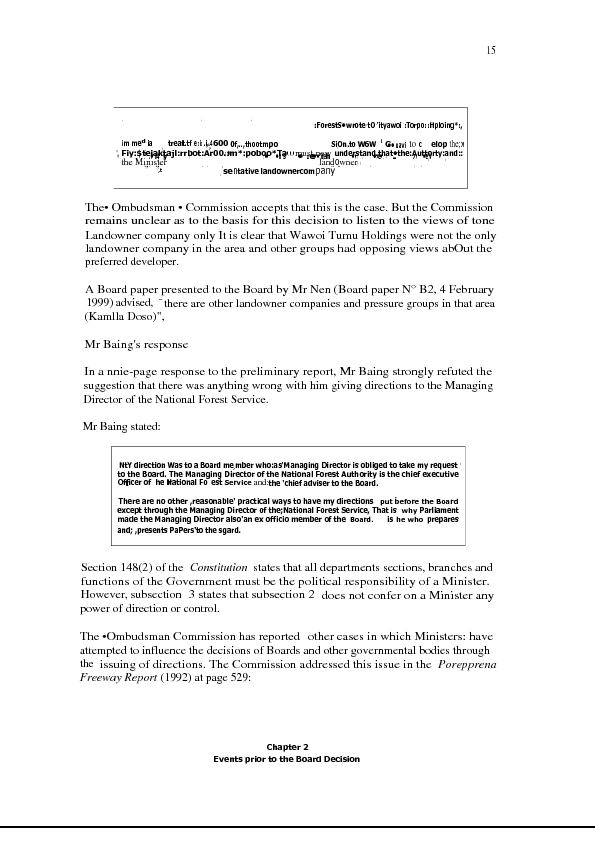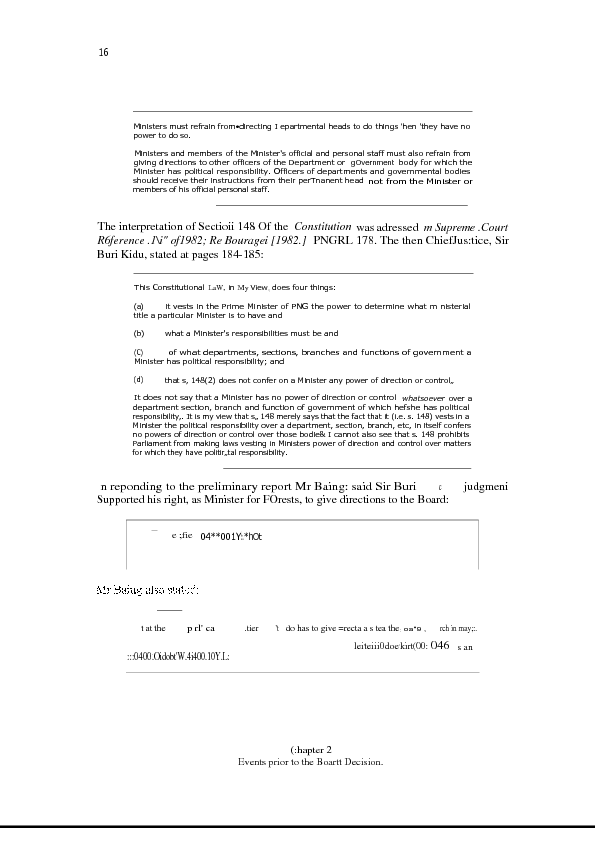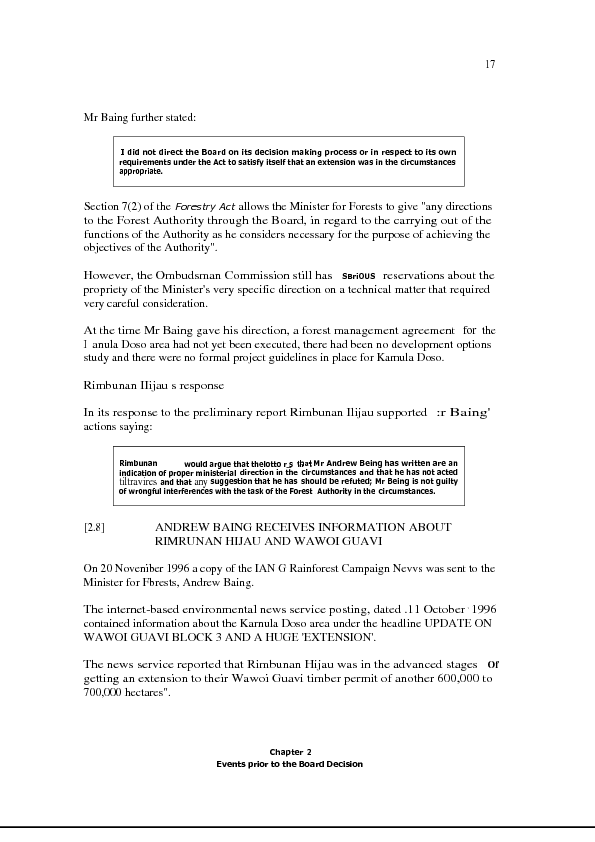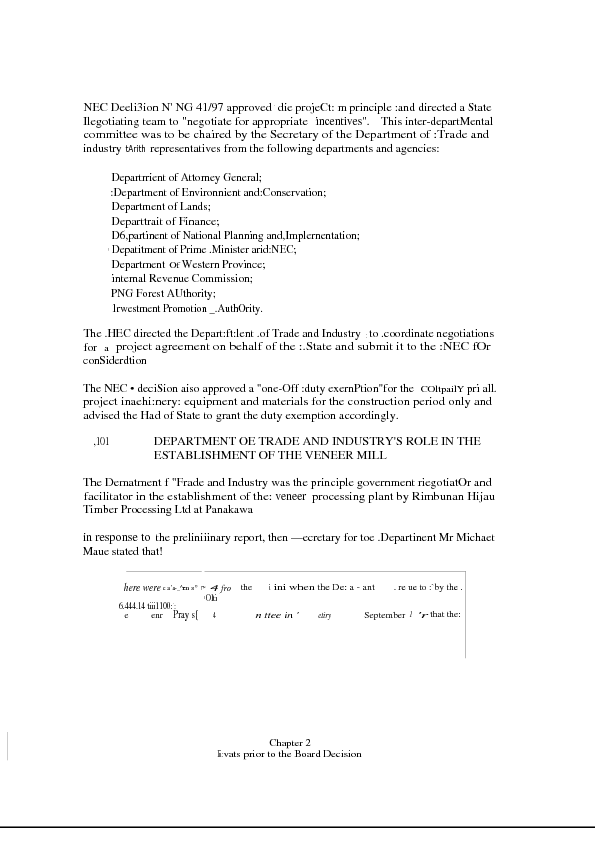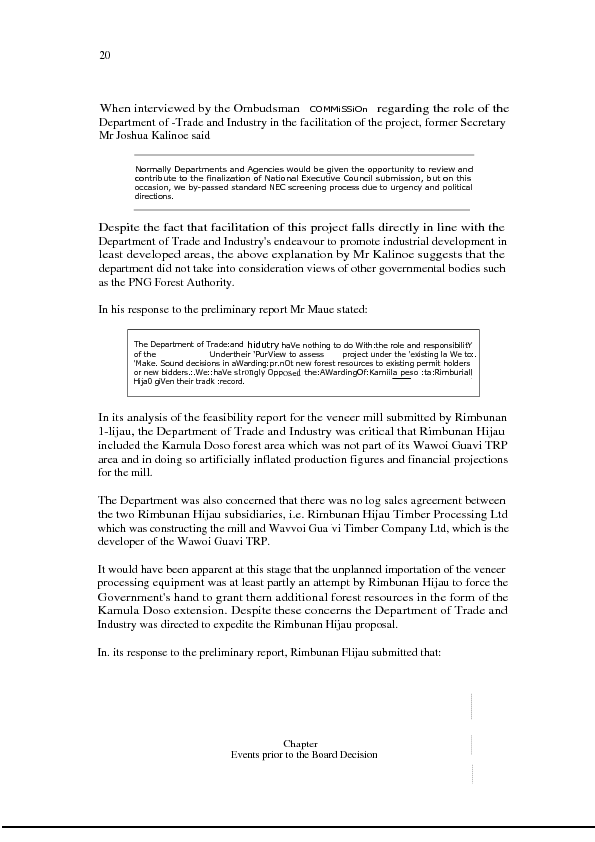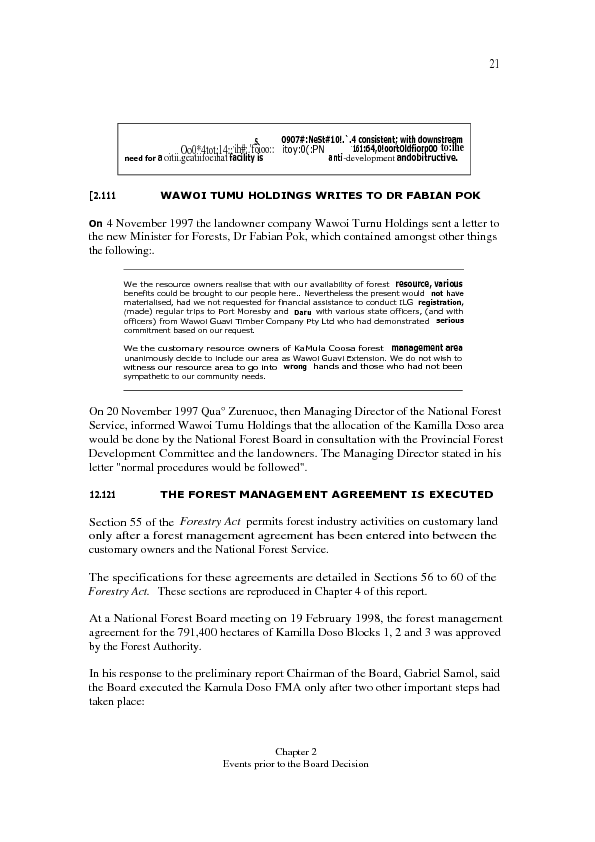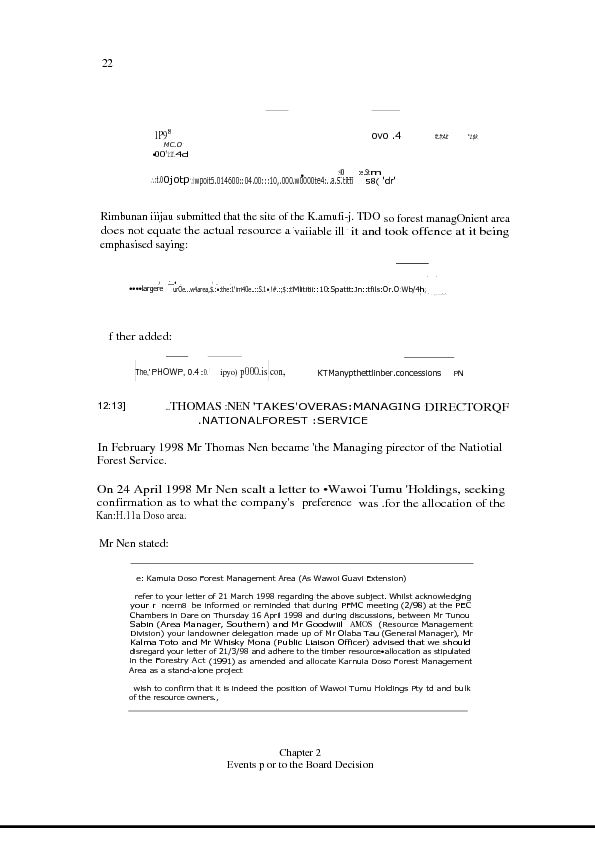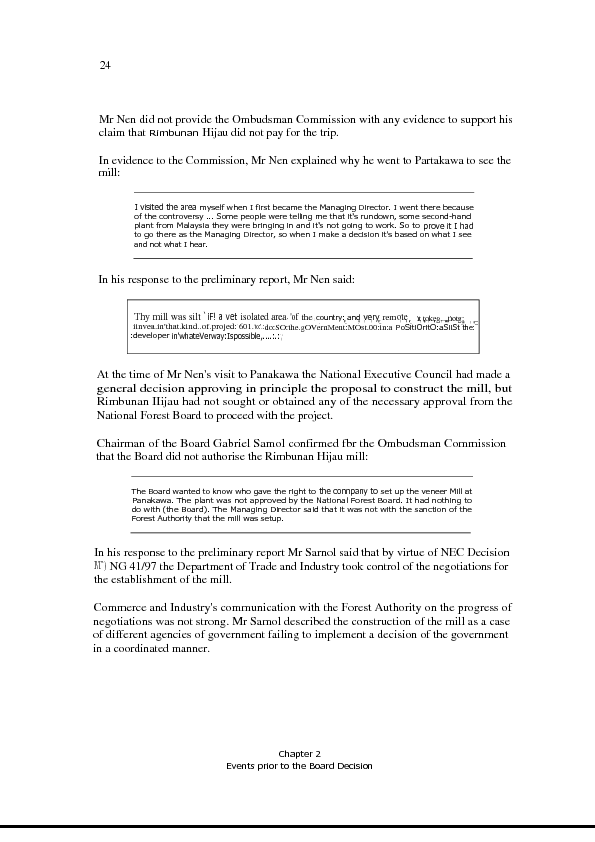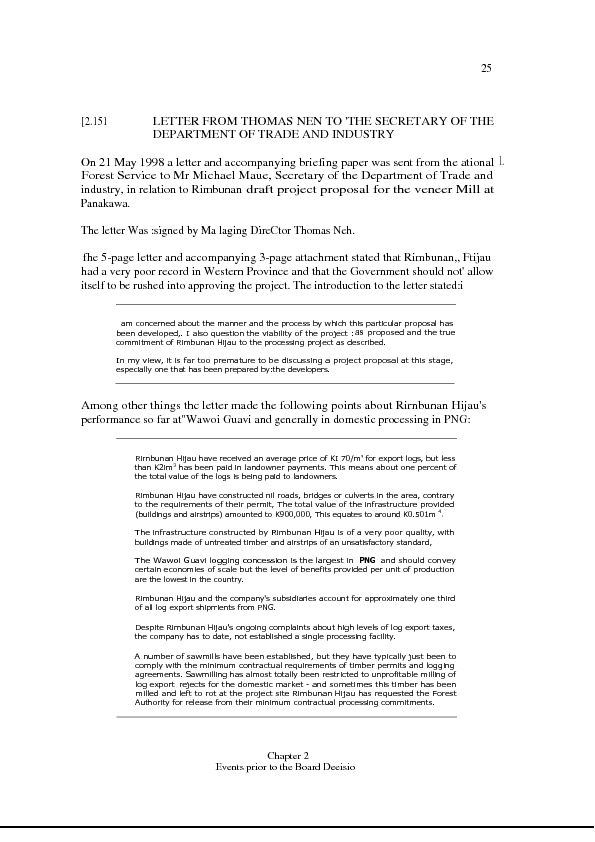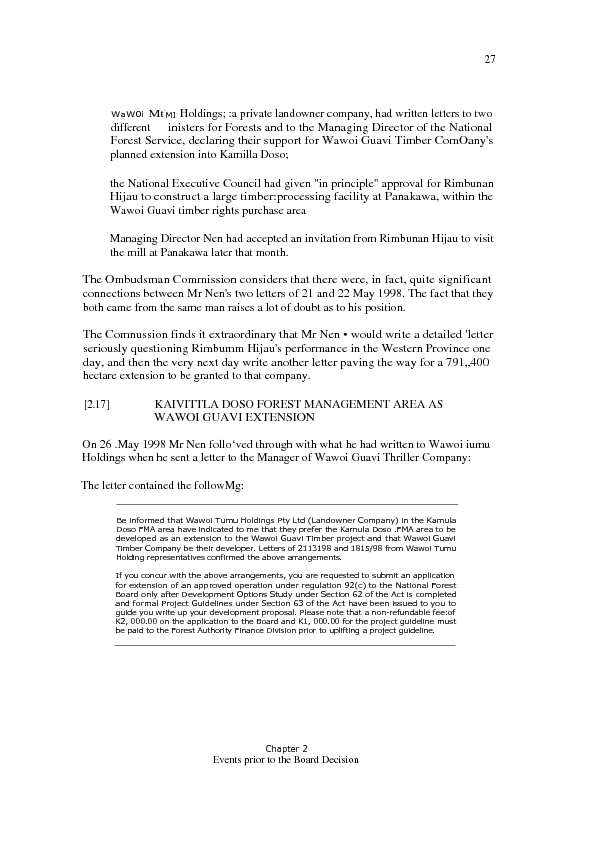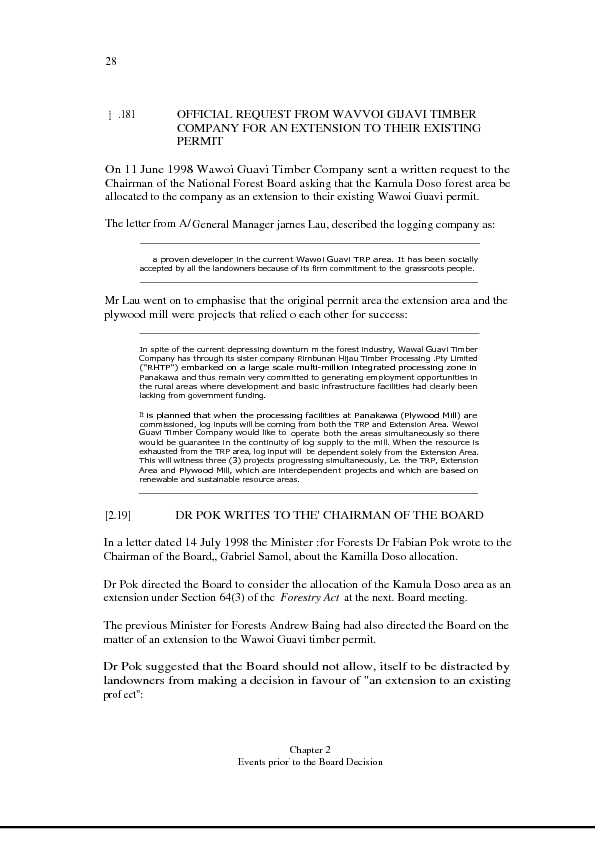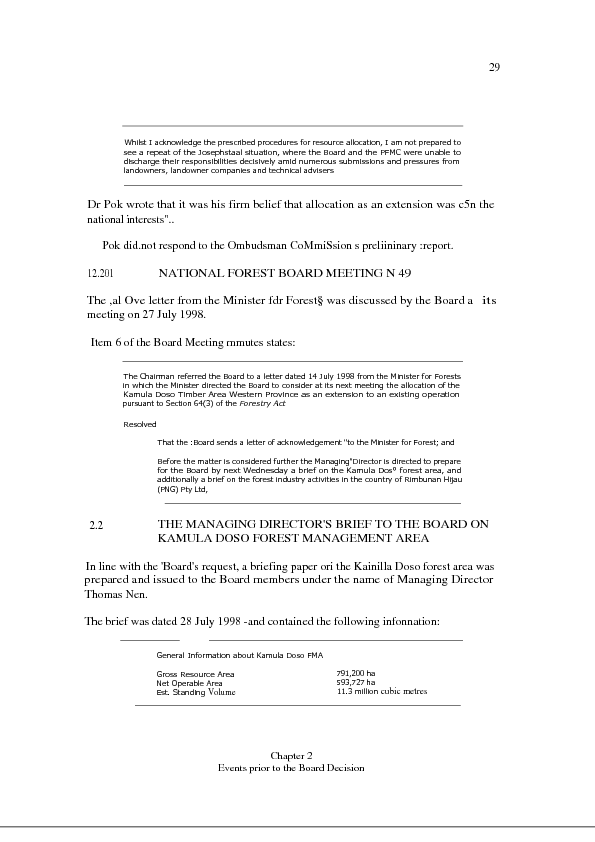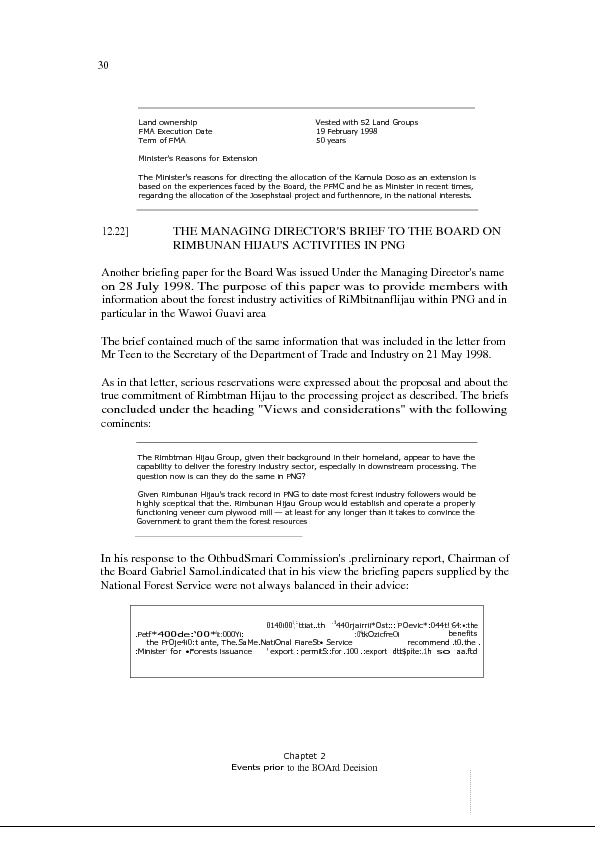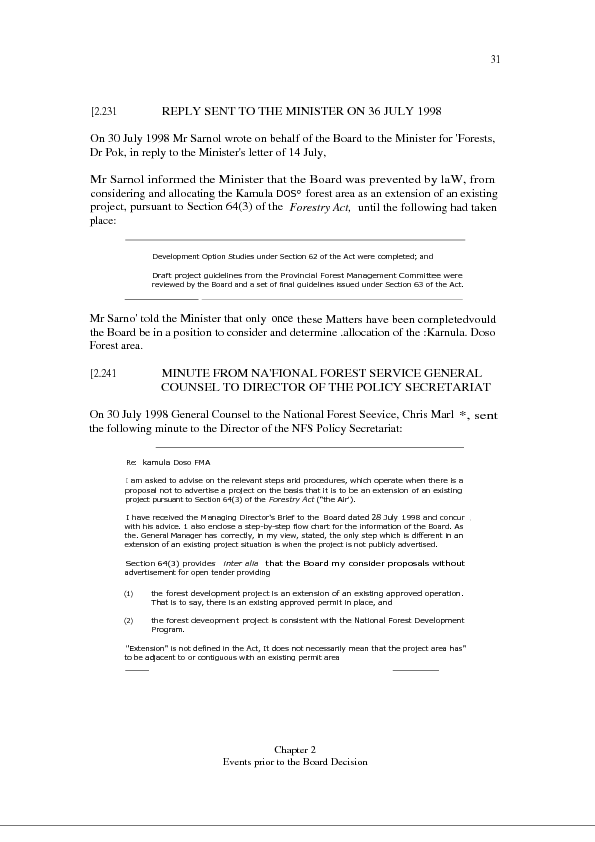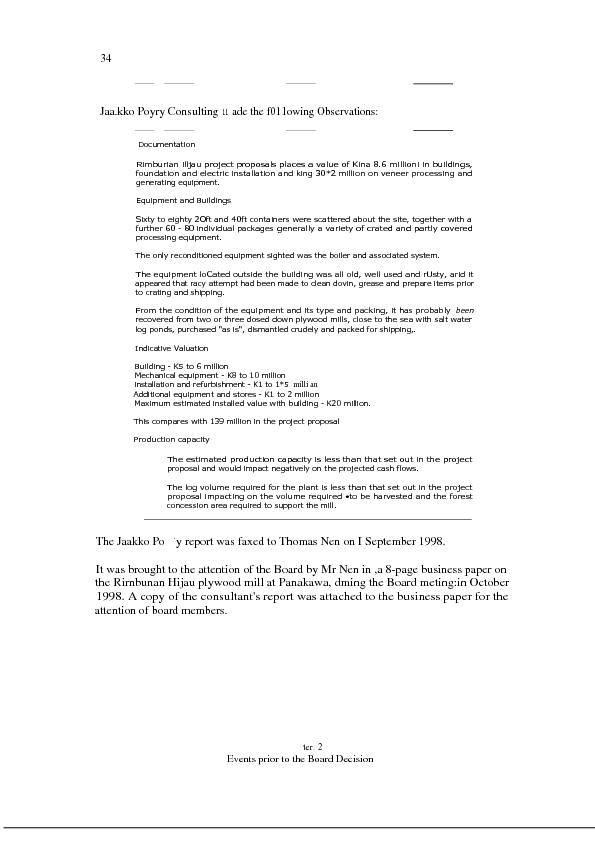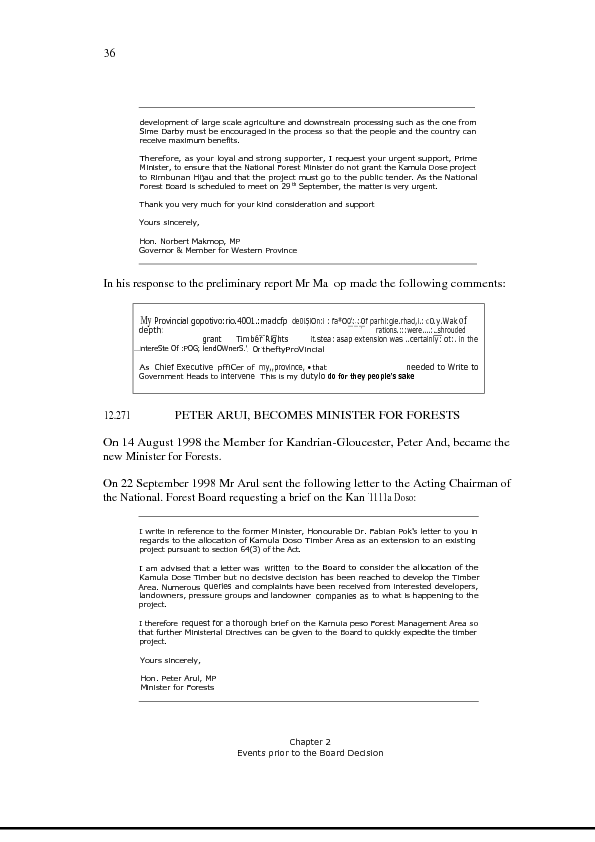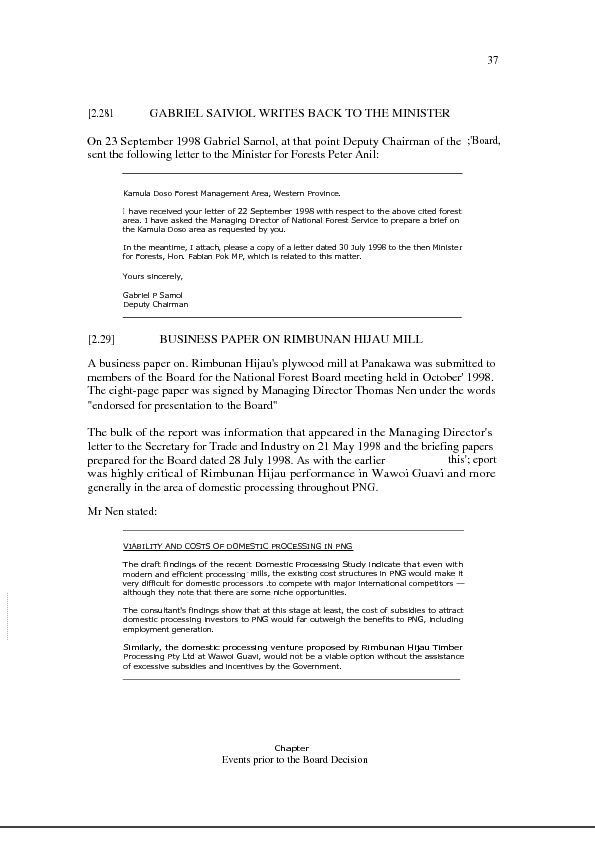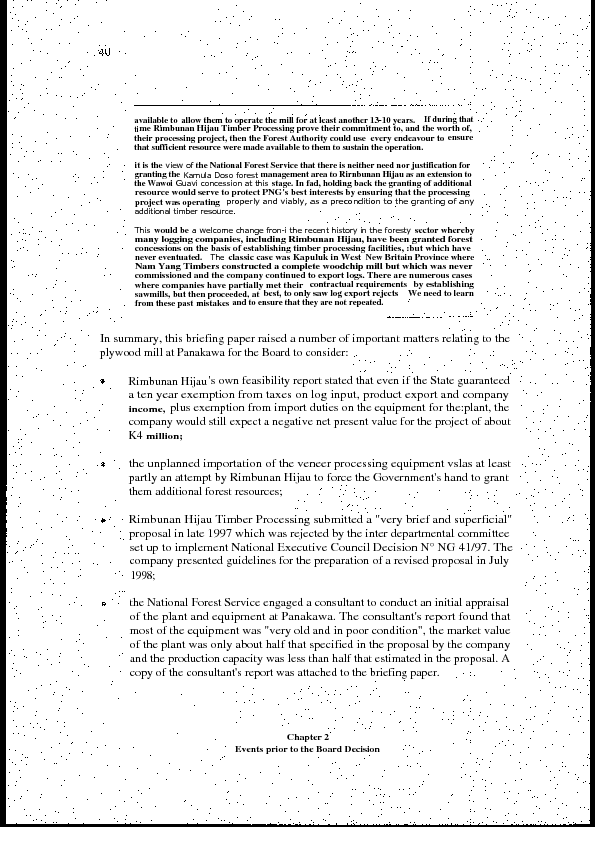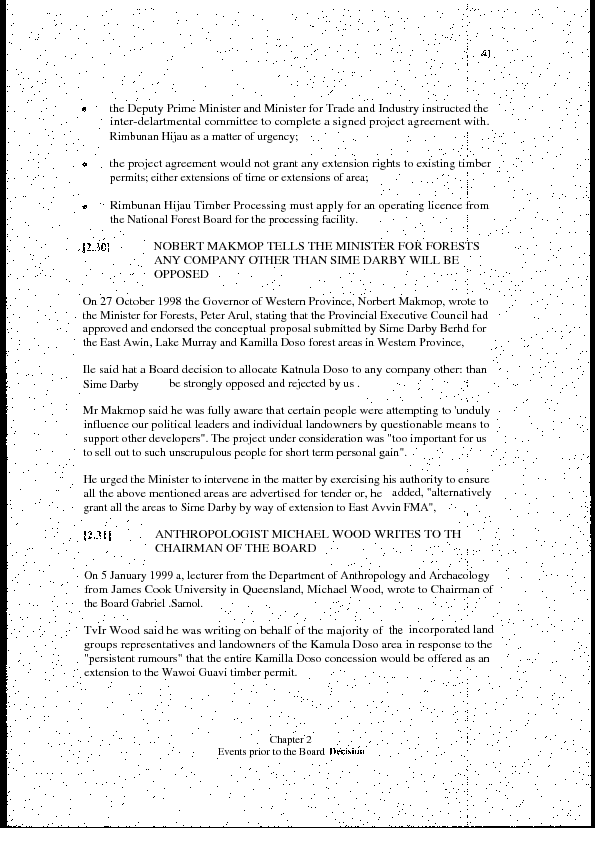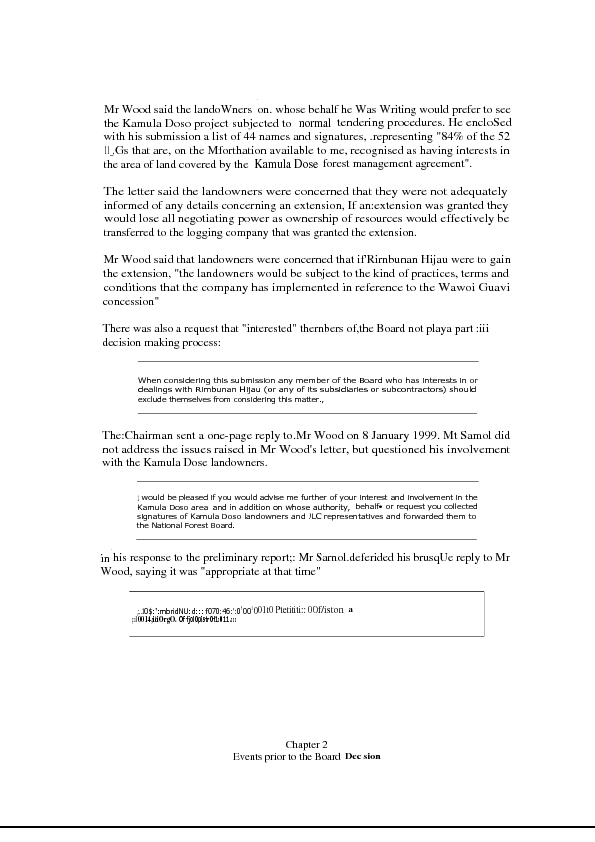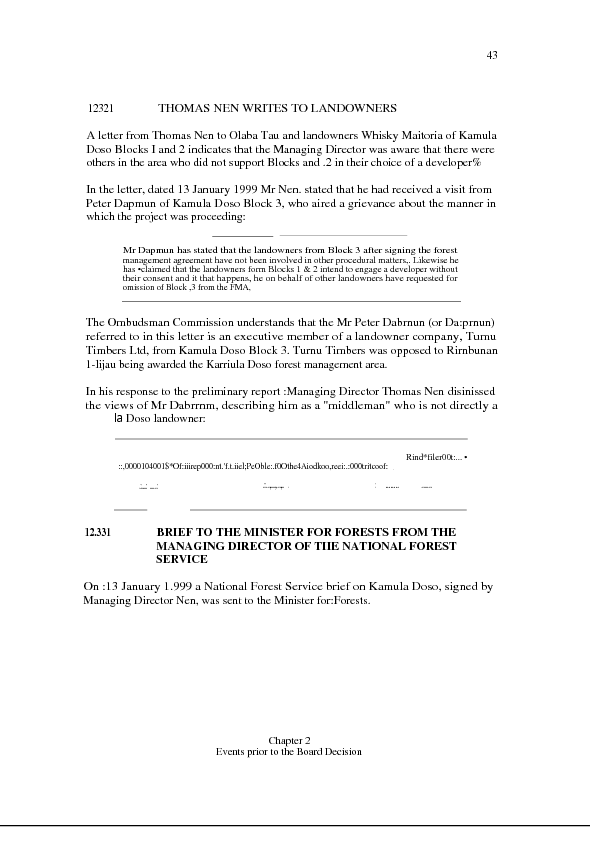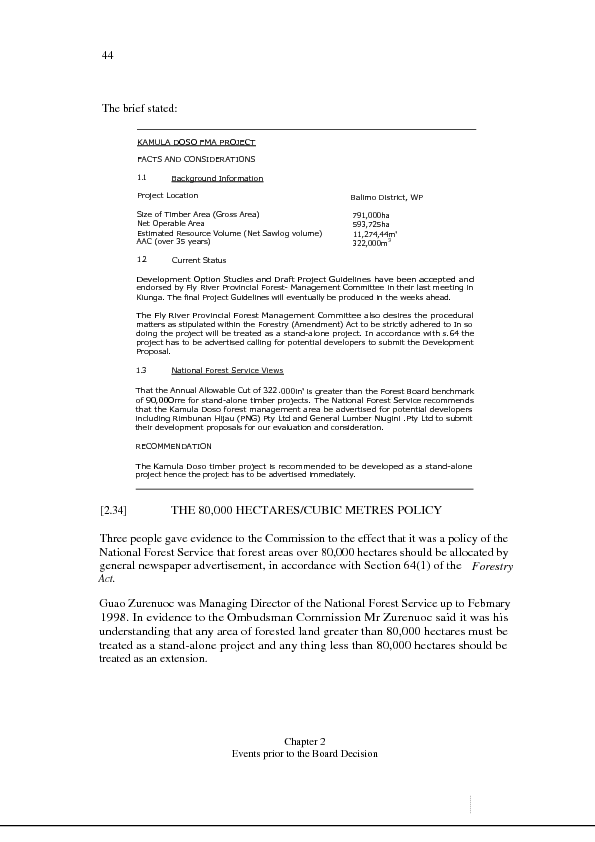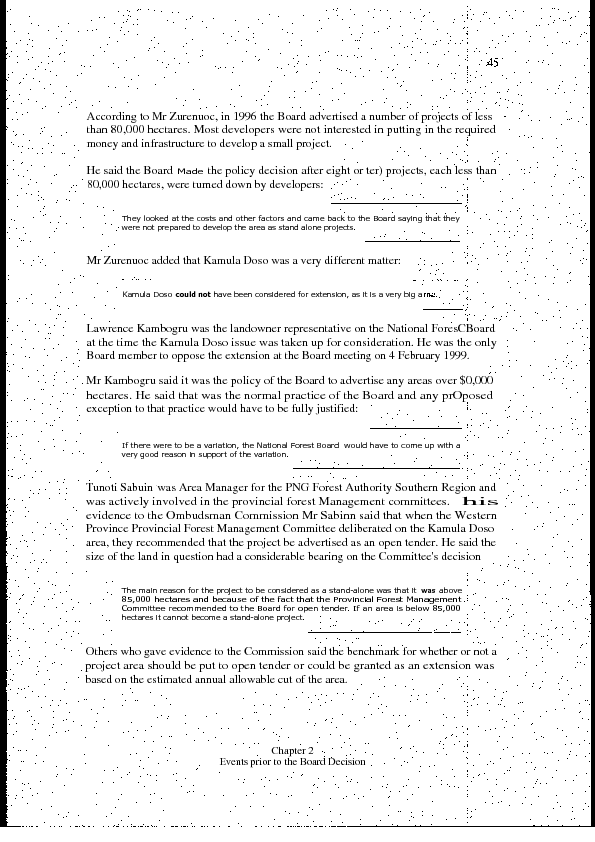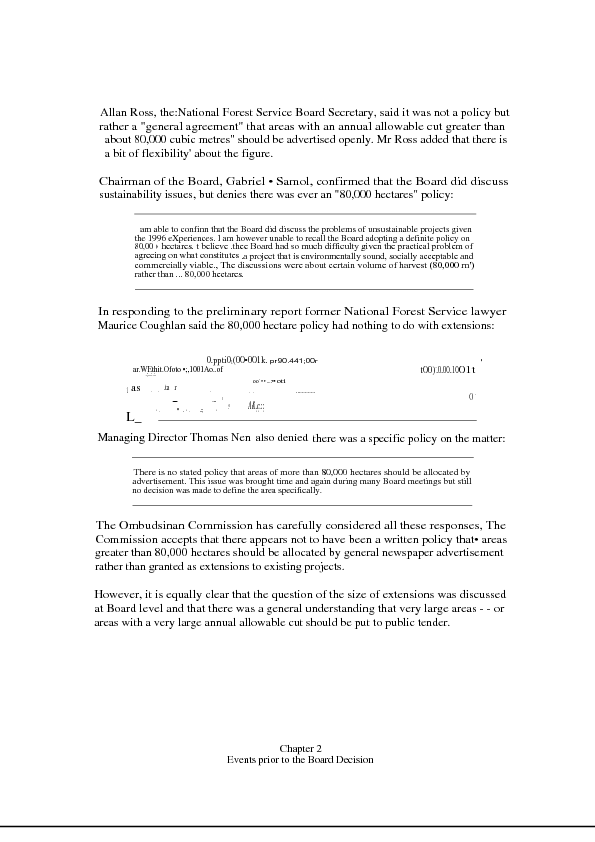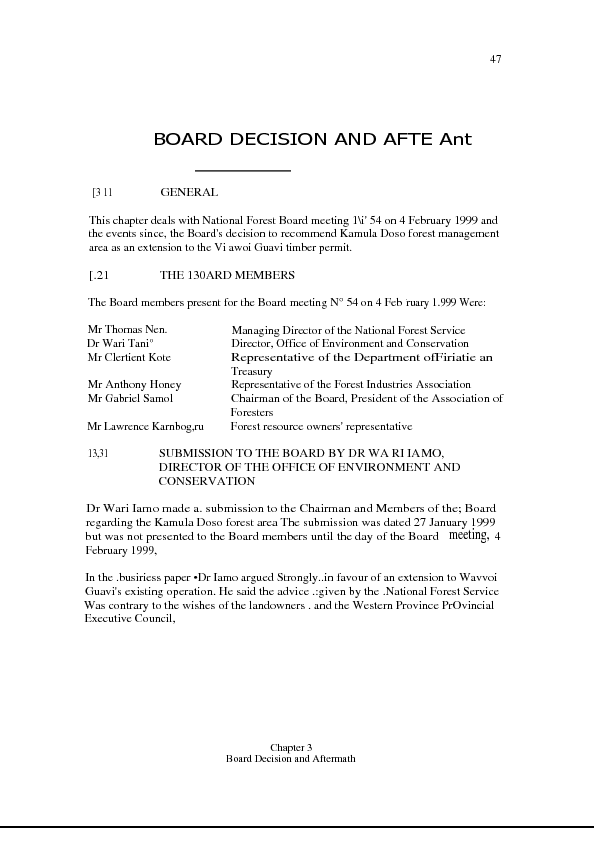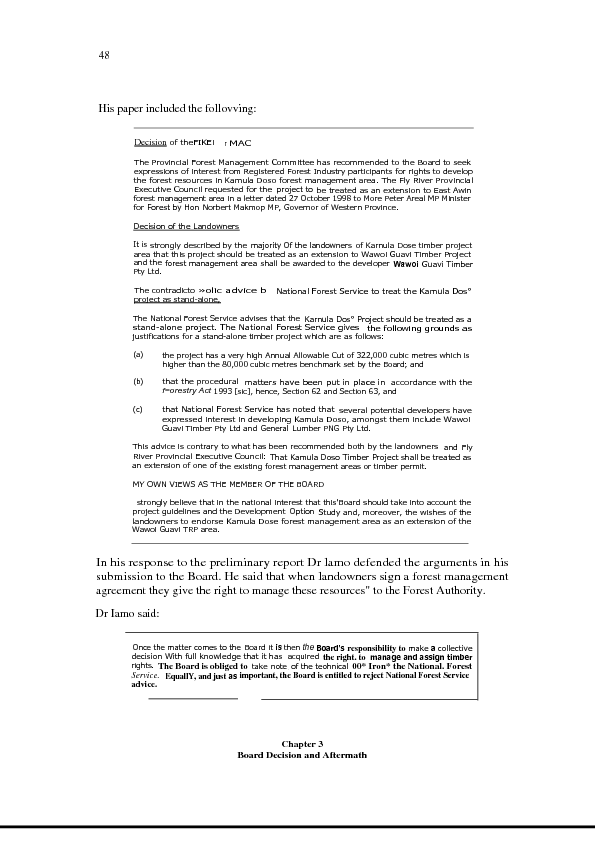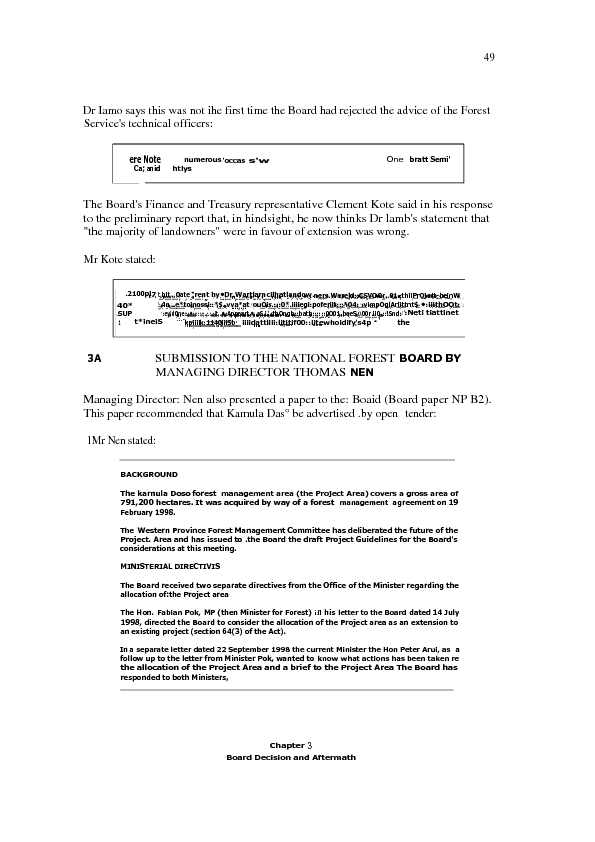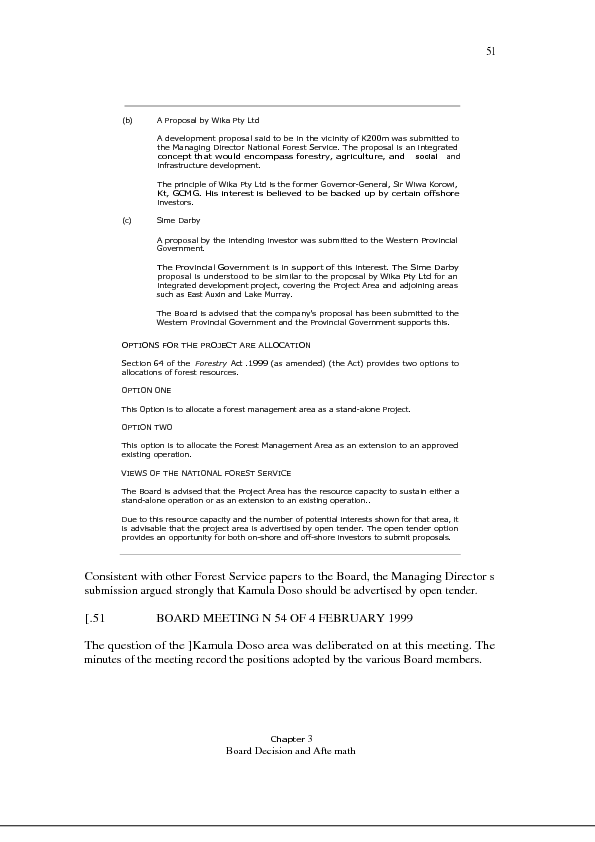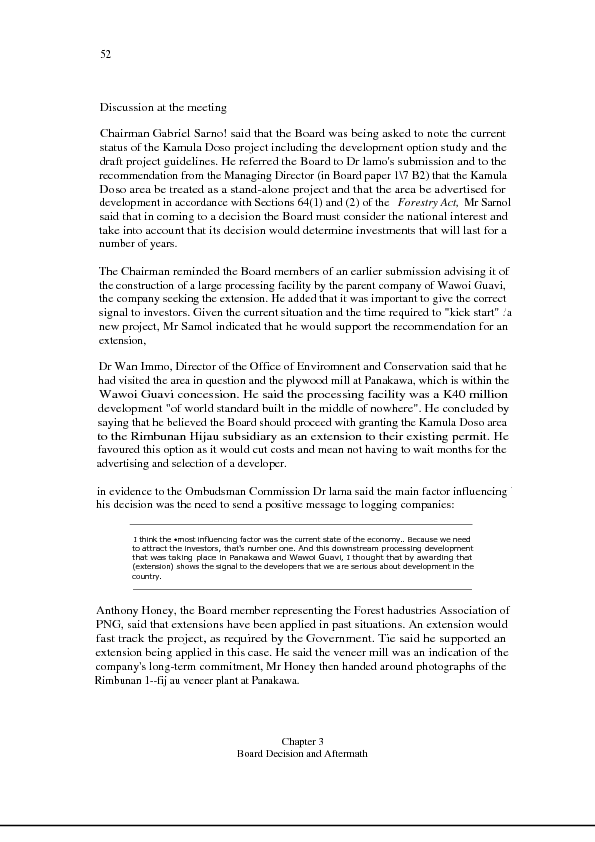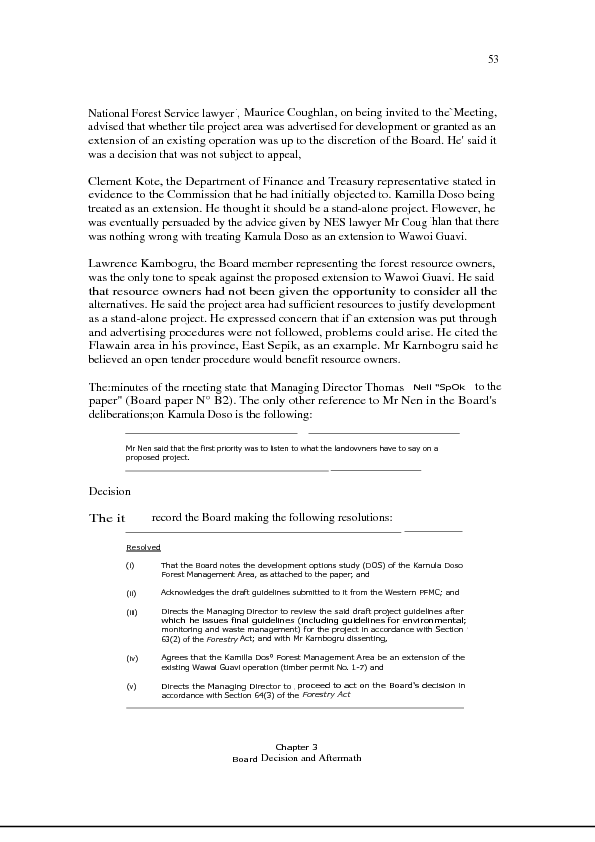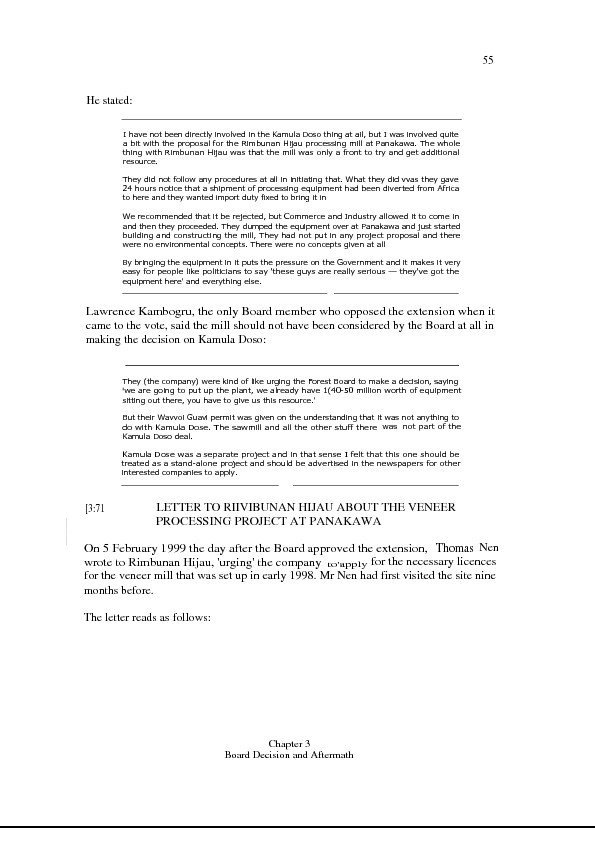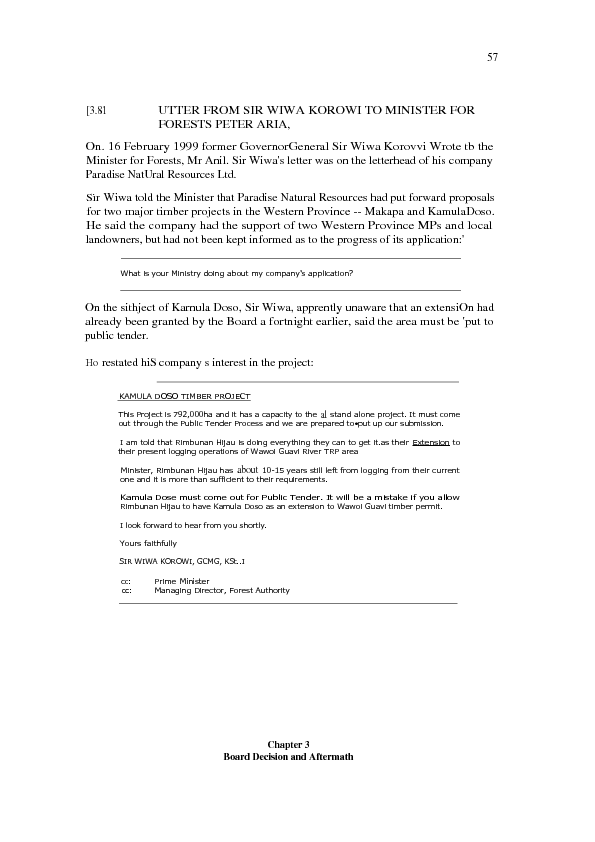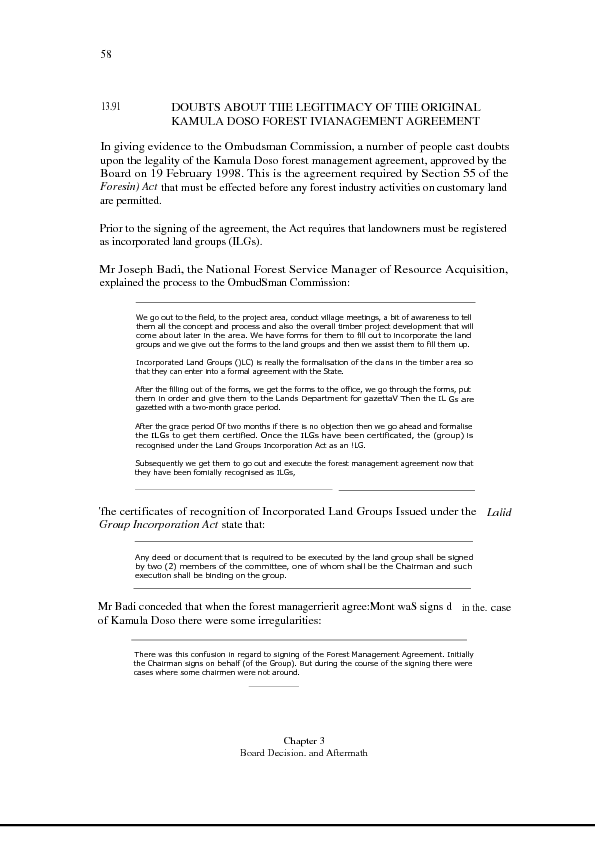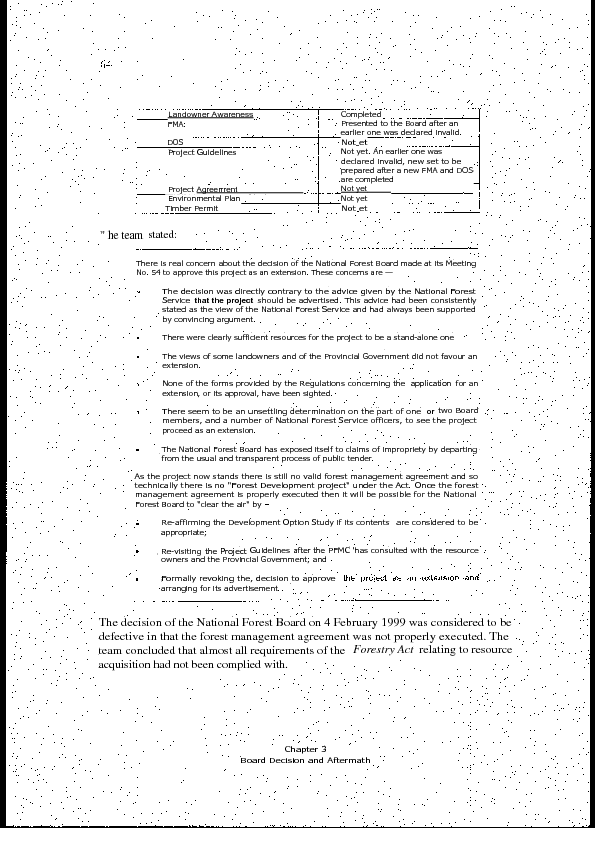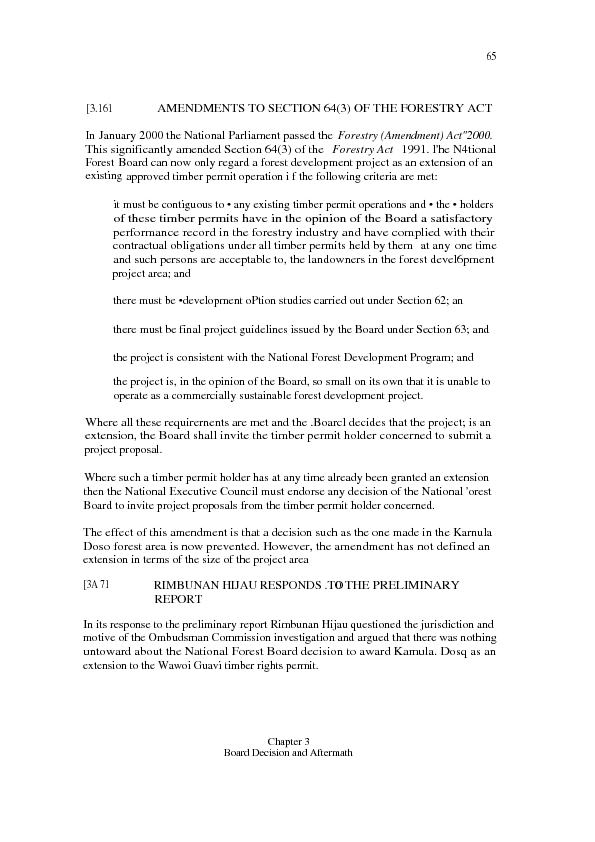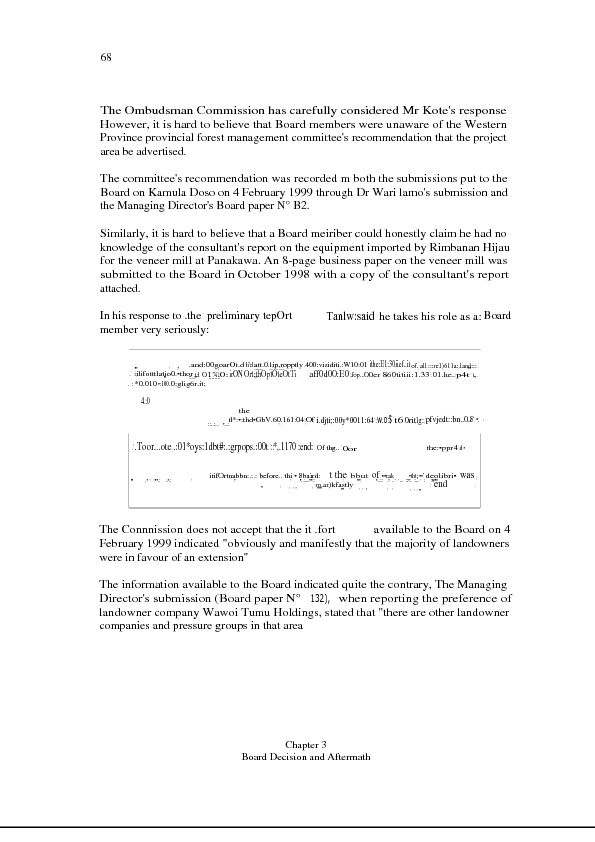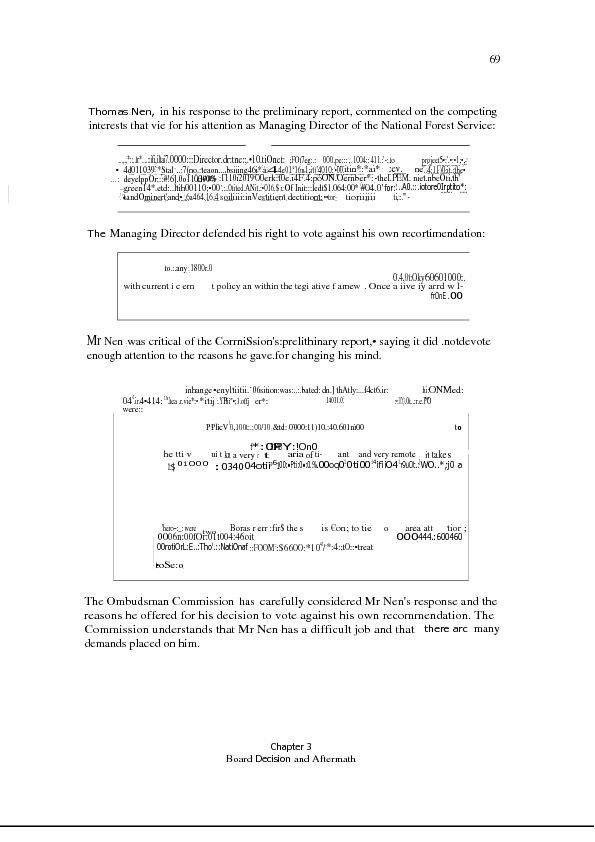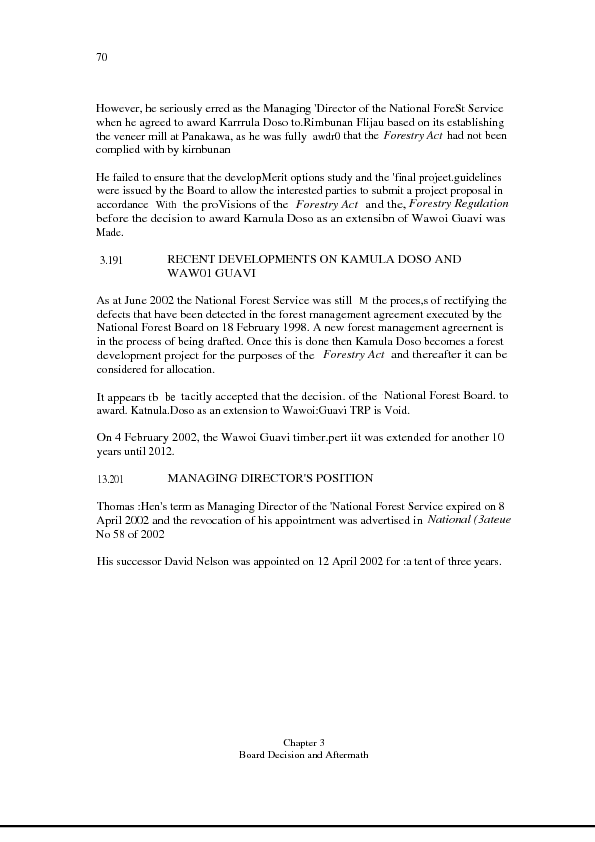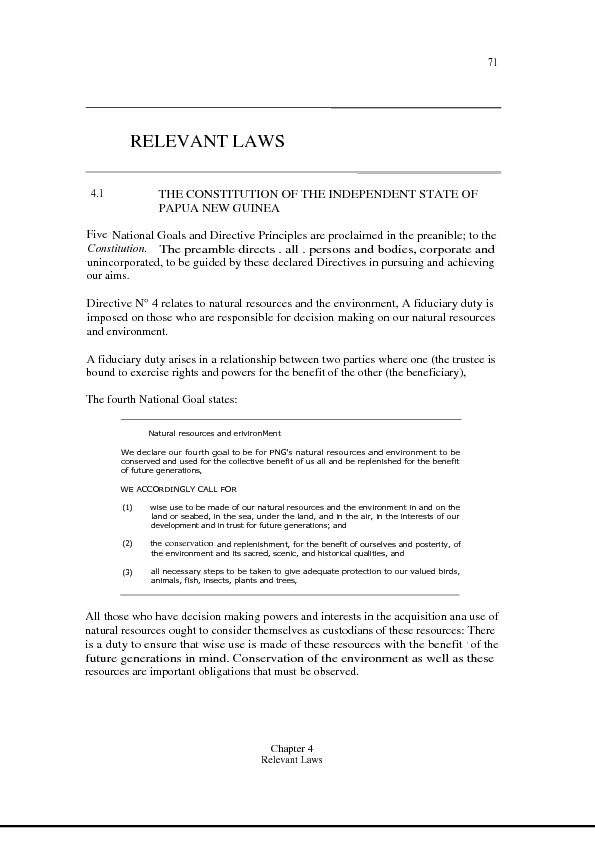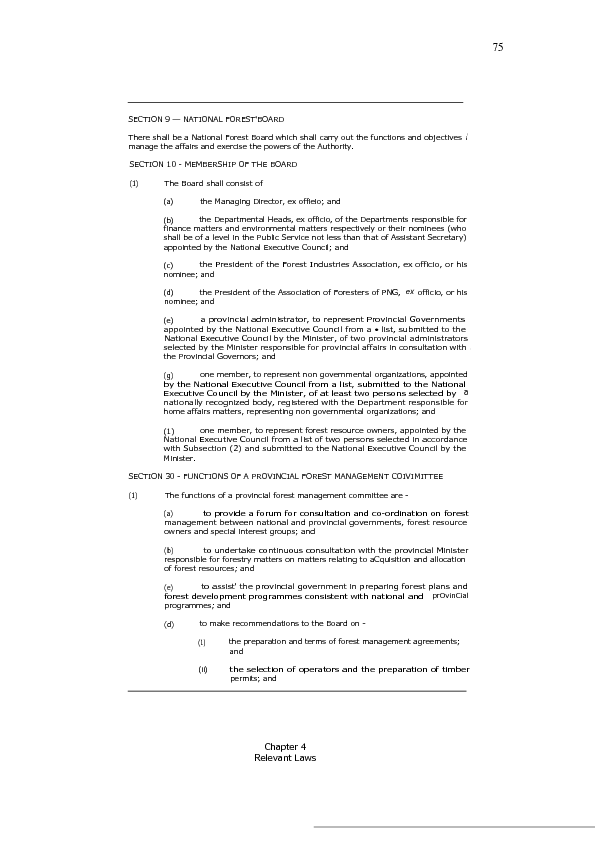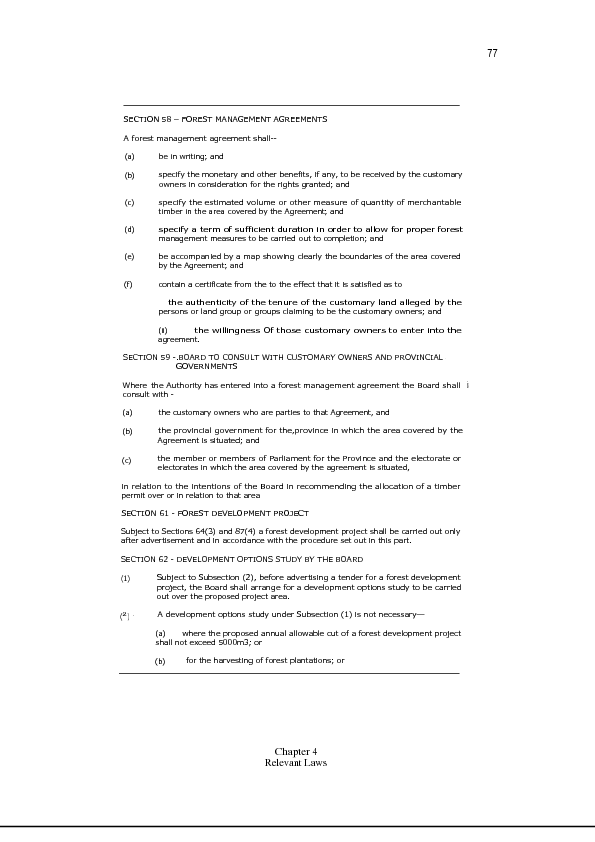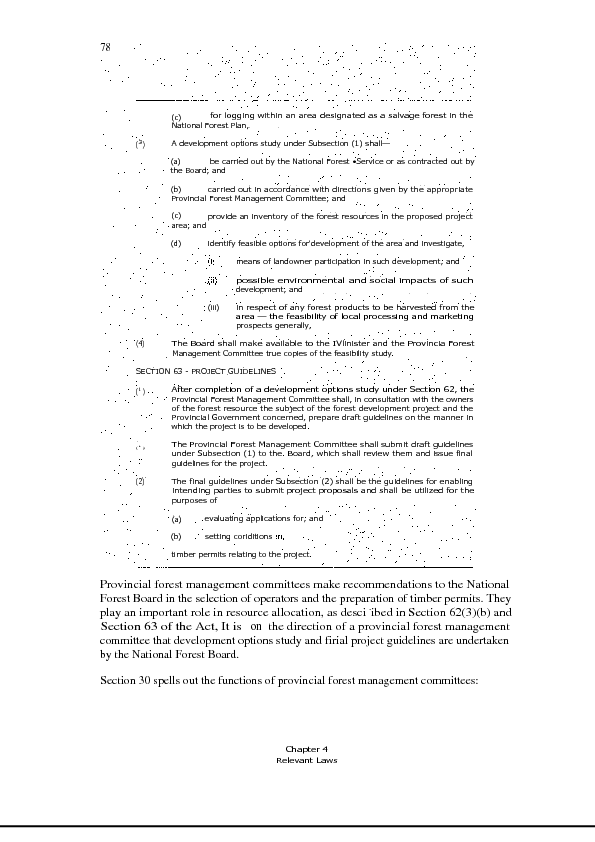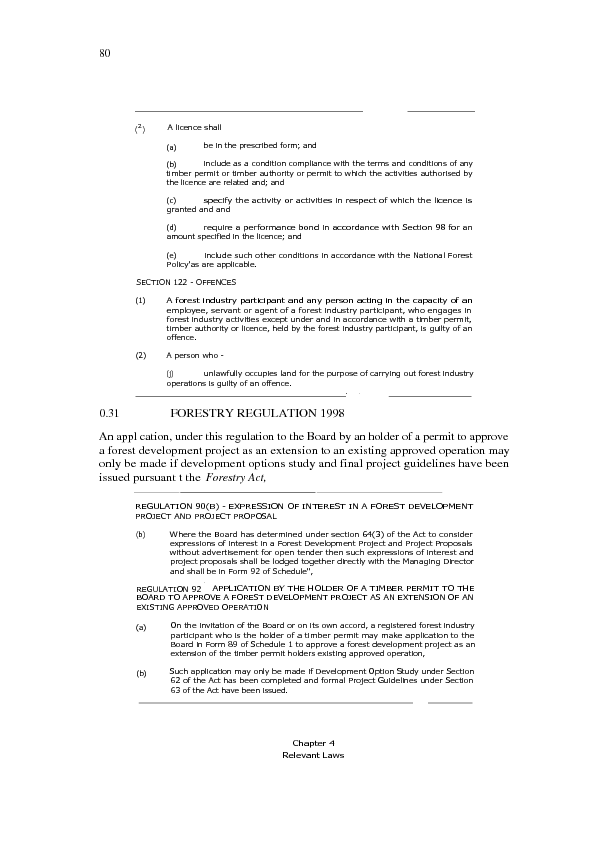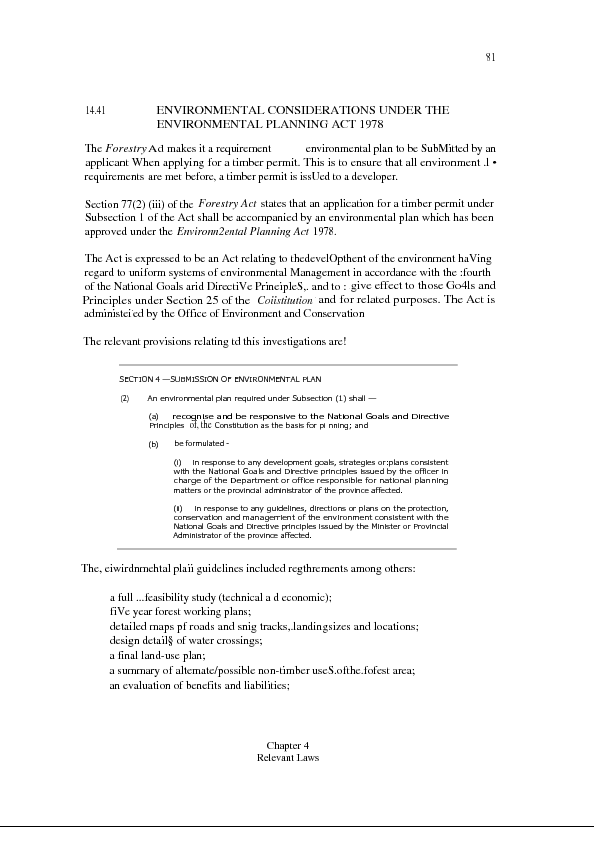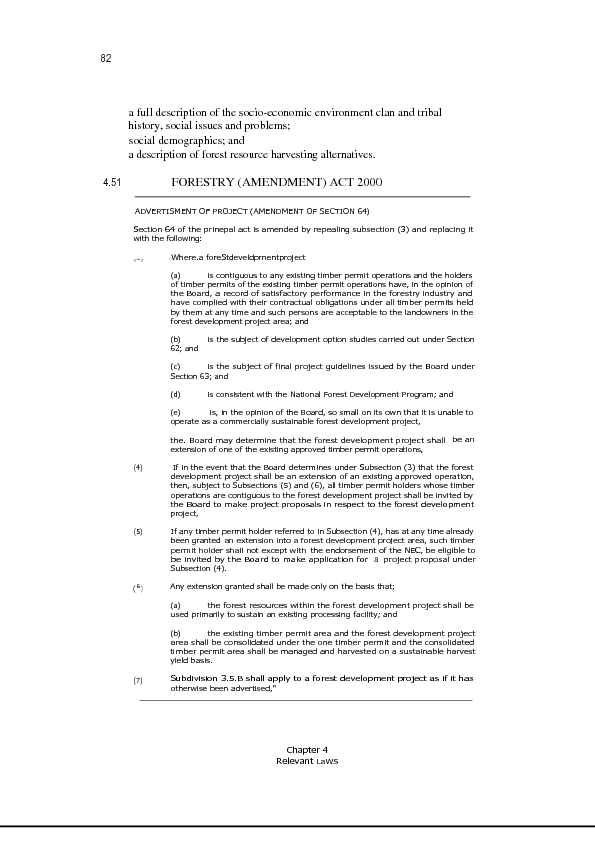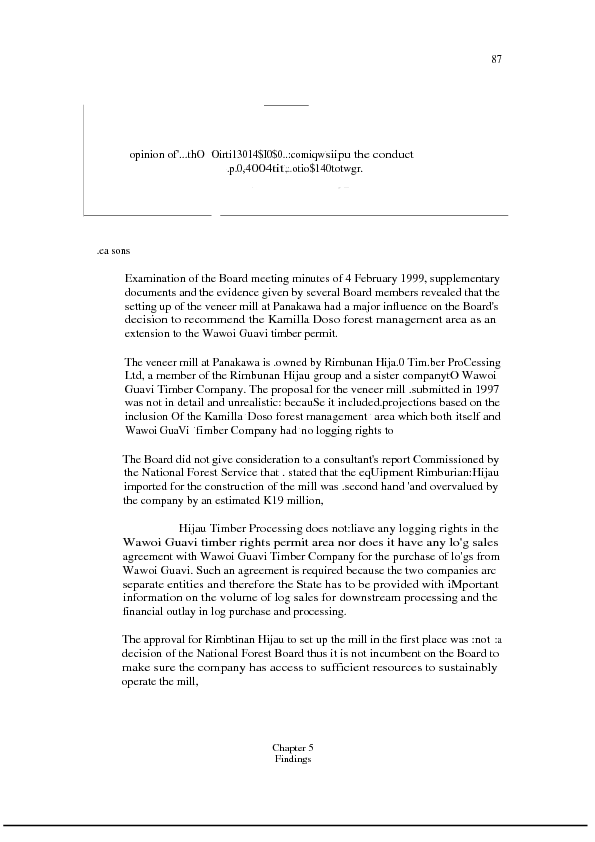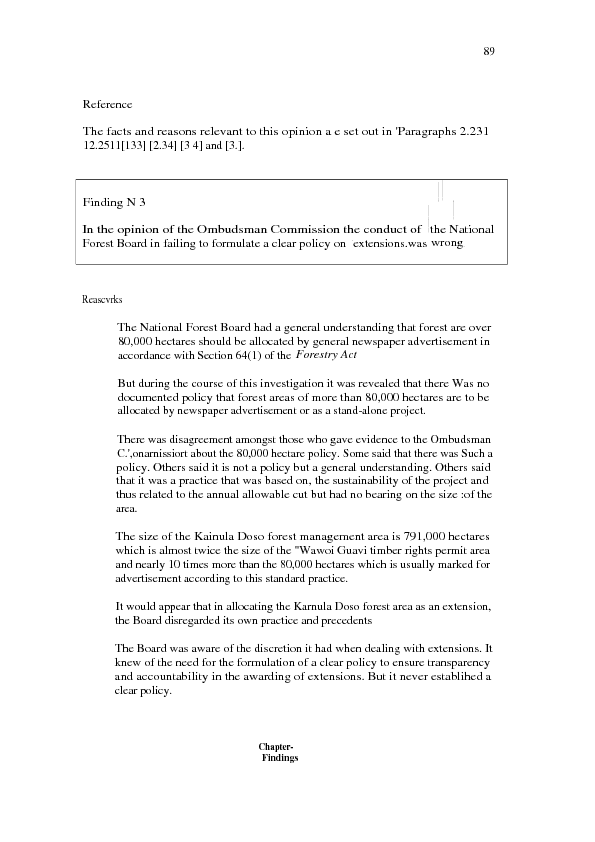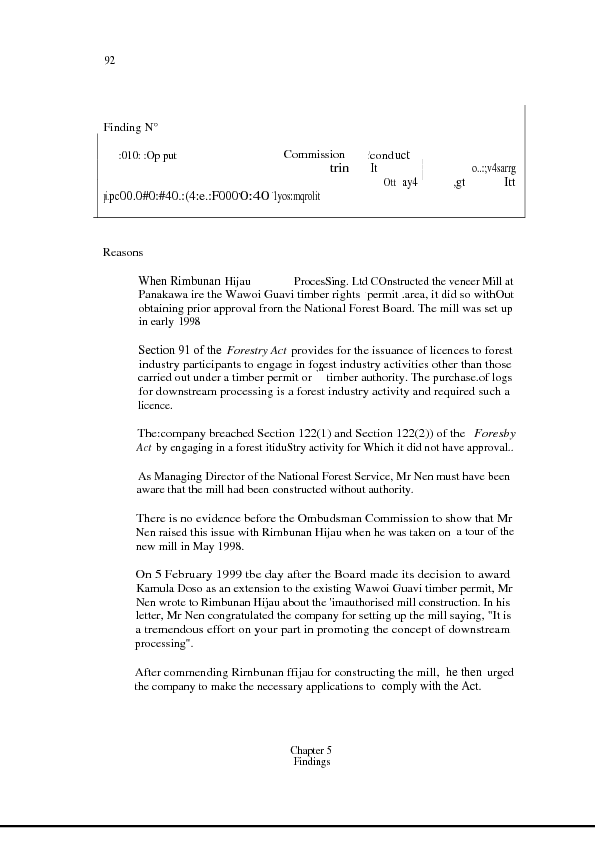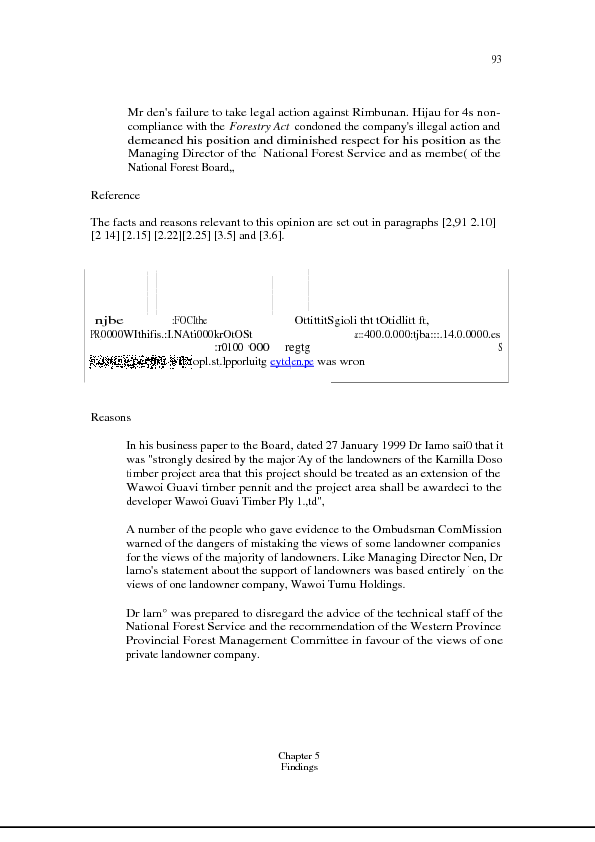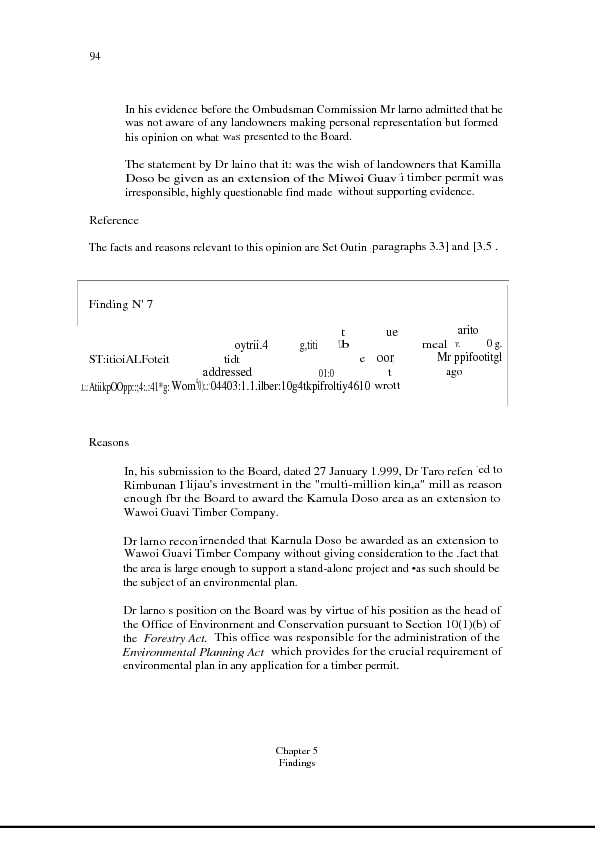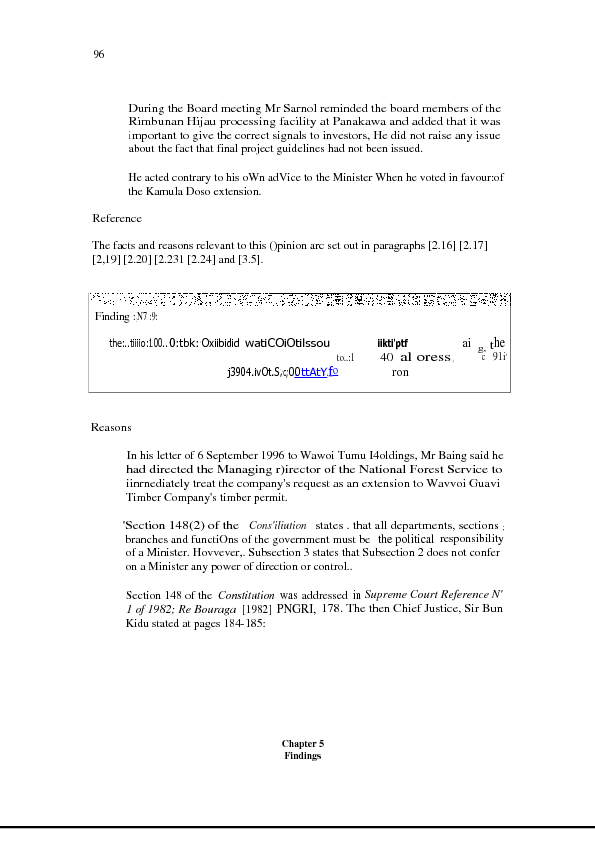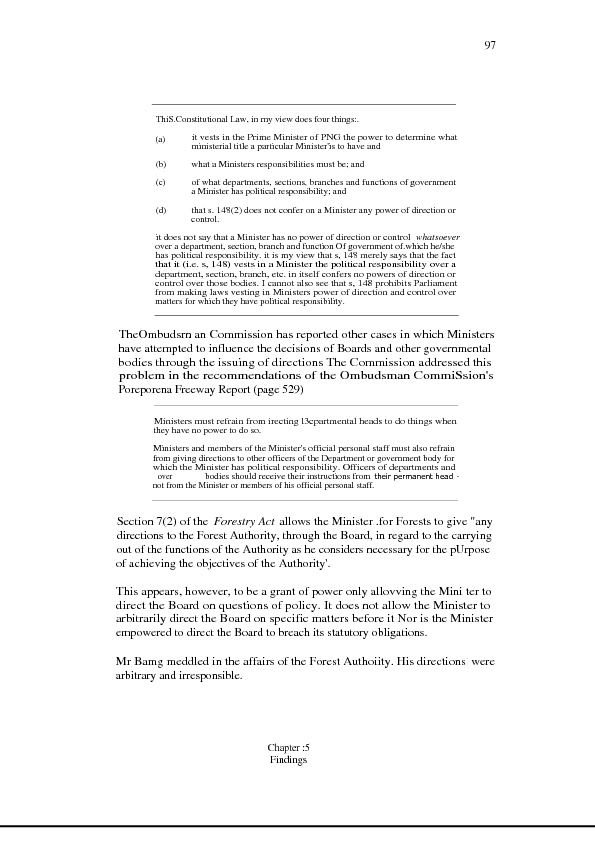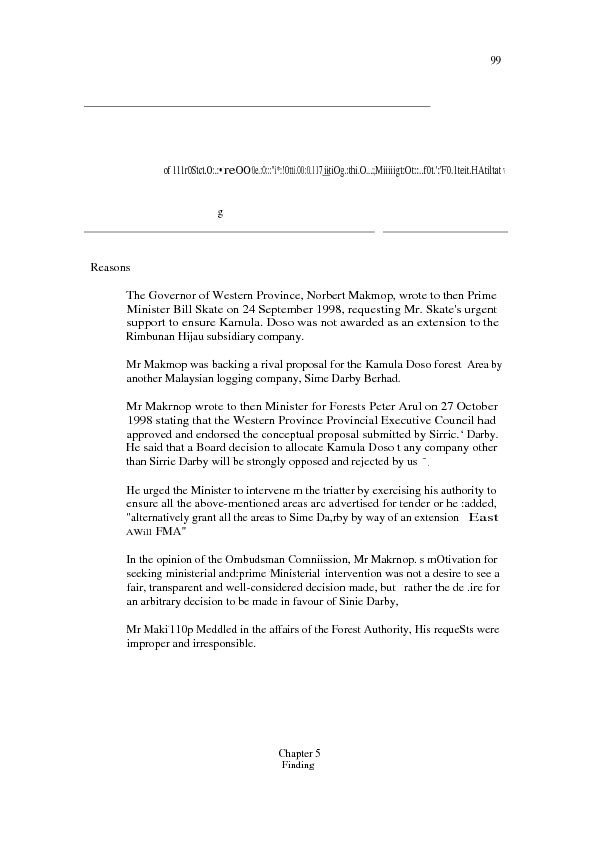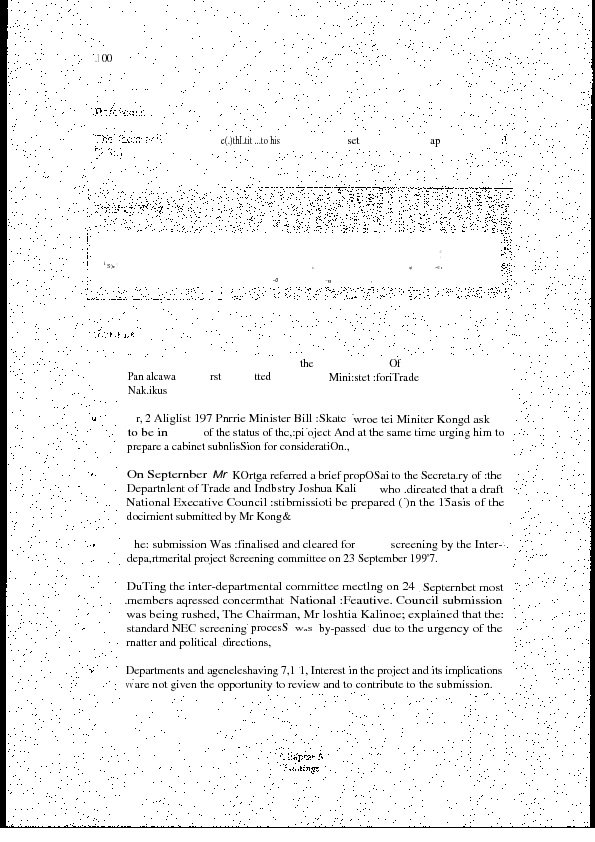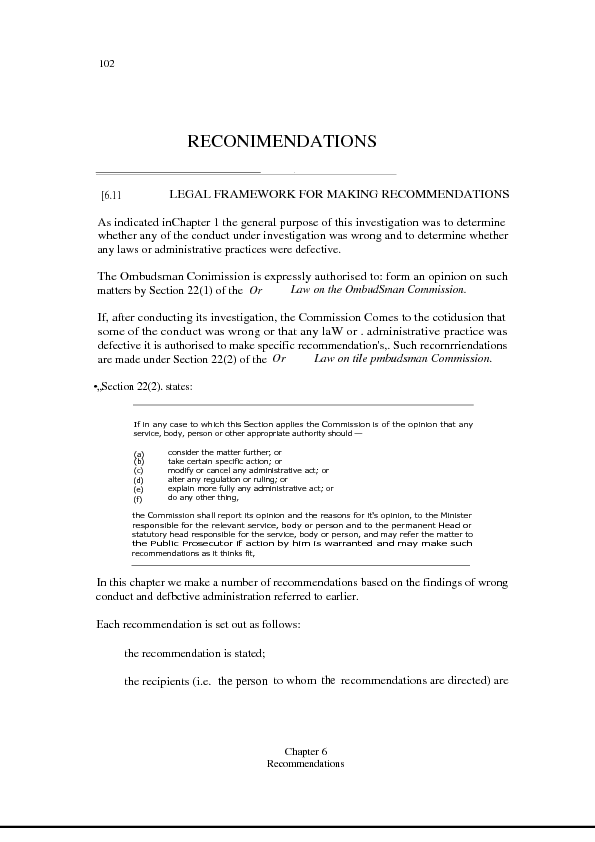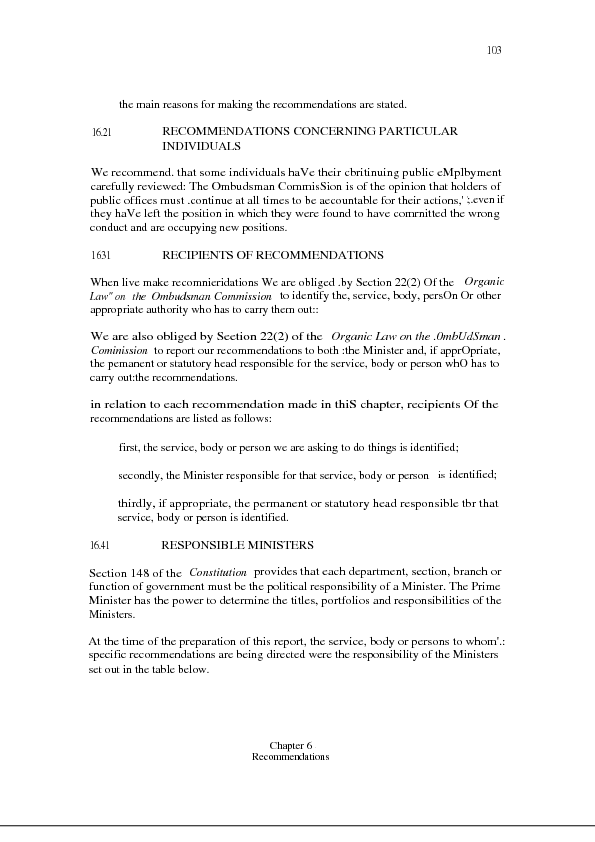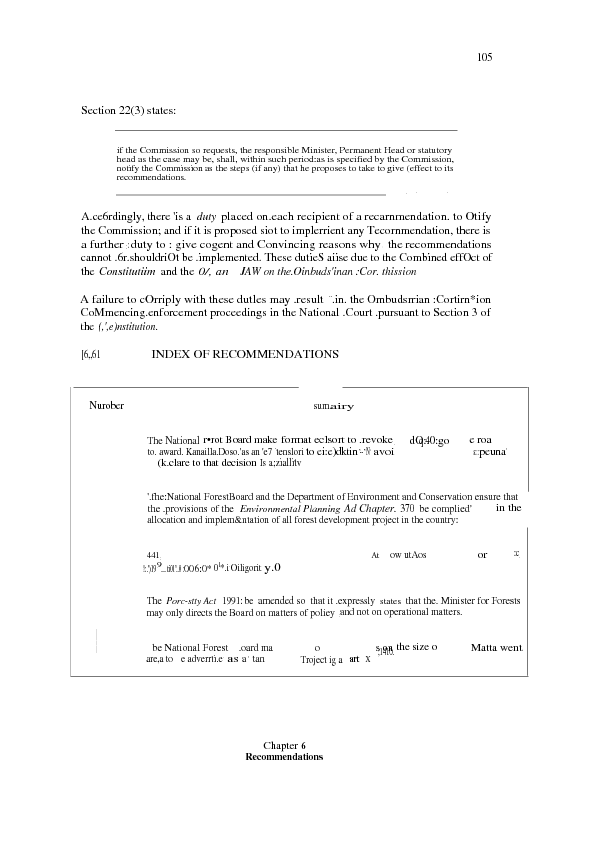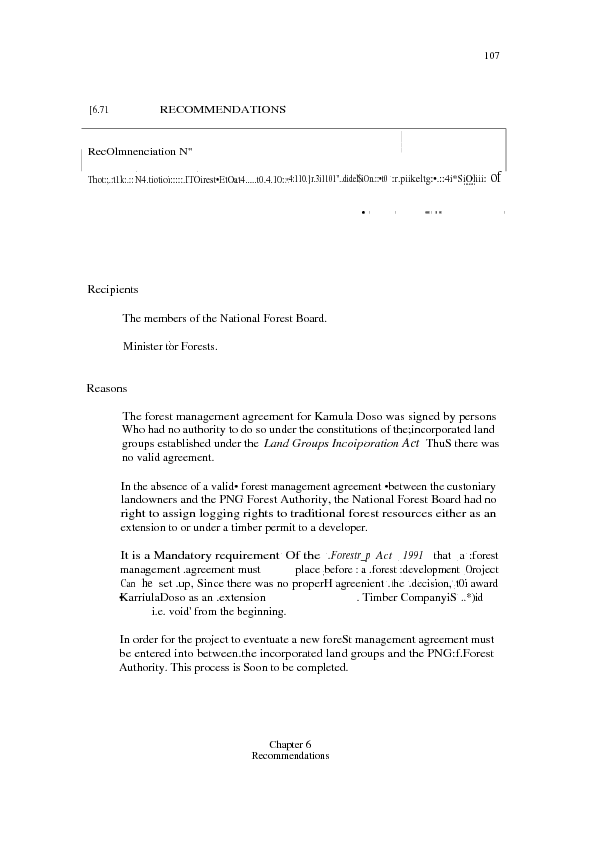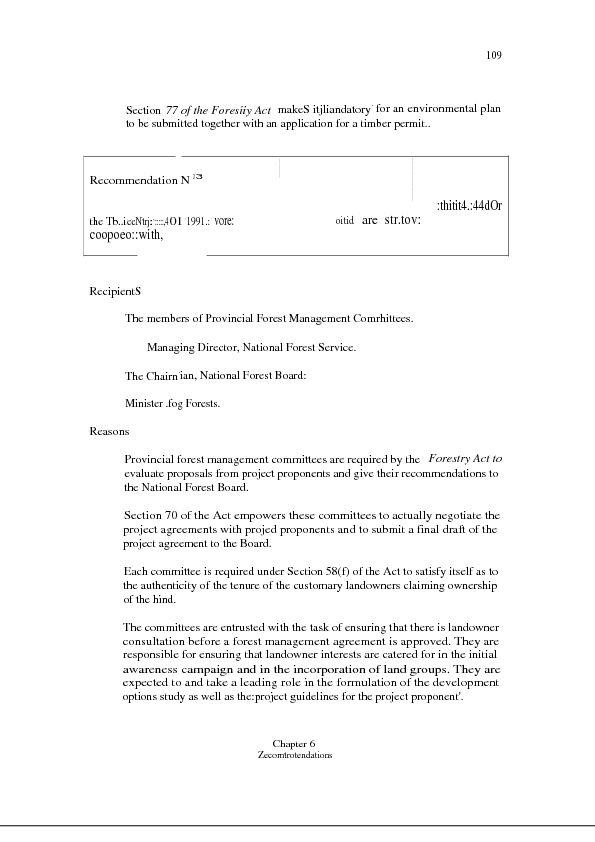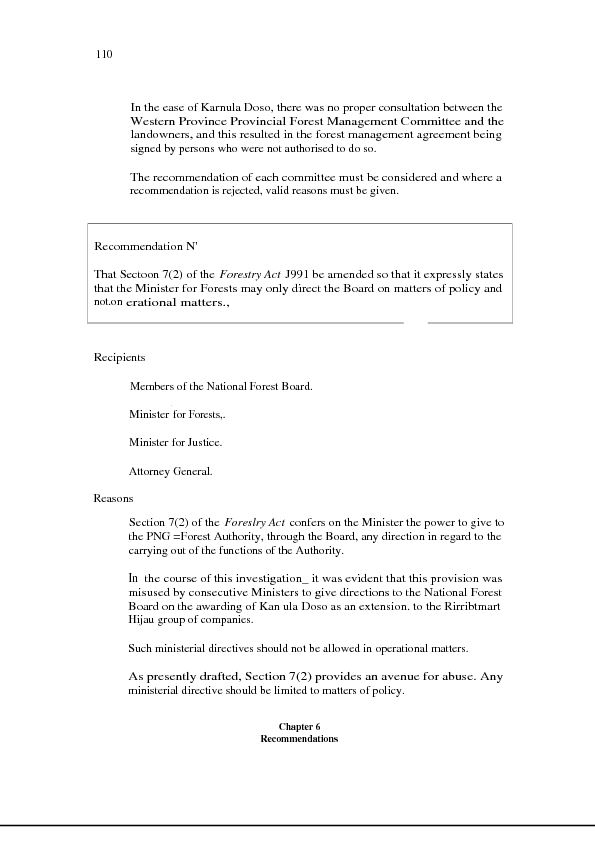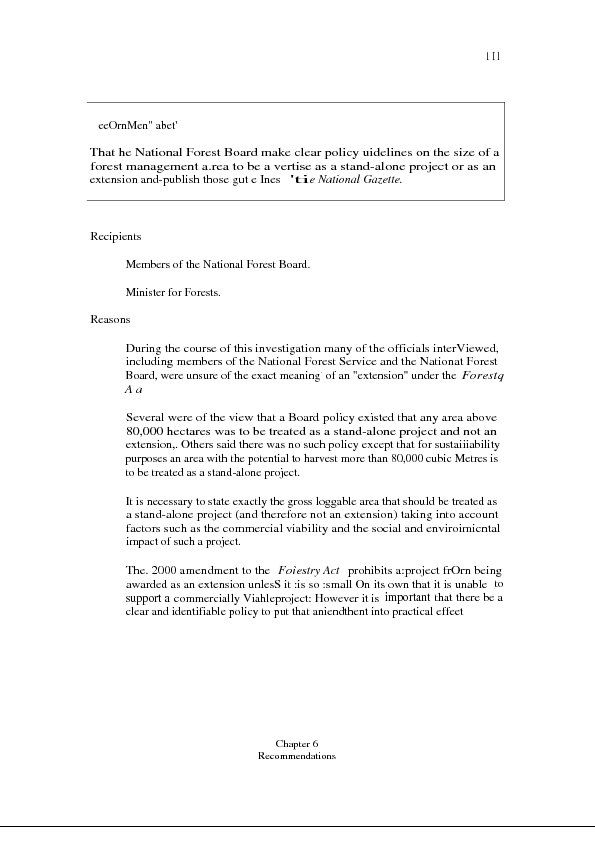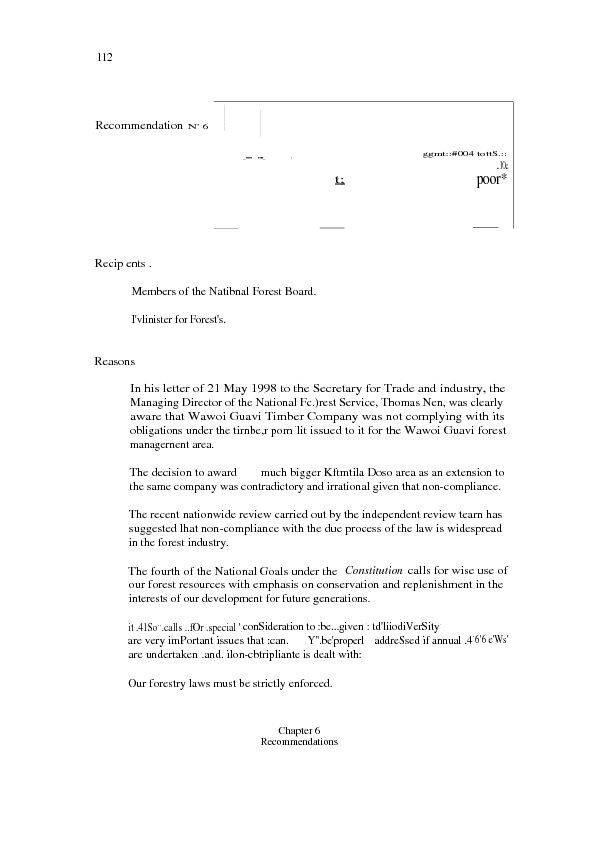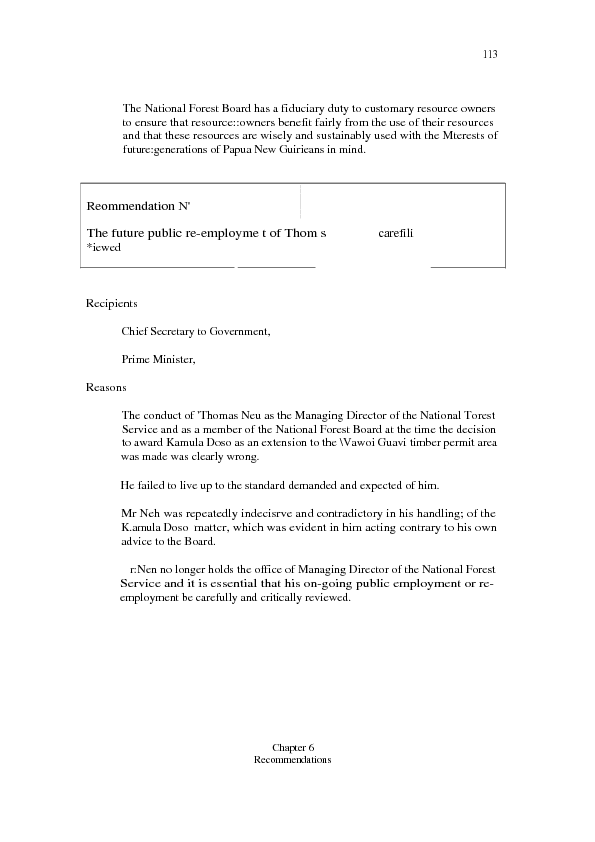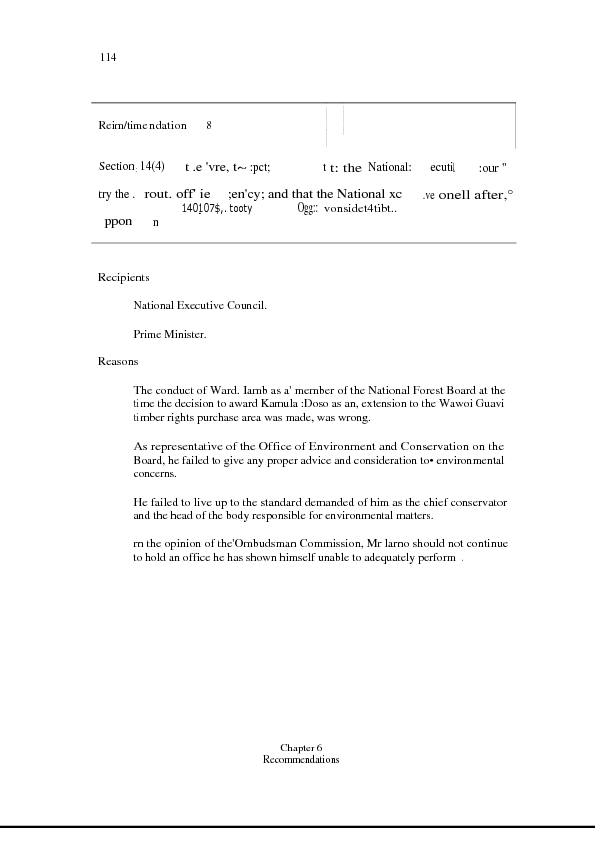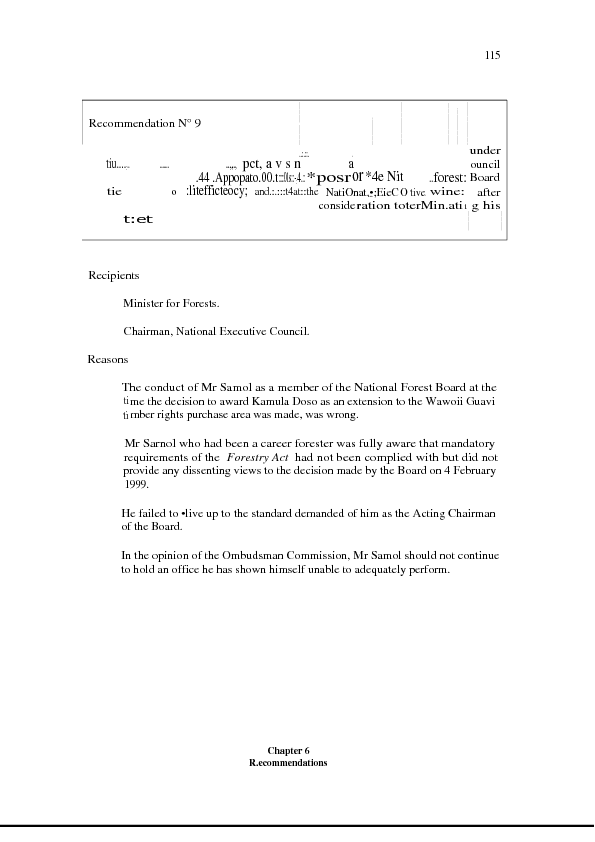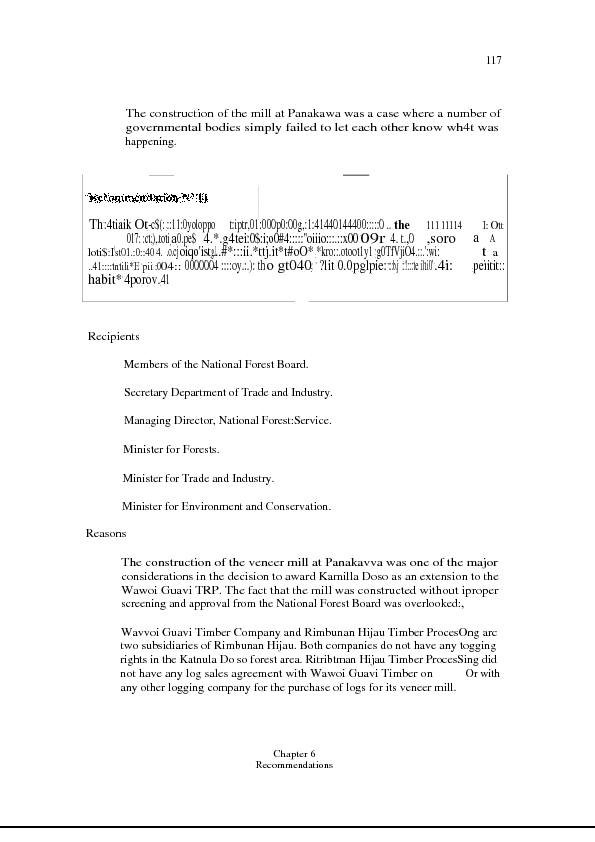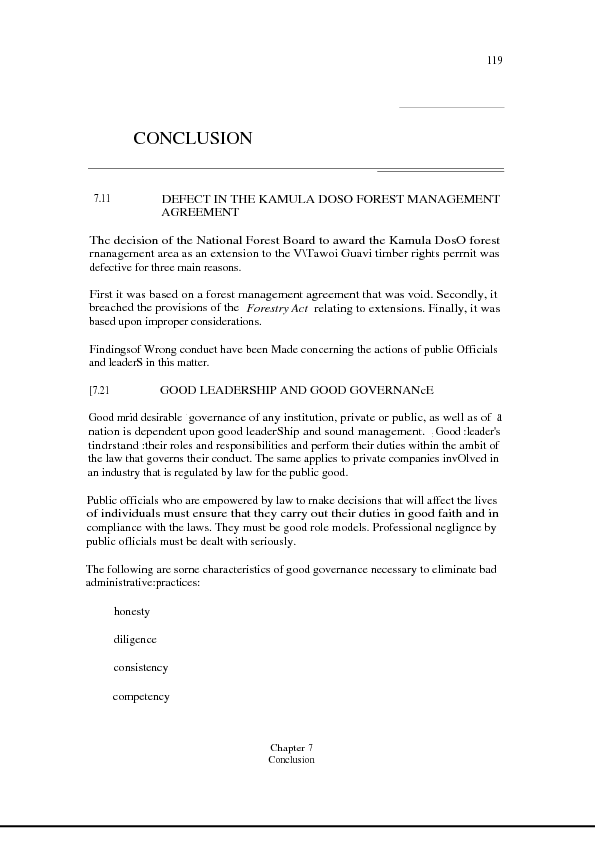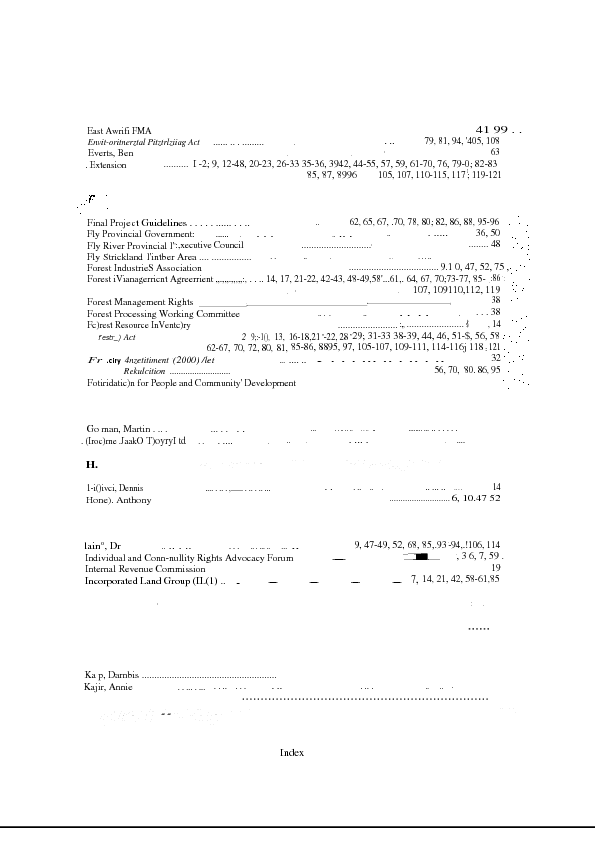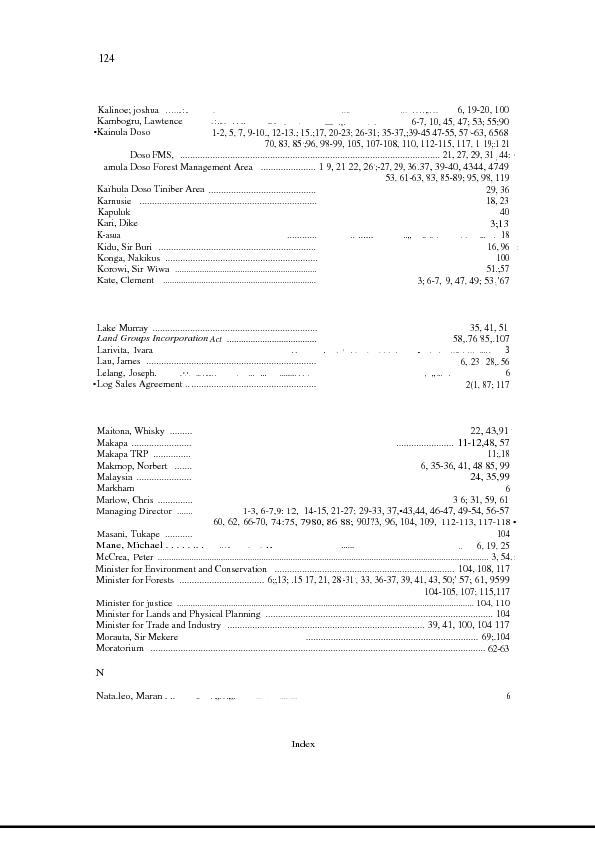Investigation into a Decision of the National Forest Board to Award Kamula Doso to Wawoi Guavi Timber Company (a subsidiary of Rimbunan Hijau)
Mentions of people and company names in this document
It is not suggested or implied that simply because a person, company or other entity is mentioned in the documents in the database that they have broken the law or otherwise acted improperly. Read our full disclaimer
Document content
-
OMBUDSMAN COMMISSION OF PAPUA NEW GUINEA
INVESTIGATION INTO
A DECISION OF THE NATIONAL FOREST BOARD TO AWARD
KAMULA DOSO TO WAWOI GUAVI TIMBER COMPANY (A SUBSIDIARY OF RIMBUNAN HIJAU)
AS AN EXTENSION TO THE WAWOI GUAVI TIMBER RESOURCE PERMIT
FINAL REPORT JULY 2002
-
Page 2 of 142
-
The Ombudsman Commission dedicates this report to:
All the resource owners of this country who are the rightful beneficiaries in the forest agreement between the state and foreign developers but who often end up getting less than the best
Public officials and leaders who are placed in positions of trust as custodians of our forests and other natural resources, whose decisions affect not only the present but also the future generations of this country
-
Page 3 of 142
-
111
EXECUTIVE SUMMARY
Overview
This is the final report of an investigation into the decision of the National Forest Board to award the Kamula Doso forest management area in the Western Province as an extension to the existing Wawoi Guavi timber rights permit.
The Wawoi Guavi timber rights permit has been held by the Rimbunan Hijau group of companies since 1992, The Board’s decision gave Rimbiman Hijau access to Kamula Doso, an area almost double the size of the area of its existing permit. The decision aroused widespread concern as by treating Kamula Doso as an extension, the advertising requirements of the Forestty Act were bypassed.
This report focuses on the propriety of that decision, in particular the considerations taken into account by the National Forest Board when it made its decision.
Principal findings
The forest management agreement entered into between the Kamilla Doso landowners and the PNG Forest Authority was void because of non- compliance with the Forestry Act;
the decision to award the forest management area as an extension was based on improper considerations;
the conduct of certain members of the Board and consecutive Ministers for Forests was wrong;
in reaching its decision the National Forest Board placed undue weight.on the fact that the Rimbunan Hijau group of companies had built a veneer processing facility at Panakawa, Western Province;
the National Forest Board was aware that Rirribunan Hijau had neither applied for nor had it been granted a licence under Section 91 of the Forestry Act 1991 to build or operate the mill;
Executive Summary
-
Page 4 of 142
-
the general attitude of the Board when it reached the decision was to give the correct signals to investors for economic reasons.
Irregularities
There were many irregularities surrounding the National Forest Board decision of 4 February 1999:
when the decision to award Kamula Doso as an extension to the Wawoi Guavi rights permit was made on 4 February 1999, the forest management agreement in place was defective and void;
the National Forest Board was aware that Wawoi Guavi Timber Company was not complying with its contractual obligations under the Wawoi Guavi permit but went ahead to award the company the 700,000 hectares Kamula Doso forest management area as an extension;
at the time of the decision, development options studies as well as the final project guidelines for the project which were necessary pre-requisites to an extension under Section 64(3) of the Forestry Act were not finalised;
despite the recorrimendation of the Western Province Provincial Forest Management Committee to advertise the project as a stand-alone p’roject the Board went ahead to award it as an extension to the Wawoi Guavi timber rights permit
Wrong conduct
The conduct of the following public officials was wrong:
the Managing Director, National Forest Service, Mr Thomas Nen;
Director, Office of Environment and Conservation, member of the National Forest Board, Dr Wari lama;
member of the National Forest Board, Mr Gabriel Samol;
Minister for Forests, Mr Andrevv Baing;
a subsequent Minister for Forests, Dr Fabian Pok;
Governor of Western Province, Mr Norbert Makmop.
Executive Summary
-
Page 5 of 142
-
Recommendations
The National Forest Board make a formal decision to revoke its decision of 4 February 1999 to award Kamula Doso as an extension to the existing Wawoi Guavi timber rights permit and declare that earlier decision :a nullity;
the National Forest Board and the Department of Environment and Conservation ensure that the provisions of the Environmental Planning Act Chapter 370 be complied with in the allocation and implementation’ of all forest development projects in the country;
all’provincial forest management committees ensure that their duties under the Forestry Act 1991 are strictly and diligently complied with;
the Forestry Act 1991 be amended so that it expressly states that the Minister for Forests may only direct the Board on matters of policy and not on operational matters;
the National Forest Board make clear policy guidelines on the size of forest management areas to be advertised as a stand-alone project or as an extension;
the National Forest Board undertake annual reviews of all logging operations in the country to ensure full compliance with contractual obligations and to carefully screen future applications from defaulting companies;
the future public re-employment of Thomas Nen must be carefully and critically viewed;
the National Executive Council give written notice to Wart Iamo under Section 14(4) of the Forest”); Act, advising that the NEC intends to terminate his appointment as a member of the National Forest Board on the ground of inefficiency;
the National Executive Council give written notice to Gabriel Samot under Section 14(4) of the Forestry Act, advising that the NEC intends to terminate his appointment as a member of the National Forest Board on the ground of inefficiency;
coordination between departments and other governmental bodies be markedly improved to ensure necessary compliance with all requirements relating to proposed forest projects;
Executive Summary
-
Page 6 of 142
-
vi
present projects and future proposals by the Rimbunan Hijau group of companies be carefully audited and monitored to ensure that all legislative requirements pertaining to forest industry activities are strictly complied with; and that all future proposals by that group of companies be critically screened before approval.
Conclusion
At the time of this report amendments have been made to the Forestry Act 1991 the effect of which is that a decision such as the one made on 4 February 1999 by the National Forest Board is now prevented.
The Ombudsman Commission, however remains concerned that the Board seriously violated the Forestry Act.
Any future allocation of Kamilla Doso must comply with the provisions of the Forestry Act as amended in 2000. The Act now requires all forest development projects to be advertised for tender. They can only be awarded as an extension where the area is so small on its own to sustain a stand-alone project. The Kamilla Doso forest management area must now be allocated through advertisement.
Executive Summary
-
Page 7 of 142
-
VI 1
CHRONOLOGY
1996
May 21 Wawoi Guavi Timber Company writes to Managing Director of the National Forest Service saying they had been approached “by the forest resource owners to develop their land”.
Jul 11 Wawoi Turnu Holdings writes to Minister for Forests, Andrew Baing,
Aug 12 Baing replies to Wawoi Tunau Holdings, stating Kamilla Doso would not be logged until 1998 or 1999:
Sep 6 Baing writes to Wawoi Turnu Holdings stating he has directed that the project be developed as an extension to commence that year
1997
Aug 21 First Rimbunan Hijau submission to Mr Konga for veneer proeessing in Kamusie, Western Province,
Aug 29 Prime Minister Skate writes to Mr Kongo requesting report on status of project, Minister to prepare Cabinet submission for consideration.
Sep 1 Konga referred brief proposal to Department of Trade and Industry. Secretary Kalinoe directs preparation of draft National Executive Council submission based on the proposal.
Sep 19 Department of Trade and Industry prepares brief on status of project proposal for Skate.
Sept 23 National Executive Council submission finalised and cleared for final screening by Inter-departmental project screening committee.
Sep 24 Committee meeting. Kalinoe advises that submission finalised an forwarded to National Executive Council Secretariat.
Sep 25 National Executive Council Decision No. 41/97 approves project (veneer mill) in principle.
Chronology
-
Page 8 of 142
-
vii i
Oct 15 Department of Trade and Industry receives letter from Rimbunan Hijau enclosing another list of equipment for the project.
Oct 26 Trade and Industry writes to Office of the Legislative Cotmsel to clear second list.
Nov 4 Wawoi Tumu Holdings writes to the nom Minister for Forests, Fabian Pok.
No 20 Managing Director Zureriuoc informs Wawoi Tumu Holdings that allocation of Kamula Doso would be done by the PNG Forest Authority in consultation with the Western provincial forest management committee and the landowners.
Nov 28 Inter-departrnental project screening committee met to consider the second submission.
Dec11-12 Trip by inter-departmental delegation to veneer mill project site in Western Province.
1998
Earl) Jan Another National Executive Council submission rejected because i t lacked detailed information.
Feb Thomas Nen becomes Managing Director of National Forest Service.
Feb 1 PNG Forest Authority approves the forest management agreement for Kamula Doso.
Jan 18 Second visit to the mill site by technical officers of Department of Trade and Industry.
Mar 16 Second submission on the veneer mill project finalised and submitted to the National Executive Council.
Mar 21 Wawoi Turnu Holdings writes to Nell concerning Kamiula Doso.
April 7 National Executive Council Decision No 79/98 approving tax and other exemptions on Panakawa mill.
Apr 16 Western Province provincial forest management committee meeting (2/98) Dam, Western Province.
Chronology
-
Page 9 of 142
-
Apr 24 Nen writes to Wa.woi Tumu Holdings seeking its preference for allocation of Karnula Doso.
May 4 Rimbunan Ilijau assistant general manager writes to National Forest Service, advising that construction of mill is at advanced stage. Invites senior managers to visit the mill.
May 18 Wawoi Turnu Holdings writes to Nen expressing.preference for WaWoi Guavi Timber Company as developer of Kamula Doso.
May 21 Nen writes to Secretary of Department of Trade and Industry regarding Rimbunan Hijau’s draft’project proposal for the Panakawa mill.
May 22 Nen writes to Wawoi Tumu Holdings confirming preference of landowners for Wawoi Guavi Timber Company as developer of Kamula Doso.
May 26 Nen writes to Wawoi Guavi Timber onPan t. o submit application for an extension for Kamula Doso.
May 30 Nen and three National Forest Service officers accept Rimbunan Hijau invitation and visit veneer mill plant site
Jun 11 Wawoi Guavi Timber Company writes to Chairman of National Forest Board requesting that Karnula Doso forest management area be allocated to it as an extension to Wawoi Guavi timber permit.
Jul Guidelines for the preparation of a revised veneer mill proposal.
Jul 14 Minister Pok writes to National Forest Boa.rd Chairman directing Board to consider allocating Kamula Doso as an extension to Wawoi Guavi Timber Company.
Jul 27 National Forest Board meeting. Minister’s letter discussed.
Jul 30 Samol writes to Pok, in reply to the Minister’s letter of 14 July saying development options study and project guidelines must first he complied with
Jul 30 General Counsel to the National Forest Service, Chris Marlow advises Director of the Service’s Policy Secretariat on legal requirements – relating to extensions.
Chronology
-
Page 10 of 142
-
Cabinet reshuffle. Peter Arid becomes new Minister For Forests.
Jaako Poyry consultants inspects mill site with Forest Minister, Managing Director of National Forest Service and representatives of Department of Trade and industry. •
Nen’s second letter to Department of Trade and Industry expressing concern about veneer project.
Governor of Western Province, Norbert. Makmop, writes to Nine Minister Skate about Karnula Doso.
Arul writes to Acting Chairman of the National Forest Board Gabriel Samol requesting a brief on the situation regarding the Kamilla Doso forest management area.
Samol responds to Artirs letter.
Makmop writes to Arul. stating Western Provincial Executive Council endorses Sime Darby Berhad for East Awin, Lake Murray and Kamula Doso forest management areas in Western Province.
Nen’s business paper on Rimbunan Hijau plywood mill at Panakavva submitted for the National Forest Board tneeting in October 1998.
Anthropologist Michael Wood writes to Chairman of National Forest Board, Samol.
Samol replies to Wood, questioning his involvement with Kamilla Doso landowners.
Nen writes to landowners Olaba Tau and Whisky Maitoria, mdicating disagreement between landovvners in the choice of the developer.
National Forest Service brief signed Forests.
Submission to the chairman arid members of the Board by Dr Tarno.
National Forest Board decision to award Kamilla Doso forest management area as extension to the Wawoi Guavi timber permit.
Chronology
-
Page 11 of 142
-
Feb 5 INTen writes to Rimbunan Hijau urges company to apply for licences under the Forestry Act for the mill.
2000
May 18 National Executive Council Decision No 84/2000 – Moratorium on logging.
Dec 4 Clement ‘Cote responds to preliminary report.
Dec 18 Samol responds to prelin -iinary report.
Dec 18 Baing responds to preliminary report.
Dec 27 Nen responds to preliminary report.
2001
Jan 4 Marlow responds to preliminary report.
Jan 29 Forestry Arnendment Act 2000 is certified.
Feb 2 Maktnop responds to preliminary report .
Feb 15 Tam° responds to preliminary report.
Aug 10 Michael Mane respond to preliminary report.
Aug 27 Rimbunan Hijau responds to preliminary report.
2002
Feb 4 Wawoi Guavi timber permit extended for 10 years until 2012.
Chronology
-
Page 12 of 142
-
AAC Annual Allowable Cut
DOS Development Optrons Study
DTI Department of Trade and Industry
FMS Forest :Management Agreement
ICRAF Individual and Community Rights Advocacy Fomm
ILG incorporated Land Group
MP Member of Parliament
NEC National Executive Council
NFB National Forest Board
NTS National Forest Service
OEC Office of Environment and Conservation
PFMC Provincial Forest Management Committee
P. Papua New Guinea
PNGFA Papua New Guinea Forest Authority
RH Rimbunan Hijau
TRP Timber Resource Permit
WGTC Wawoi duavi Timber Company
WTI-I Wawoi Tumu Holdings
-
Page 13 of 142
-
TABLE OF COIN TENTS
JURISDICTION AND PURPOSE OF INVESTIGATION ………. •INTROI)UCTION …………………………………………………………………………………………………………• ‘JURISDICTION OF .”TITE OMBUDSMAN COMMISSION 1 PUR.I3 OSE . OF THE INVESTIGATION•• . • • •-• • • •• • • • • .• .• • .. • . . METHOD OF INQUIRY ………………………………………………………………….. 2•• • IN CONDUCTED DURINGTHEINVESTIGATION ••• 3 .• 0IVIIIUDSMAN COMMISSION NOT CONFINED TO :REPORTING Y…. ON LEGALITY OF ADMINISTRATIVE’ .. . .. . ….. .. . . . . DEFINING WRONG CONDUCT • •.• •• • •. • • • ••: •••”.. …; THE PRELIMINARY RFPORT. . . …. … . . . . • . . • . .. . .4 •.• : •GEN ERAL OB S ERVATIONS AND •CRITICISMS • ••. • • •••• …. ..6
EVENTS PRIOR TO THE BOARD DECISION ……. 9 2.1 . • GENERAL- . ••’ 2.2 . . ‘ WAWOI GUAVI TIMBER •RIGHTS PERMIT •’••-: • 2.3 t HE PROVINCIAL FOREST MANAGEMENT .PLAN ………………………………………………. 10• 24 WAWOI GUAVI EXTENSION • • :•• •••• •• 2.5 …LETTER FROM . LANDOWNERCOMPANY TO THE MINISTER • 2.6 … ANDREW BANG’S REPLY TO WAWOI .TUMU HOLDINGS • ••. • 2.7 ….WAWO.TGUAVI EXTENSION RECEIVES MINISTERIAL BACKING ..••• •.’ • . .1 4 2.8 ..ANDREW BANG RECEIVES INFORMATION ABOUT RIMBUNAN . HUALT :•. • •.; AND•WAWOI.GUAV1 • • •-• • .• • … • • • • • • ‘ ….• • • . :
2.9 •• N KTIONAL ..EXECUTIVE . COUNCIL.•APPROVAL’FOR:RIMBUNAN •HLIALT . . PROCESSING ,FACILITY AT …… …. .•. .. . . .. . ……………………… . 2.10 ‘ . I.)EPARTMENT OF TRADE AND INDUSTRY’S ..ROLE . • . . …. .. 2A 1 . . WAW01 TUMU HOLDINGS WRITES TO .DR.FABIAN..POK • •.• • .:: • 21 2.12 1 HE ..FOREST MANAGEMENT AGREEMENT IS EXECUTtD’.• •.• • 2.13 . .: THOMAS NEN TAKES OVER AS :MANAGING DIRECTOR • .:’ 0F . THE NATIONAL FOREST ..SERVICE: • •• • • • , 22• . 2.14 VISIT 10 RIMBUNAN HIJAT.PS VENEERMIT.I.SITE . ………………………………. • . 23 „. 2.15 LE [I THOMAS NEN TO THE SECRETARY OF THE • DEPARTMENT OF TRADE AND INDUSTRY…. : ••• • • ….• .;.•: . . THOMAS NE,N’S LETTER TO .WAWOI TUMU HOLDINGS’ • • 26 …• • KAMULA.DOSO FOREST MANAGEMENT AREA AS WAWOI ………… .• GUAVI EXTENSION ••• . .;• 27 • . . . OFFICIAL REQUEST FROM WAWOI GUAVI TIMBER COMPANY FOR AN . . EXTENSION TO THEIR EXISTING •PERMIT • .• •. • . • • • . .28 …. …. 2.19 DR P0K WRITES TO THE .CHAIRMAN OF •THEBOARD • 28 2.20 …:.NATIONAL .FOREST BOARD MEETING N° 49 • •.’ • • . • • • •• • 1 • . 29 2.21 . • • … THE MANAGING DIRECTOR’S BRIEF TO THE BOARD ON DOS() FOREST MANAGEMENT AREA … . .. .. … . … …. . .•. …………………. .. • THE MANAGING DIRECTOR’S BRIEF TO THE BOARD ON .RIMBUNAN •. HLIAU’S ,ACTIVITIES IN ‘PNG • ••-.. • • • • .• .. • • • 2.23 REPLY SENT TO THE MINISTER. ON 30 .. . . . . …. . . MIN-LITE FROM NATIONAL FOREST ‘SERVICE GENERAL COUNSEL … • .• .„ . TO – DIRECTOR.OF.THE POLICY SECRETARIAT • .. • . • .. • iL • .:.31.•: •
Table of Contents
-
Page 14 of 142
-
xiv
2.25 REPORT ON VENEER.PRODUCTION EQUIPMENT ………………………………………………• .33 .
2.26 GOVERNOR OF WESTERN PROVINCE WRITES TO THE PRIME ‘MINISTER ………………………………………………………………………….. •. .35 2.27 PETER ARIA., BECOMES MINISTER FOR FORESTS • …………………………………….. 36 2.28 .GABRIEL SAMOL WRITES BACK TO THE MINISTER ………………………………. 37 2.29 BUSINESS PAPER ON RIMBUNAN HIJAU MILL ………………… 37 2.30 NORBERT MAKMOP TELLS THE MINISTER FOR FORESTS ANY :COMPANY OTHER THAN SIM E DARBY WILL.BE OPPOSED ……………………..• 41. 2,31 ANTHROPOLOGIST MICHAEL WOOD WRITES .TO THE CHAIRMAN OF THE BOARD …………………………….. 41 . • 2:32 THOMAS NEN WRITES TO LANDOWNERS ………………………………………………………. 43 2,33 BRIEF10 THE MINIST.ER OF FORESTS FROM THE MANAGING • DIRECTOR OF THE NATIONAL FOREST SERVICE …………………………………………….. 43 2.34 THE 80,000 I .IECTARES/CUBIC METRES POLICY,. ……………………………… 44
3. BOARD DECISION AND AFTERMATH …………………………………………….. 47 3,1 GENERAL …………………………………………………………….. 3.2 THE BOARD MEMBERS ………………………………………………………………………….. •. 47 3.3 SUBMISSION To THE BOARD BY DR WART TAMQ DIRECTOR OF THE OFFICE OF ENVIRONMENT AND CONSERVATION ……………………………….• 47 3A SUBMISSION TO THE NATIONAL FOREST BOARD BY MANAGING DIRECTOR THOMAS NEN ………………………………………………………………………………….• 49 3.5 . BOARD MEETING NI’ 54 OF 4 FEBRUARY 1999 ………………………………………. 51 • • 3.6 I MPACT OF THE VENEER MILL. ON THE BOARD’ &THINKING ………. 54 . 3.7 LETTER TO RIMBUNAN HIJAU ABOUTTHE VENEERPROCESSING MILL AT . PANAKAWA ………………………………………………………………………….. : 55 3.8 LETTER FROM SIR WIWA KOROWI TO MINISTER FOR FORESTS . PETER A.RUL ……:57 3.9 DOUBTS ABOUT THE LEGITIMACY OF THE ORIGINAL KA11/11JIA DOSO FOREST MANAGEMENT AGREEMENT ……………………………………………… 58 •3.10 • HAS TI IE BOARD’S DECISION OF 4 FEBRUARY 1999 BEEN IMPLEMENTED? ……………………………………………………………………………………………….. .59 : 3:11 ADVICE FROM THE NATIONAL FORD S1′ SERVICE GENERAL COUNSFI …………..61 . 3.12 . TIM MORATORIUM ON LOGGING …………………………………………………………………….. 62 • … 3.13 .THE INDEPENDENT FOR.ESTRY REVIEW ……………………………………………………. • 63 3.14 .THE INDEPENDENT REVIEW TEAM …….. • 63 3.15 THE INDEPENDENf REVIEW TEAM REPORTON KAMULA:DOSO • • 63 3.16 AMENDMENT TO SECTION 64(3) OF THE FORESTRY ACT …………………………….. 65 ” • . 3.17 RIMBUNAN EIDAU RESPONDS TO THE PRELIMINARY REPORT …………………….. 65 3.18 .RESPONSTS TO CRITICISM ON THE NATIONAL FOREST BOARD DECISION TO AWARD KAMULA.DOSO AS AN EXTENSION …………………… . . 66 3:19 ..RECENT DEVELOPMENTS ON KAIViUTA DOSO AND .WAWOI GUAVI .. .. …. .. 70 .• 3,20 MANAGING DIRECroR’S POSITION …………………………………………………………………. 70
4. RELEVANT ‘LAWS’ ; ;71 4.1 TIM CONSTITUTION OF THE INDEPENDENT STATE OF PNG ………………………. .71 4.2 FORESTRY ACT 1991 ……………………………………………… 72 4.3 FOR ESTRY REGULATION 1998 ………………………………………………………………………….. 80 4.4 ENVIRONMENTAL CONSIDERATIONS UNDER:THE ENVIRONMENTAL .
PLANNING ACT 1978 ………………………………………. H81 4.5 FORESTRY (AMENDMENT) ACT 2000 82
Table of Contents
-
Page 15 of 142
-
XV
5. FINDINGS OF WRONG CONDUCT ………………………………………. 84 5.1 STATUS OF FINDINGS „. . . .. , ..„ . _ , …. .,……-. 84 5.2 INDEX OF FINDINGS OF WRONG CONDUCT >, 85 5.3 FINDINGS ……,…. … ,… …… .. .,….’; 85
6. RECOMMENDATIONS ……………………………………………………… 102 6.1 LEGAL FRAME WORK FOR MAKING RECOMMENDATIONS ,’ 102 6.2 RECOMMENDATIONS CONCERNING PARTICULAR INDIVIDUALS ………….. , 103 6.3 RECIPIENTS OF RECOMMENDATIONS ………………………………………………… ‘ 103 6.4 RESPONSIBLE MINISTERS ………………………………….. 103 6.5 DU -FIES OF RECIPIENTS OF RECOMMENDATIONS 104 • 6.6 INDEX OF RECOMMENDATIONS ……………. ‘ 105 • 6.7 RECOMMENDATIONS ,,,,,…„..,…… ….. .,,…,. …. . . . … .. . . . … … … .. . ….. … , 107
7. CONCLUSION 119 •
• 7,1 DEFECT IN THE KAMUIA DOSO FOREST MANAGEMENT AGREEMENT 119 • • 7.2 GOOD LEADERSHIP AND GOOD GOVERNANCE ……………………………………….. 119 • 7.3 FIDUCIARY DUTY ………. 120 • 7.4 SUMMING UP ……………………………………………………………………………………………… 120
Table of Contents
-
Page 16 of 142
-
Page 17 of 142
-
JURISDICTION AND PURPOSE OF INVESTIGATION
[1.11 INTRODUCTION
This is the final report of an investigation by the Ombudsman Commission to establish whether or not there was any wrong conduct surrounding the decision ‘of . the National Forest Board to allocate the Kainula Doso forest management area to Wawoi Guavi Timber Company Ltd as an extension to the Wawoi Guavi timber rights permit.
This investigation was undertaken on the Commission’s own initiative following the receipt of some relevant information from the non-government organisation Individual and Community Rights Advocacy Forum (IC RAF)
Unlike some Ombudsman institutions in other jurisdictions, the Ombudsman Commission of PNG has the constitutional power to initiate its own investigatiOns. It does not have to wait until an official complaint is lodged.
The Ombudsman Commission issued notices under Section 17(1) of the Organic Law on the Ombudsman Commission to the Chairman of the National Forest Board and to the Managing Director of the National Forest Service on 10 June 1999, advising them of the Commission’s decision to investigate this matter.
[1.21 JURISDICTION OF THE OMBUDSMAN COMMISSION
Sections 218(b) and (c) of the Constitution state that two of the purposes for establishing the Ombudsman Commission are:
to help in the improvement. Of the work of governmental bodies and the elimination of unfairness and discrimination by them; s and
to helP in the elimination of unfair or otherwiSe defectiVe legislation and .practiceS affecting or administered by governmental bodies.
Section 219(1)(a)(ii) of the Constitution empowers the Ombudsman Commission to investigate on its own initiative or on complaint by a person affected any condiuct on the part of any governmental body or an officer or employee of a government41 body in the exercise of a power or function vested in it, him or her by law in cases where
Chapter 1 Jurisdiction and Purpose
-
Page 18 of 142
-
the conduct is or may be wrong taking into account amongst other things the National Goals and Directive Principles, the Basic Rights and the Basic Social Obligations. .
Schedule 1.2(1) defines “governmental body” a,
the National Government or a provincial government; or an arm, department, agency or instrumentality of the National Government or a provincial government; a body set .
up by statute or administrative act for government or official purposes.
The PNG Forest Authority is a body set up by statute, namely the Forestry Act 1991. For the purpose of Section 218 of the Constitution, it is a governmental body. The ,
Ombudsman Commission therefore:has jurisdiction to inquire into the question of whether the Board of the Authority — the National Forest Board — made an improper decision in awarding the Kamula Doso forest area to Wawoi Guavi Timber:Company Ltd as an extension to the Wawoi Guavi timber permit.
f1.3j PURPOSE OF THE INVESTIGATION
in accordance with Section 219(1)(a) of the Constitutioiz the purpose of this ,
investigation was
to determine Whether any of the conduct under investigation was wrOng;
to determine whether any laws or administrative practices were dqfective.
[1.41 METHOD OF INQUIRY
The Ombudsman Commission issued a: notice on 10 June :1999 ander Section 17(1) of the Organic Law on the Ombudsman Commission to the Chairman of the National Forest Board and to the Managing Director of the National Forest Service advising of its intention to investigate.
Section 17(1) states:
Before investigating any matter within its jurisdiction, the Commission shall inform the responsible person of its intention to make the investigation.
The Ombudsman Commission obtained documents and other evidence from a number of sources and Used its powers under Section 18 of the Organic Law on the Ombudsman Commission to require people to produce documents and information.
Chapter 1 Jurisdiction and Purpose
-
Page 19 of 142
-
Section I 8(1) states:
Subject to the provisions of this Section and of Section 19, the Commission may from ti me to time require any person who in its opinion is able to give any information relating to any matter that is being investigated by the Commission to furnish to it that information and to produce any documents, papers or things•that o in the opinion of the Commission, relate to any matter being investigated by it and that may be in the possession or control of that person.
[1.51 INTERVIEWS CONDUCTED DURING THE INVESTIGATION
The following table lists the people who were called and gave evidence before the Commission:
TABLE I a I
PEOPLE WHO GAVE EVIDENCE BEFORE THE COMMISSION
NAME STATUS’ 1 `( 0.0dWi l Amos illisjOki.41!:Nt4toggr:0 004.tco:pov : iloogrit,, .- M onager of Resource..Acquisition, NFS e rtive , Minister and Council Mr Brian Bruntoo Director, ICRAF – 1 Ati:Bun Mr John Douglas Deputyl)irector, Office of Epvitonment and Conservation: , Mr’ Maitin.Q01.113an ‘ .Ating::P#00401NF$t614:$040.404t,:l. MTDennis Hoivo Landown6r Liaison Officer, NES Tatil atdter. 1V1,7 Fiat-obis ‘MA Su c-rvisof, NF I Ms lii0iCajar Mr Lawrence Karnbo Landowner renresentative on NFB Mr,Dike.1(4 1 General arcs 4F’ Mr Clement Kole Financc and Treasury representative on the NFB Vita CM: t00000:: 16 Mr Chris Marlow General Counsel, NFS 3 eteY-Meurea EO T..x9:9*4:’ 18 Mr Thomas Neck anaging Director, N – S FIYIA011104.: 2C as Ursula Rakova ‘CRAP 0g 00,4,:$040:4. Mr – 1 – unou S abu in Area Manager Southern Region. NI-S , , 2 1 t:0.4.4tia alai° tesMnt Ass’oCia4.9
eirPste”.rg of 24 Mr .Andrew Tagarriasau Former Deputy Manager of ‘Operations, NFS °mat .rwi a cil*Y: dviser, 26 Mr Guar Zurenuoc Former Manain
Chapter 1 Jurisdiction and Purpose
-
Page 20 of 142
-
OMBUDSMAN COMMISSION NOT CONFINED TO REPORTING ON LEGALITY OF ADMINISTRATIVE CONDUCT
When the Ombudsman Commission conducts ‘an investigation and issues a report, it is not confined to reporting on whether or not there have been breaches of the law. The Commission’s constitutional mandate is broader than this. It is authorised to report on what, in its opinion, is “wrong conduct”, iiTespective of whether that conduct has been in accordance with the law.
[1.71 DEFINING “WRONG CONDUCT”
The Constitution gives some guidance to the COmmission when it is deciding whether conduct is “wrong”.
Section 21 9(2) . of the CanstitUtion states:
Subject to Subsections (3), (4) and (5), and without otherwise limiting the generality of the expression, for the purposes of Subsection (1)(a) conduct is wrong if it is—
(a) contrary to law; or
(b) unreasonable, unjust, oppressive or improperly discriminatory, whether or not it is in accordance with law or practice; or
(c) based wholly or partly on improper motives, irrelevant grounds or irrelevant considerations; or
(d) based wholly or partly on a mistake of law or of fact; or
(e) conduct for which reasons should be given but were not,
whether or not the act was supposed to be done in the exercise of deliberate judgement within the meaning of Section 62 (decisions in “deliberate judgement”).
The above list is not exhaustive. iflic phrase “and without otherwise limiting the generality of the expression” indicates that conduct which does not fit into any of the descriptions in paragraphs (a) to (e) may still be regarded as wrong. The Ombudsman Commission is entitled to regard conduct as wrong, even if the conduct does not appear in the list of descriptions given in. Section 219(2) of the Constitution.
11.81 THE PRELIMINARY REPORT
Whenever the Ombudsman Commission prepares a report of this nature it ha.s a duty to observe procedural fairness.
Chapter 1 Jurisdiction and Purpose
-
Page 21 of 142
-
This duty is imposed by Section 17(4) of the Organic Law on the Ombudsman Commission.
Section 17(4)(b) states:
Nothing in this Law compels the Commission to hold any hearing and no person is entitled as of right to be heard by the Commission except that ..„
(b) the Commission shall not make any comment in its report that is adverse to or derogatory of any person without –
(i) providing him with reasonable opportunity of being heard; and
(ii) fairly setting out his defenoe in its report
In order to discharge this duty of procedural fairness, the Ombudsman Cominission distributed a preliminary report of the Kanrula Doso investigation in November 2000.
A preliminary report alloWS persons who may be affected by the Corrimission’S final report to respond to any adverse findings and correct any factual errOrs . the Commission may have made.
The purpose of a. preliminary report is to state the OmbudSman. Coinmjssion’s preliminary findings of fact and preliminary views . bri the matter under consi4eration and to seek comments and submissions from those affected.
All of the findings in the preliminary report were qualified. That is, they were made subject to submissions received in response to the preliminary report.
Accompanying the preliminary report was a direction, pursuant to Section 21(1) of the Organic La-w on the Ombudsman Commission, that all evidence, documents papers and things referred to, including all findings and opinions, shall not be pUblished without the consent in writing of the Commission. Breach of this directjon is a criminal offence.
The table below lists all the people vvho were given a copy of the preliminary report. Recipients of the preliminary report were invited to respond, orally and/or in writing.
Chapter I Jurisdiction and Purpose
-
Page 22 of 142
-
TABLE „2
RESPONSES TO THE PRELIMINARY REPORT
NAME TI – FLE STATUS OF RESPONSE Member for n loucester No response …
Hon Andrew Laing MP member for .Markila.ni. Written response received 20 12.00 Director, ;’ No. response . Mr Yati Bun Cut-rent meir.le:r, : NFB No re.sporise qtr e rug r Written response ; Mr Anthony Honey Former member, NF13 No response ter ri.1 Mr Joshua Kalinoe CUITerli member, : N1B o response ‘q:POOpOpg: Mr Clement Kate ormer member, NFB Written response received 05.1:2.00 :00000000,00.04W rztiat,1:::: V0141?:;p1 ,, PPO.P#gleS , Ig:Tz9 0 140p-,q:;95..1:PL.01::09:;0’11:.; 1 ‘,
77 Mr Joseph 1….elang Lunent member 1 2. No response HOn;NOtbeit Mir Ch.ris Marlow NFS General Counsel Additional legal opinions recei v ed 04.01,01 :.Mt. Mann flq.lto top response Mr Thomas managing DiTector, NTS Written response receii ed 27.12_00 Stint for: °’orest T o res ► os Mr Michael Paisparea Cm-rent rmmber: NEB o response ;Di Fabian, No resp a se Mr (2, briei Samoi Chairman ., NFR. Wr i tten response received IS 7).00 :Mr:0.026 • Secretary, Department of Trade Written :response received .1. 0.08 0 1i .• • and industry .• ,
The Commission has carefully considered all submissions received in response to the preliminary report, Where necessary, findings, opinions and recommendations have been altered, amended or deleted accordingly,
11.91 GENERAL OBSERVATIONS AND CRITICISMS
In responding to the preliminary report, some respondents expressed dissatisfaction with aspects of the report.
Rimbunan 1-lijau generally questioned the purpose of the investigation and the jurisdiction of the Ombudsman Commission in conducting the investigation.
The company stated in its response that
Chapter 1 Jurisdiction and Purpose
-
Page 23 of 142
-
n t C absence of fraud we would h velhOutillt , thatthe in4YfrIr this area was unacceptable. •
Chairman of the National Forest Board, Gabriel Sarnol, said that the ConrOission should have paid more attention to the fact that the investigation was latinched following a complaint from ICRAF an environmental non-government organisation.
Mr Salmi said:
The. role of international NOOS and their real. agenda In PitiG…should have been of some interest to the Commission.
Mr Sarnol said the Commission should have sought the views of the landowners of the Karnula Doso area, particularly the 51 incorporated land group chairmen, in the process of the investigation.
Managing: Director Thomas Nen expressed similar .poncerns in his responge o the preliminary report:
landowners VieWs of the should have been sOught. visit and at the Proiedt &Ware& I’Wonder if the Ombudsman :had time to the Project site intemiewed the iesourde owners tbiee,
The Commission notes these points. Owing to the practical difficulties of locating and interviewing 51 chairmen spread across a remote part of Western Provinc, the Ombudsman Commission opted not to seek the views of particular landoWners. However, the Commission interviewed several people who have had extensive contact with landowners in the Kamula Doso area
The Commission also interviewed the landowner representative on the National Forest Board, Lawrence Karnbogru.
Not all respondents were critical of the preliminary report. Clement Kote, the Finance and Treasury representative on the Board at the time of the decision,, said he ‘!found aspects of the report educational:
Chapter 1 Jurisdiction and Purpose
-
Page 24 of 142
-
: . . . primed to • `d’ lews’on .a . nunibittr’OrsSues’in:your report let One , congratulate you on the; ti es any# t oro l Tess bf your, report This, has been! partly educational ; , has •••.:40i$7iy..`•oeSaid::.0 :iiiiiridet.::000i0!§y:tt.:: :: .•:. 040 :. • • •• • tio*36iii•thi . 64001:.ay•t:00,:r000.000 ••”••”•• • , 0*:::’ • •:: •
Responses to particular issues can be found in the relevant sections of this report.
Chapter 1 Jur sdiction and Purpose
-
Page 25 of 142
-
EVENTS PRIOR TO THE BOAI.tiDEC1SMN
2.11 GENERAL
This chapter deals with the events leading up to the National Forest Board decisiOn on 4 February 1999 to recommend that the Kamula Doso forest management area be an extension to the Wawoi Guavi timber rights pennit.
Section 10(1) of the Forestry Act sets out the composition of the Board:
The: and shall consist of –
(a) the Managing Director, ex officio; and
(b) the Departmerital Heads, ex officio, of the Departments responsible for finance matters and environmental matters respectively or their nominees (who shall be of a level in the Public Service not less than’that of Assistant Secretary) appointed by the National Executive Council; and
(c) the President of the Forest Industries Asseeiation, ex officio or his nominee; and
(d) the President of the Association of Forester of Papua New’Guinea, ex officio, or his n mince; and
(e) a provincial administrator, to represent Provincial Governments, appointed by the National Executive Council from a list, submitted to the National Executive Council by the Minister, of two provincial administrators selected by the Minister responsibie for provincial affairs in consultation with the. Provincial Governors; and
(f) one rnerrabs*r, to represent non governmental organizations, appointed by the National Executive Council from a list, submitted to the National Executive Council by the Minister, of at least two persons selected by a nationally recogniled body, registered with the Department ref,.-ponsible for home affairs matters, representing non governmental organizations; and
(0 one member, to represent forest resource owners, appointed by the National Execi, five Council from a list of two persons selected in accordance with Subsection (2) and submitted to the National Executive Council by the Minister.
At the time of the decision to award Kamula Doso as an extension to the Wavvol Guava timber permit the Board consisted of the following members:
Mr Th Omas . Neti Managing Director of the National Forest Service Dr Wari lanio Director, Office of Environment and Conservation. Mr Clethent Kote Representative of the Department of Firianco an i Treasury
Chapter 2 Events prior to the Board Decision
-
Page 26 of 142
-
10
Mr Anthony Honey Representative of the Forest Industries Association Mr Gabriel Samol Chairman of the Board, President of the Association of Foresters Mr Lawrence Kambogru Forest resource owners’ representative
There were ‘no representatives of provincial governments or non-government organisations, as specified in Sections 10(1)(e) and 10(1)(f) of the Forestry Act, involved in the Board decision under investigation.
[2.2] WAWOI GUAVI TIMBER RIGHTS PERMIT
Wawoi Guavi Timber Company Ltd, a wholly owned subsidiary of Rimbunan (PNG) Ltd, was granted a ten-year timber permit (TRP1-7) for the consolidated Wawoi Guavi area on 10 April 1992. The Wawoi Guavi permit covers an area of 432,000 hectares.
Some of the key components of the timber permit are:
maximum log harvest of 350,000 cubic metres (m 3 ) per annum; construction of a sawmill in the first year with the minimum annual log input rising to 50,000m 3 by 1997; construction of 4 main roads, 99 permanent bridges and 130 permanent culverts complying with Department of Works standards; and assistance with a number of (listed) infrastructure and village development projects.
Payment of a K0.50/m” reforestation levy,3 a K1 .00/m 3 log export prernium and an additional log export premium of KO 75/rn was negotiated in November 1994.
The Wawoi Guavi timber pennit expired in April 2002 and was extended on 4 February 2002 for another 10 years until 2012.
[2.3] THE PROVINCIAL FOREST MANAGEMENT PLAN
The Provincial Forest Management Plan prepared in 1995/96 identified a number of areas in Western Province for potential commercial forest development. One of the areas identified was an area covering 791,400 hectares, known as Kamula Doso,
The PNG Forest Authority maps further divide the area into three blocks:
Doso block :1 (268,413 hectares) Kamula Doso block 2 (265,380 hectares) Kamula Doso block 3 (257,606 hectares)
Chapter 2 Events prior to the Board Decision
-
Page 27 of 142
-
Map of PRIG showing the Western Province and Kamula Doso Blocks 1,2 and 3 in Brown and Wawoi Guavi Blocks 1,2, and 3 in Green
= Wawoi pa Work
Mocks 1,7 At.51WA .. ‘Total FA/A Area — 784,173 hoi Foregt Atea (Net) ,= ‘711,964
&es ca ss a – 0 04 ‘ ‘ hto* . tar.01Araa . ‘Poragt Area • . :Vc1s.wite
263.33nm . 241.364 hl G. 2 26:5,.24Tha 224.5e6ha
257, 334ha . :236 ;654550 •• ‘ • 6,00.266
-
Page 28 of 142
-
12
The issuing of the provincial forest management plan of 1995/96 precipitated a number of what the National Forest Service described as “grandiose and unbelievable proposals” from various companies and groups. These “integrated forestry, mining, agriculture, fishing, tourism etc” plans proposed the logging of virtually all of the remaining forests in the Western Province.
Rimbunan 1-lijau was one of the companies that put a proposal to the National Forest Board. Their proposal, presented towards the end of 1995 envisaged the establishment of 2 plywood mills, 2 blackboard plants, 2 sawmills, over 3,000 kilometres of permanent roads, power and water supply for development centres new airports, 2 new townships, numerous schools and medical centres.
In return kirnbtman Hijau requested exclusive logging access to more than 2 million hectares of virgin forest, additional to their existing Wawoi Guavi concession of around 432,000 hectares. They also requested further incentives for the company, such as tax concessions and import duties.
12.41 WAWOI GUAVI EXTENSION
The Wawoi Guavi and Kamula Doso areas share, a boundary of about 50 kilometres in Block 3. The bulk of the two areas is separated by another forest management area called Makapa, A timber rights permit for the Makapa Ibrest area is being operated by another logging company,
On 21 May : 1996 WavVoi Timber:compatiy.wrote to the Managing Direetor of the National Forest Serviee; saying that the: : eonipany had .bcen approached :”by the forest resource owners to develop their land’. The corripany sought approVal.to have the 791,400 hectares of land known as Karnula Doso regarded’as.an extension to their Wavvoi Guavi perrnit. The area of the propoSed extension was close to double the size , of the original permit:
An extension would give the corripany exclusive logging rights within the Kamilla Doso area on the terms of the existing V+Tawoi Guavi timber permit, without requiring the project to be put to an open public tender.
The letter read as follovvs:
ATTN: WAW01 GUAVI EXTENSION
This 18 to inform that we had been approach by the forest resource Owners to develop their land,
We would be most willing to assist the resource owners to bring development, provide employment, basic health services and etc., into their area upon proper approval from all the relevant authorities.
Chapter 2 Even s pr or to the Board Decision
-
Page 29 of 142
-
13
Therefore t we would like to seek from your office the necessary approval to include the mentioned area as part of Wawoi Guavi extension.
Thank you,
Yours sincerely
Mr Francis Tiong General Manager Wavtroi Guavi Timber Pty Ltd
[2.5 T F THE MINISTER FOR FORESTS . On 11 July 1996 a private ia:achy ner co piny; WaWoi Turnti Holdings Ltd, Wrote to the then Minister for Forests, Andrew :Baing: the company said..they represented the tl-tree major tribes of the area — : Kalarno ., Kamilla. and Doso and indicated their willingness to sign over the logging rights for the.developthent of their area The letter stated that they would be “comfortable” if the area.Were allocated as an exterision to the Wawoi Guavi Timber Company’s permit.
In evidence to the COmmission, General Manager of the National Forest Service, Dike Kari, said that Wawoi Tumu Holdings was not the only landowner company making submissions to the Board about Kamula Doso.. ‘Another company, Turriu ”mbers, wanted the.project to .be advertised, rather than allocated as an extension to the Rimbunan Hijau subsidiary
We were getting letters from these two companies, One is saying speed up the process and give it to Rimbunan •Hijati, the other is saying we want the project to be advertised.
Joseph Badi, the National Forest Service Manager of R.esource Acquisition, Said the Board had to be careful about accepting the views of landowner companies. He said he was “mindful of the fact that the Forestly Act does not speak of landovvrier companies”
Mr Yati Bun, who became the representative of non-government organisations on the National Forest Board soon after the Board’s decision or; Ka.mula Doso and gave evidence in that capacity, said that people claiming to represent landowners sometimes have another agenda:
It is a pity that sometimes we find people claiming to represent landowners are really, not truly representing the landowners. They can be the front man for somebody with personal interest not truly representing the views of the people. It has been an on problem.
Chapter 2 Events prior to the Board necis on
-
Page 30 of 142
-
Dennis Hoivo, Landowner Liaison Officer for the National Forest Service, expressed similar concerns about landowner companies:
It is difficult to knovst whether a landowner company is representing the resource owners or not without examining the certificate of ILGs and other relevant documents. Under the new policy on FMA we tried to do away with the landowner companies. We went direct to the land groups themselves.
ANDREW BAING’S REPLY TO WAWOI TUMU HOLDINGS
In his reply to Wawoi Tumu Holdings, dated 12 August 1996, Mr Baing following program was scheduled for implementation by the Forest Service:
1) Forest Resource Inventory will be undertaken in 1998. 2) Forest Management Agreement (FIVIA) will be executed in 3) Allocation of the resource will be effected after FMA.
WAWO! GUAVI EXTENSION RECEIVES MINISTERIAL BACKING
On 6 September 1996 Mr Baing wrote to Wawoi Tumu Holdings advising that he had directed the Managing Director of the National Forest Service to immediately treat the request of the company as an extension to Wawoi Guavi, to develop the Fly Strickland Timber Area.
Mr Baing added that this direction amended the advice given in his previous letter of 12 August 1996 which stated that to comply with the National Forest Plan, the area would not start to be logged until 1998 or 1999.
That timetable had been amended in favour of a more immediate plan.
Mr Baing stated:
As this project is to be developed as an extension to Wawoi Guavi, I have further directed that commencement of this project must start this year (1996).
Mr Nen’s response
In his response to the On -ibudsman Commission’s prelimiriary report, Managing Director Thomas Nen referred to the Minister’s direction as justifying his own decision to liaise only with the one landovvner company —Wawoi Tumu Holdings.
Mr Nen stated-.
Chapter Events prior to the Board Derision
-
Page 31 of 142
-
15
. . . :ForestS•wrote , tO . ‘ityawoi . :Torpo::Hploing*:,
im me d ia , treatt.tf e :i: .i,..4’,. 600 0f,..,thootm po SiO . n.to W i . 6W G•• uavi to c elop the;::•• . ‘ ,.• Fiy:$teiaktajl:rrbot:Ar00.:m*:poboo*Ta ” .• t4• y ” • .::• •. •. :••• •n s • :e . • must now ••• ite• h• understand.that•the:Auttorty:and:: •••. • : • .•e• . • . .• :• •e •V • • the Minister .„. „ . . . , landowner . . .. •• . . . ,t . se n tative landownercom pany
The• Ombudsman • Commission accepts that this is the case. But the Commission remains unclear as to the basis for this decision to listen to the views of tone Landowner company only It is clear that Wawoi Tumu Holdings were not the only landowner company in the area and other groups had opposing views abOut the preferred developer.
A Board paper presented to the Board by Mr Nen (Board paper N° B2, 4 February 1999) advised, – there are other landowner companies and pressure groups in that area (Kamlla Doso)”,
Mr Baing’s response
In a nnie-page response to the preliminary report, Mr Baing strongly refuted the suggestion that there was anything wrong with him giving directions to the Managing Director of the National Forest Service.
Mr Baing stated:
NtY direction Was to a Board me,mber who:as’Managing Director is obliged to take my request , to the Board. The Managing Director of the National Forest Authority is the chief executive Officer t of he r National Fo est Service and:the ‘chief adviser to the Board. _ There are no other ,reasonable’ practical ways to have my directions put before the Board except through the Managing Director of the;National Forest Service, That is why Parliament made the Managing Director also’an ex officio member of the Board. is he who prepares and; ,presents PaPers’to the sgard.
Section 148(2) of the Constitution states that all departments sections, branches and functions of the Government must be the political responsibility of a Minister. However, subsection 3 states that subsection 2 does not confer on a Minister any power of direction or control.
The •Ombudsman Commission has reported other cases in which Ministers: have attempted to influence the decisions of Boards and other governmental bodies through the issuing of directions. The Commission addressed this issue in the Porepprena Freeway Report (1992) at page 529:
Chapter 2 Events prior to the Board Decision
-
Page 32 of 142
-
16
Ministers must refrain from•directing I epartmental heads to do things ‘hen ‘they have no power to do so.
Ministers and members of the Minister’s official and personal staff must also refrain from giving directions to other officers of the Department or gOvernment body for which the Minister has political responsibility. Officers of departments and governmental bodies should receive their instructions from their perTnanent head not from the Minister or members of his official personal staff.
The interpretation of Sectioii 148 Of the Constitution was. adressed m Supreme .Court R6ference .1i” of1982; Re Bouragei [1982.] PNGRL 178. The then ChiefJus:tice, Sir Buri Kidu, stated at pages 184-185:
This Constitutional LaW, in My View ; does four things:
(a) it vests in the Prime Minister of PNG the power to determine what m nisterial title a particular Minister is to have and
(b) what a Minister’s responsibilities must be and
(C) of what departments, sections, branches and functions of government a Minister has political responsibility; and
(d) that s, 148(2) does not confer on a Minister any power of direction or control„
It does not say that a Minister has no power of direction or control whatsoever over a department section, branch and function of government of which hefshe has political responsibility,. It is my view that s„ 148 merely says that the fact that it (i.e. s. 148) vests in a Minister the political responsibility over a department, section, branch, etc, in itself confers no powers of direction or control over those bodie& I cannot also see that s. 148 prohibits Parliament from making laws vesting in Ministers power of direction and control over matters for which they have politir„tal responsibility.
n reponding to the preliminary report Mr Baing: said Sir Buri c judgmeni Supported his right, as Minister for FOrests, to give directions to the Board:
— .
e ;fie 04**001Y:.:. *hOt
t at the p rl’ ca .tier ‘t do has to give =recta a s tea the : oa”9 , rch in may;:. leiteiii0doe , kirt(00: 046 s an :::0400 ..Oidobt’W.4i400.10Y.L:
(:hapter 2 Events prior to the Boartt Decision.
-
Page 33 of 142
-
17
Mr Baing further stated:
I did not direct the Board on its decision making process or in respect to its own requirements under the Act to satisfy itself that an extension was in the circumstances appropriate.
Section 7(2) of the Forestry Act allows the Minister for Forests to give “any directions to the Forest Authority through the Board, in regard to the carrying out of the functions of the Authority as he considers necessary for the purpose of achieving the objectives of the Authority”.
However, the Ombudsman Commission still has SBriOUS reservations about the propriety of the Minister’s very specific direction on a technical matter that required very careful consideration.
At the time Mr Baing gave his direction, a forest management agreement for the I anula Doso area had not yet been executed, there had been no development options study and there were no formal project guidelines in place for Kamula Doso.
Rimbunan IIijau s response
In its response to the preliminary report Rimbunan Ilijau supported :r Baing’ actions saying:
Rimbunan t h at Mr Andrew Being has written are an would argue that thelotto r_s th indication of proper ministerial direction in the circumstances and that he has not acted tiltravires and that any suggestion that he has should be refuted; Mr Being is not guilty of wrongful interferences with the task of the Forest Authority in the circumstances. .
[2.8] ANDREW BAING RECEIVES INFORMATION ABOUT RIMRUNAN HIJAU AND WAWOI GUAVI
On 20 Noveniber 1996 a copy of the IAN G Rainforest Campaign Nevvs was sent to the Minister for Fbrests, Andrew Baing.
The internet-based environmental news service posting, dated .11 October , 1996 contained information about the Karnula Doso area under the headline UPDATE ON WAWOI GUAVI BLOCK 3 AND A HUGE ‘EXTENSION’.
The news service reported that Rimbunan Hijau was in the advanced stages Of getting an extension to their Wawoi Guavi timber permit of another 600,000 to 700,000 hectares”.
Chapter 2 Events prior to the Board Decision
-
Page 34 of 142
-
1
The report continued:
Since Rirnbunan Hijau lost its bid to gain control of the Makapa TRP timber concession in May this year it has been busily trying to secure access to a vast area of timber that surrounds the Makapa concession. It is doing this by seeking an ‘extension’ to its existing Wawol Guavi concession.
This ‘extension’ strategy seems to be a new way of :circumventing the intentions of the Forestay Act, but it is at first glance, a legal process,
The report claimed that by seeking the extension Rimbuna -n Hijau showed that it was not interested in implementing sustained field management practices. Their goal appeared to be to secure as much of the remaining timber resources in the Western Province as possible, thereby preventing competitors from gaining access to the resource.
Under the heading Landowner RespOlises’ the report Claimed:that Kasiia landowners from Waeliyo and Musula villages and the Kamula at .Wawoi Falls and .Sontokapa villages had recently moved to renegotiate the permit operating in Bloek . 3 of :the Wawoi Guavi concession:
These responses are based on Kamula’s awareness that the condi ions found in the Wawoi Guavi concession are deeply unsatisfactory
In particular Kamula complain of the very low royalty rate paid by Rirribunan Hijau (although there was some expectation that this would be increased in October this year from K320 to MO per cubic metre), The Karnula know that Rirtibunan Hijau has failed to provide landowners with any real business developments So that many landowners whose land has already been logged now confront a situation where their Only marketable asset has been sold at a very low price with no other equivalent source of funds likely to emerge in the Short or long term future,
The Kamilla are also aware that they themselves have not yet participated in any meaningful sense in the negotiations that may have already defined the permit conditions that will regulate the proposed extension
1[29 NATIONAL EXECUTIVE, COUNCIL APPROVAL FOR RIMBUNAN 1-IIJAU PROCESSING FACILITY AT PANAKAWA
As a result of the 1997 gene.ral election PNG had a new. led ‘by a :new Prime Minister, Mr Bill Skate.
On 25 September :1997 the National Executive Council considered a proposal by Rimbunan flijau for a tiMber processing . facility. to . be built in PanakaWa, :,Karnusie, Western Province.
Chapter 2 Eve ts prior to the’Board Decision
-
Page 35 of 142
-
NEC Deeli3ion N’ NG 41/97 approved . die projeCt: m principle :and directed a State Ilegotiating team to “negotiate for appropriate incentives”. This inter-departMental committee was to be chaired by the Secretary of the Department of :Trade and industry tArith representatives from the following departments and agencies:
Departrrient of Attorney General; :Department of Environnient and:Conservation; Department of Lands; Departtrait of Finance; D6,partinent of National Planning and,Implernentation; • Depatitment of Prime .Minister arid:NEC; Department Of Western Province; internal Revenue Commission; PNG Forest AUthority; 1rwestment Promotion _.AuthOrity.
The .HEC directed the Depart:ft:lent .of Trade and Industry : to .coordinate negotiations for a project agreement on behalf of the :.State and submit it to the :NEC fOr conSiderdtion
The NEC • deciSion aiso approved a “one-Off :duty exernPtion”for the COltpailY pri all. project inaehi:nery: equipment and materials for the construction period only and advised the Had of State to grant the duty exemption accordingly.
,101 DEPARTMENT OE TRADE AND INDUSTRY’S ROLE IN THE ESTABLISHMENT OF THE VENEER MILL
The Dematment f “Frade and Industry was the principle government riegotiatOr and facilitator in the establishment of the: veneer processing plant by Rimbunan Hijau Timber Processing Ltd at Panakawa
in response to the preliniiinary report, then —ecretary for toe .Departinent Mr Michaet Maue stated that!
here were c a ‘a-_^ern s° r~ 4 . fro the i ini when the De: a – ant . re ue to :`by the . E Olti 6..444.14 tiii1100: . : e enr Pray s{ 4 n ttee in ‘ etiry September 1 ‘r that the:
Chapter 2 Iii:vats prior to the Board Decision
-
Page 36 of 142
-
20
When interviewed by the Ombudsman COMMiSSiOn regarding the role of the Department of -Trade and Industry in the facilitation of the project, former Secretary Mr Joshua Kalinoe said
Normally Departments and Agencies would be given the opportunity to review and contribute to the finalization of National Executive Council submission, but on this occasion, we by-passed standard NEC screening process due to urgency and political directions.
Despite the fact that facilitation of this project falls directly in line with the Department of Trade and Industry’s endeavour to promote industrial development in least developed areas, the above explanation by Mr Kalinoe suggests that the department did not take into consideration views of other governmental bodies such as the PNG Forest Authority.
In his response to the preliminary report Mr Maue stated:
The Department of Trade:and hidutry haVe nothing to do With:the role and responsibilitY . of the Undertheir ‘PurView to assess project under the ‘existing la We to:. ‘Make. Sound decisions in aWarding:pr.nOt new forest resources to existing permit holders or new bidders.:.We::haVe s t ron gly Oppos e d the:AWardingOf:Karniila . peso :ta:Rimburiall: Hija0 giVen their tradk :record.
In its analysis of the feasibility report for the veneer mill submitted by Rimbunan 1-lijau, the Department of Trade and Industry was critical that Rimbunan Hijau included the Kamula Doso forest area which was not part of its Wawoi Guavi TRP area and in doing so artificially inflated production figures and financial projections for the mill.
The Department was also concerned that there was no log sales agreement between the two Rimbunan Hijau subsidiaries, i.e. Rimbunan Hijau Timber Processing Ltd which was constructing the mill and Wavvoi Gua -vi Timber Company Ltd, which is the developer of the Wawoi Guavi TRP.
It would have been apparent at this stage that the unplanned importation of the veneer processing equipment was at least partly an attempt by Rimbunan Hijau to force the Government’s hand to grant them additional forest resources in the form of the Kamula Doso extension. Despite these concerns the Department of Trade and Industry was directed to expedite the Rimbunan Hijau proposal.
In. its response to the preliminary report, Rimbunan Flijau submitted that:
Chapter Events prior to the Board Decision
-
Page 37 of 142
-
21
S. 0907#:NeSt#10!.`.4- consistent; with downstream Oo0*4tot;14:: , ih#:.’foioo:: itoy:0(:PN . 161 .:• 64,0!oortOldfiorp00 to:ihe need for a oitii.geatiifoeihat facility is anti -development andobitructive.
[2.111 WAWOI TUMU HOLDINGS WRITES TO DR FABIAN POK
On 4 November 1997 the landowner company Wawoi Turnu Holdings sent a letter to the new Minister for Forests, Dr Fabian Pok, which contained amongst other things the following:.
We the resource owners realise that with our availability of forest resource, various benefits could be brought to our people here.. Nevertheless the present would not have materialised, had we not requested for financial assistance to conduct ILG registration, (made) regular trips to Port Moresby and Daru with various state officers, (and with officers) from Wawoi Guavi Timber Company Pty Ltd who had demonstrated serious commitment based on our request.
We the customary resource owners of KaMula Coosa forest management area unanimously decide to include our area as Wawoi Guavi Extension. We do not wish to witness our resource area to go into wrong hands and those who had not been sympathetic to our community needs.
On 20 November 1997 Qua° Zurenuoc, then Managing Director of the National Forest Service, informed Wawoi Tumu Holdings that the allocation of the Kamilla Doso area would be done by the National Forest Board in consultation with the Provincial Forest Development Committee and the landowners. The Managing Director stated in his letter “normal procedures would be followed”.
12.121 THE FOREST MANAGEMENT AGREEMENT IS EXECUTED
Section 55 of the Forestry Act permits forest industry activities on customary land only after a forest management agreement has been entered into between the customary owners and the National Forest Service.
The specifications for these agreements are detailed in Sections 56 to 60 of the Forestry Act. These sections are reproduced in Chapter 4 of this report.
At a National Forest Board meeting on 19 February 1998, the forest management agreement for the 791,400 hectares of Kamilla Doso Blocks 1, 2 and 3 was approved by the Forest Authority.
In his response to the preliminary report Chairman of the Board, Gabriel Samol, said the Board executed the Kamula Doso FMA only after two other important steps had taken place:
Chapter 2 Events prior to the Board Decision
-
Page 38 of 142
-
22
1P98 ovo .4 ft.f. rAit “: 1$k MC.O . •0011:11′. 4d
• :…..40 …… :e.Stm . , .:t.00jotp, .:iwpoit5.014600::04.00:::10,.000.w0000te4:..a.S.titti 58( ‘dr’
Rimbunan iiijau submitted that the site of the K.amufi-j. TDO so forest managOnient area does not equate the actual resource a -vaiiable ill . it and took offence at it being emphasised saying:
. . .• .:….• . • .. . ••••largere urOe…w4area,$.:•:the:1’irri40e..::S.1• : !#.:;$::t-Mlititii::10:Spattt:Jn::tfils:Or.O . :Wb/4-h , : .; . .. . ,……….
f ther added:
The,’ PHOWP, 0.4 ::0. : ipyo) p000.is con, KTManypthettlinber.concessions PN
12:13] …THOMAS :NEN ‘TAKES’OVERAS:MANAGING .DIRECTORQF .NATIONALFOREST :SERVICE
In February 1998 Mr Thomas Nen became ‘the Managing pirector of the Natiotial Forest Service.
On 24 April 1998 Mr Nen scalt a letter to •Wawoi Tumu ‘Holdings, seeking confirmation as to what the company’s preference was .for the allocation of the Kan:H.11a Doso area.
Mr Nen stated:
e: Kamuia Doso Forest Management Area (As Wawoi Guavi Extension)
refer to your letter of 21 March 1998 regarding the above subject. Whilst acknowledging your r ncern8 be informed or reminded that during PFMC meeting (2/98) at the PEC Chambers in Dare on Thursday 16 April 1998 and during discussions, between Mr Tunou Sabin (Area Manager, Southern) and Mr Goodwiil AMOS (Resource Management Division) your landowner delegation made up of Mr Olaba Tau (General Manager), Mr Kalma Toto and Mr Whisky Mona (Public Liaison Officer) advised that we should disregard your letter of 21/3/98 and adhere to the timber resource•allocation as stipulated in the Forestry Act (1991) as amended and allocate Karnuia Doso Forest Management Area as a stand-alone project
wish to confirm that it is indeed the position of Wawoi Tumu Holdings Pty td and bulk of the resource owners.,
Chapter 2 Events p or to the Board Decision
-
Page 39 of 142
-
23
Your immediate confirmation is appreciated.
Yours faithfully.
Thomas Non Managing Director
[2.14) VISIT 10 R1MBUNAN S VENEER MILL SITE
On .4 May 1998 Rimbunan Flijau’S:ASsistant General Manager James Lau sent a Jetter to the Forest Authority.
Mr Lau said construction of Rimbunan Hijau’S new veneer mill, located at Panakawa, near Kamusie in Western Province, had “progressed.to an advanced stage” This site is within the . ‘existing Wawoi Guavi timber concession.
An invitation was .extended to senior managers of the LNG Forest Authority to visit the train site Mr Lau made it clear that the visit ‘would not be :a drain on the Forest Authority’s resources
All transportation, accommodation and meals will be borne by ROW:ulna Hijau.
n its response :RiMb -tinan Hijau . explamed the offer made by Mr Lau:
first.:hand:xflew.:.of theprpipc.:!rkdosq.as . grt.gglycatlopa:110tx,
Managing Director Thomas Nen and three of his officers accepted the invitation and visited the plant site on 30 May 1998.
In his response to the prelirninary repot, Mr Nen denied that all of the trip’s costs -were borne by the company:
Iiiit0 16at02 (01 1.0::!00.00440:10:::.:Yototookort
• •
Chapter 2 Events prior to the Board Decision
-
Page 40 of 142
-
24
Mr Nen did not provide the Ombudsman Commission with any evidence to support his claim that Rimbunan Hijau did not pay for the trip.
In evidence to the Commission, Mr Nen explained why he went to Partakawa to see the mill:
I visited the area myself when I first became the Managing Director. I went there because of the controversy … Some people were telling me that it’s rundown, some second-hand plant from Malaysia they were bringing in and it’s not going to work. So to prove it I had to go there as the Managing Director, so when I make a decision it’s based on what I see and not what I hear.
In his response to the preliminary report, Mr Nen said:
Thy mill was silt `iF! a vet isolated area ~ ‘of the country: . ; •:. and.• very • • •:. rem ote • • •:. it• tokeg….tiotg: •• • • • • • • •• • •::: iinvea.in’that.kind..of.projed: . 601. , to:’.: do:SO:the.gOVernMent:MOst.00:in:a PoSitiOritO:aSiiSt -the: ., :developer in’whateVerway:Ispossible,….:.: ,
At the time of Mr Nen’s visit to Panakawa the National Executive Council had made a general decision approving in principle the proposal to construct the mill, but Rimbunan IIijau had not sought or obtained any of the necessary approval from the National Forest Board to proceed with the project.
Chairman of the Board Gabriel Samol confirmed fbr the Ombudsman Commission that the Board did not authorise the Rimbunan Hijau mill:
The Board wanted to know who gave the right to the connpany to set up the veneer Mill at Panakawa. The plant was not approved by the National Forest Board. It had nothing to do with (the Board). The Managing Director said that it was not with the sanction of the Forest Authority that the mill was setup.
In his response to the preliminary report Mr Sarnol said that by virtue of NEC Decision IT`) NG 41/97 the Department of Trade and Industry took control of the negotiations for the establishment of the mill.
Commerce and Industry’s communication with the Forest Authority on the progress of negotiations was not strong. Mr Samol described the construction of the mill as a case of different agencies of government failing to implement a decision of the government in a coordinated manner.
Chapter 2 Events prior to the Board Decision
-
Page 41 of 142
-
25
[2.151 LETTER FROM THOMAS NEN TO ‘THE SECRETARY OF THE DEPARTMENT OF TRADE AND INDUSTRY
On 21 May 1998 a letter and accompanying briefing paper was sent from the ational 1. Forest Service to Mr Michael Maue, Secretary of the Department of Trade and industry, in relation to Rimbunan draft project proposal for the veneer Mill at Panakawa.
The letter Was :signed by Ma laging DireCtor Thomas Neh.
fhe 5-page letter and accompanying 3-page attachment stated that Rimbunan„ Ftijau had a very poor record in Western Province and that the Government should not’ allow itself to be rushed into approving the project. The introduction to the letter stated:i
am concerned about the manner and the process by which this particular proposal has been developed,. I also question the viability of the project : as proposed and the true commitment of Rimbunan Hijau to the processing project as described.
In my view, it is far too premature to be discussing a project proposal at this stage, especially one that has been prepared by:the developers.
Among other things thc letter made the following points about Rirnbunan Hijau’s performance so far at”Wawoi Guavi and generally in domestic processing in PNG:
Rirnbunan Hijau have received an average price of KI 70/m’ for export logs, but less than K2im 3 has been paid in landowner payments. This means about one percent of the total value of the logs is being paid to landowners.
Rimbunan Hijau have constructed nil roads, bridges or culverts in the area, contrary to the requirements of their permit, The total value of the infrastructure provided (buildings and airstrips) amounted to K900,000, This equates to around K0.501m 4 ,
The infrastructure constructed by Rimbunan Hijau is of a very poor quality, with buildings made of untreated timber and airstrips of an unsatisfactory standard,
The Wawoi Guavi logging concession is the largest in PNG and should convey certain economies of scale but the level of benefits provided per unit of production are the lowest in the country.
Rimbunan Hijau and the company’s subsidiaries account for approximately one third of all log export shiprrients from PNG.
Despite Rimbunan Hijau’s ongoing complaints about high levels of log export taxes, the company has to date, not established a single processing facility.
A number of sawmills have been established, but they have typically just been to comply with the minimum contractual requirements of timber permits and logging agreements. Sawmilling has almost totally been restricted to unprofitable milling of log export rejects for the domestic market – and sometimes this timber has been ,
milled and left to rot at the project site Rimbunan Hijau has requested the Forest Authority for release from their minimum contractual processing commitments.
Chapter 2 Events prior to the Board Deeisio
-
Page 42 of 142
-
26
The letter said that given Rirnbunan Hijau’s poor performance thus far at Wavvoi Guavi, it was “extremely difficult to believe that they would deliver all that they promise in their latest project proposal and the associated draft proposal agreement”.
The first of five recommendations stated that the Government should not allow itself to be rushed by Rimbunan Hijau into implementing the project.
[2.161 THOMAS NEN S LETTER TO WAWOI TUMU HOLDINGS
On 22 May 1998 another document went out under the signature of Managing Director Thomas Nen, This letter to Wawoi Tumu Holdings gave a very different message from the paper that was sent the previous day to the Secretary for Trade and Industry.
In the letter dated 22 May 1998 andheaded KAMULA DOSO forest management area (AS WAWOI GUAVT EXTENSION), Mr Nen wrote:
I refer to our meeting today (22/5198) and your letter dated 1815/98 in response to my.letter of 24/4198, regarding the above subject.
As per our discussions …l r ow confirm that Wawoi Tumu Holdings Pty Ltd representing bulk of resource owners prefer the Kamula Dose area to be developed as an extension.to the Wawoi Guavi Timber Project which is the essence of my letter dated 24.4.98.
For your information a letter will be written to Wawoi •Guavi Timber Company Pty Ltd to submit an application to the Western Provincial Forest Management Committee for their consideration and recommendation to the Board of the Kamula Dose Area to be developed as an extension to Wawoi Guavi Timber Project.
In responding to the preliminary report Mr Nen said the two letters were on completely different subject matters and must be examined individually:
moo eonstr otla s of tie mill .end otho::0004gtoott:Of;the.:130§iihak .Hijair1.00040:01ri.c:0000010:.::.:: The one to .:.the t;endo’Nhers (22 May “x ;998) a …to confirm.! that 1’av i :Tutu Holdings 0isititMly:01:#!eSer#:the;:001k oaf the resource o anerr who wanted;: Kar su la; Bose to i; a .an extension. t definitely lie :’ 000000000: in those two letfetSof):10::Itir.otp*tfre61040. 00*.Sy::: , • • •• •”• • •• • • ” •• • .• •• •• •
The Ombudsman Commission has carefully considered Mr en’s response.
At the time the two letters were written : :
Wawoi Guavi Timber Company, a subsidiary of Rimbunan Hijau, was seeking to have the Kamula Doso forest management area awarded to it as an extension to the company’s existing Wawoi Guavi permit;
Chapter 2 Events prior to the Board Decision
-
Page 43 of 142
-
27
WaW0i Mt-MI Holdings; :a private landowner company, had written letters to two different inisters for Forests and to the Managing Director of the National Forest Service, declaring their support for Wawoi Guavi Timber ComOany’s planned extension into Kamilla Doso;
the National Executive Council had given “in principle” approval for Rimbunan Hijau to construct a large timber:processing facility at Panakawa, within the Wawoi Guavi timber rights purchase area
Managing Director Nen had accepted an invitation from Rimbunan Hijau to visit the mill at Panakawa later that month.
The Ombudsman Commission considers that there were, in fact, quite significant connections between Mr Nen’s two letters of 21 and 22 May 1998. The fact that they both came from the same man raises a lot of doubt as to his position.
The Comnussion finds it extraordinary that Mr Nen • would write a detailed ‘letter seriously questioning Rimbumm Hijau’s performance in the Western Province one day, and then the very next day write another letter paving the way for a 791„400 hectare extension to be granted to that company.
[2.17] KAIVITTLA DOSO FOREST MANAGEMENT AREA AS WAWOI GUAVI EXTENSION
On 26 .May 1998 Mr Nen follo‘ved through with what he had written to Wawoi iumu Holdings when he sent a letter to the Manager of Wawoi Guavi Thriller Company:
The letter contained the followMg:
Be informed that Wawoi Tumu Holdings Pty Ltd (Landowner Company) in the Kamula Doso FMA area have indicated to me that they prefer the Karnula Doso .FMA area to be developed as an extension to the Wawoi Guavi Timber project and that Wawoi Guavi Timber Company be their developer. Letters of 2113198 and 1815/98 from Wawoi Tumu Holding representatives confirmed the above arrangements.
If you concur with the above arrangements, you are requested to submit an application for extension of an approved operation under regulation 92(c) to the National Forest Board only after Development Options Study under Section 62 of the Act is completed and formal Project Guidelines under Section 63 of the Act have been issued to you to guide you write up your development proposal. Please note that a non-refundable fee:of K2, 000.00 on the application to the Board and K1, 000.00 for the project guideline must be paid to the Forest Authority Finance Division prior to uplifting a project guideline.
Chapter 2 Events prior to the Board Decision
-
Page 44 of 142
-
28
Ii .181 OFFICIAL REQUEST FROM WAVVOI GIJAVI TIMBER COMPANY FOR AN EXTENSION TO THEIR EXISTING PERMIT
On 11 June 1998 Wawoi Guavi Timber Company sent a written request to the Chairman of the National Forest Board asking that the Kamula Doso forest area be allocated to the company as an extension to their existing Wawoi Guavi permit.
The letter from A/ General Manager jarnes Lau, described the logging company as:
a proven developer in the current Wawoi Guavi TRP area. It has been socially accepted by all the landowners because of its firm commitment to the . grassroots people.
Mr Lau went on to emphasise that the original perrnit area the extension area and the plywood mill were projects that relied o each other for success:
In spite of the current depressing downturn m the forest industry, Wawal Guavi Timber Company has through its sister company Rirnbunan Hijau Timber Processing .Pty Limited (“RHTP”) embarked on a large scale multi-million integrated processing zone in Panakawa and thus remain very committed to generating employment opportunities in the rural areas where development and basic infrastructure facilities had clearly been lacking from government funding.
It is planned that when the processing facilities at Panakawa (Plywood Mill) are commissioned, log inputs will be coming from both the TRP and Extension Area. Wewoi Guavi Timber Company would like to operate both the areas simultaneously so there would be guarantee in the continuity of log supply to the mill. When the resource is exhausted from the TRP area, log input will be dependent solely from the Extension Area. This will witness three (3) projects progressing simultaneously, Le. the TRP, Extension Area and Plywood Mill, which are interdependent projects and which are based on renewable and sustainable resource areas.
[2.19] DR POK WRITES TO THE’ CHAIRMAN OF THE BOARD
In a letter dated 14 July 1998 the Minister :for Forests Dr Fabian Pok wrote to the Chairman of the Board„ Gabriel Samol, about the Kamilla Doso allocation.
Dr Pok directed the Board to consider the allocation of the Kamula Doso area as an extension under Section 64(3) of thc Forestry Act at the next. Board meeting.
The previous Minister for Forests Andrew Baing had also directed the Board on the matter of an extension to the Wawoi Guavi timber permit.
Dr Pok suggested that the Board should not allow, itself to be distracted by landowners from making a decision in favour of “an extension to an existing prof ect”:
Chapter 2 Events prior- to the Board Decision
-
Page 45 of 142
-
29
Whilst I acknowledge the prescribed procedures for resource allocation, I am not prepared to see a repeat of the Josephstaal situation, where the Board and the PFMC were unable to discharge their responsibilities decisively amid numerous submissions and pressures from landowners, landowner companies and technical advisers
Dr Pok wrote that it was his firm belief that allocation as an extension was c5n the national interests”..
Pok did.not respond to the Ombudsman CoMmiSsion s preliininary :report.
12.201 NATIONAL FOREST BOARD MEETING N 49
The ,al Ove letter from the Minister fdr Forest§ was discussed by the Board a its meeting on 27 July 1998.
Item 6 of the Board Meeting mmutes states:
The Chairman referred the Board to a letter dated 14 July 1998 from the Minister for Forests in which the Minister directed the Board to consider at its next meeting the allocation of the Kamula Doso Timber Area Western Province as an extension to an existing operation pursuant to Section 64(3) of the Forestry Act
Resolved
That the :Board sends a letter of acknowledgement “to the Minister for Forest; and
Before the matter is considered further the Managing”Director is directed to prepare for the Board by next Wednesday a brief on the Kamula Dos° forest area, and additionally a brief on the forest industry activities in the country of Rimbunan Hijau (PNG) Pty Ltd,
2.2 THE MANAGING DIRECTOR’S BRIEF TO THE BOARD ON KAMULA DOSO FOREST MANAGEMENT AREA
In line with the ‘Board’s request, a briefing paper ori the Kainilla Doso forest area was prepared and issued to the Board members under the name of Managing Director Thomas Nen.
The brief was dated 28 July 1998 -and contained the following infonnation:
General Information about Kamula Doso FMA
Gross Resource Area 791,200 ha Net Operable Area 593,727 ha Est. Standing Volume 11.3 million cubic metres
Chapter 2 Events prior to the Board Decision
-
Page 46 of 142
-
30
Land ownership Vested with 52 Land Groups FMA Execution Date 19 February 1998 Term of FMA 50 years
Minister’s Reasons for Extension
The Minister’s reasons for directing the allocation of the Kamula Doso as an extension is based on the experiences faced by the Board, the PFMC and he as Minister in recent times, regarding the allocation of the Josephstaal project and furthennore, in the national interests.
12.22] THE MANAGING DIRECTOR’S BRIEF TO THE BOARD ON RIMBUNAN HIJAU’S ACTIVITIES IN PNG
Another briefing paper for the Board Was issued Under the Managing Direetor’s name on 28 July 1998. The purpose of this paper was to provide members with information about the forest industry activities of RiMbitnanflijau within PNG and in particular in the Wawoi Guavi area
The brief contained much of the same information that was included in the letter from Mr Teen to the Secretary of the Department of Trade and Industry on 21 May 1998.
As in that letter, serious reservations were expressed about the proposal and about the true commitment of Rimbtman Hijau to the processing project as described. The briefs concluded under the heading “Views and considerations” with the following corninents:
The Rimbtman Hijau Group, given their background in their homeland, appear to have the capability to deliver the forestry industry sector, especially in downstream processing. The question now is can they do the same in PNG?
Given Rimbunan Hijau’s track record in PNG to date most fcirest industry followers would be highly sceptical that the. Rimbunan Hijau Group would establish and operate a properly functioning veneer cum plywood mill — at least for any longer than it takes to convince the Government to grant them the forest resources .
In his response to the OthbudSmari Commission’s .prelirninary report, Chairman of the Board Gabriel Samol.indicated that in his view the briefing papers supplied by the National Forest Service were not always balanced in their advice:
0140i001 ; :. ttiat..th .1440rjairrii*Ost::: :POevic*:044t! .,64:•:the .Petf*400de:‘00*1ii::000Yi: :04tkOzicfre0i benefits the PrOje4i0:t ante, The.SaMe.NatiOnal FiareSt• Service recommend .t0.the . :Minister , for •Forests issuance ‘ export : : permitS::for .100 .:export dtt$pite.:.1. h. so . aa.ftd
Chaptet 2 Events prior to the BOArd Deeision
-
Page 47 of 142
-
31
[2.231 REPLY SENT TO THE MINISTER ON 36 JULY 1998
On 30 July 1998 Mr Sarnol wrote on behalf of the Board to the Minister for ‘Forests, Dr Pok, in reply to the Minister’s letter of 14 July,
Mr Sarnol informed the Minister that the Board was prevented by laW, from considering and allocating the Kamula DOS° forest area as an extension of an existing project, pursuant to Section 64(3) of the Forestry Act, until the following had taken place:
Development Option Studies under Section 62 of the Act were completed; and
Draft project guidelines from the Provincial Forest Management Committee were reviewed by the Board and a set of final guidelines issued under Section 63 of the Act.
Mr Sarno’ told the Minister that only once these Matters have been completedvould the Board be in a position to consider and determine .allocation of the :Karnula. Doso Forest area.
[2.241 MINUTE FROM NA’FIONAL FOREST SERVICE GENERAL COUNSEL TO DIRECTOR OF THE POLICY SECRETARIAT
On 30 July 1998 General Counsel to the National Forest Seevice, Chris Marl *, sent the following minute to the Director of the NFS Policy Secretariat:
Re: kamula Doso FMA
I am asked to advise on the relevant steps arid procedures, which operate when there is a proposal not to advertise a project on the basis that it is to be an extension of an existing project pursuant to Section 64(3) of the Forestry Act (“the Air’).
I have received the Managing Director’s Brief to the Board dated 28 July 1998 and concur ,
with his advice. 1 also enclose a step-by-step flow chart for the information of the Board. As the. General Manager has correctly, in my view, stated, the only step which is different in an extension of an existing project situation is when the project is not publicly advertised.
Section 64(3) provides inter alia that the Board my consider proposals without advertisement for open tender providing
(1) the forest development project is an extension of an existing approved operation. That is to say, there is an existing approved permit in place, and
(2) the forest deveopment project is consistent with the National Forest Development Program.
“Extension” is not defined in the Act, It does not necessarily mean that the project area has” to be adjacent to or contiguous with an existing permit area
Chapter 2 Events prior to the Board Decision
-
Page 48 of 142
-
32
. . .’ .. . . ‘ .
. .• • . . . . . . • … . . . .- • . . . .. . .. . . .. . . . .. .
•There are several factors which need to be determined such as whether the geographical, personal and business scope are of such a nature that the Board could reasonably conclude that the project area is an extension of an existing project operation. It is a question of fact
The issue of the forest development project being consistent with the National Forest Development Program is also a question of fact to be determined by the Board.
I now turn to the procedural steps which are set out in the Regulations made under the Act.
Regulation 90(b) provides relevantly as follows:
(b) Where the Board has determined under Section 64(3) of the Act to consider Expressions of Interest in a Forest Development Project Proposals without advertisement for open tender then such expressions of interest and project proposals shall be lodged together directly with the Managing Director and shall be in Form 92 of Schedule 1
Regulation 92 provides relevantly as follows:
(a) On the invitation of the Board or on its own accord, a registered forest industry participant who is the holder of a timber permit may make application to the Board in Form 89 of Schedule 1 to approve a forest development project as an extension of the timber permit holders existing approved operation.
(b) Such application may only be made if development options study under Section 62 of the Act has been completed and formal Project Guidelines under Section 63 of the Act have been issued.
(c) The fee payable on an application to the Board to approve a forest development project as an extension of an existing approved operation under this Regulation shall be as specified in Schedule 3.
Even if the Board is satisfied that any proposal falls within the criteria laid out in Section 64(3) it does not necessarily follow that the Board is therefore obliged to adopt that approach nor in my view could mandamus or other relief be sought against the Board should it decline to approve a project as an extension of ari existing operation. The fact that there may well be support for an existing operator and/or that there have been financial or other commitments made in or to the new project area does not create for any operator a right, title or interest in
Even if the Board determined to invite an existing operator to lodge an expression of interest under Regulation 92(a). that step in itself also does .not create any obligation on the Board to ultimately grant an exemption from advertising under Section 64(3) or create any implied right to any nvrtee
SUMMARY
• The Board may on its own volition invite any interested operators to make a project proposal or indicate to any operator that until an application is received under the Regulations, the
The are no other steps in my view that are presently open to the Board in the present case.
Chris G Marlow General Counsel
Mr Marlow’s advice was based on the law at the time. The lavv relating to extensions under Section 64(3) of the Forestry Act was subsequently changed by the Forestry Amendment (2000) Act which is discussed later on in this report.
Chapter 2 Events prior to the Board 1)ecision
-
Page 49 of 142
-
33
Important points to note from Mr Marlow’s minute are:
the only step which is different between an extension and a new project is that with an extension the Board may consider proposals without advertising. The requirements under Section 64(1) of the Forestry Act for completion of development options study and project guidelines must still be complied with;
the fact that an existing operator may have had financial or other commitments made to it does not create for the operator a “right, title or interest” in the new area,
even if the Board invites an existing operator to lodge an expression of interest, this does not create any obligation to ultimately grant an exemption frorn advertising under Section 64(3).
In his response to the preliminary report Chairman Gabriel Samol said the Board was aware of the responsibilities still incumbent on the developer if the Board chose to grant an extension:
In exercising Section: : 4( D . df ;th;e Acts the : Board; was;;’ advised!. that la wn”r»:Guavi’ Timb er Company Ltd would still required to; submit: development proposal ;based upon the guideline.; . Athaititi . uedby.,.:thtit….State:arid.10:itikotiate •, • • • . :. tertns:Arld ..c.priOMOn.itit•the. .:pr000:a groornent . ,::
The’Board accepted that position.
12.25] REPORT ON VENEER PRODUCTION EQUIPMENT
Following claims that Rimbunari Hijau had imported allegedly substandard ‘second hand equipment for the veneer mill at Panakawa and Managing Director Thomas Nen’s visit to the new mill, the National Forest Service engaged a consultant to inspect the equipment and give a valuation and capacity study.
The task was given to a New Zealand based firm Jaako Groome Poyry Consulting. The consultants inspected the mill site on 26 August 1998 accompanied by the Minister for Forests, Managing Director Nen, other officers from the National Forest Service and representatives of the Department of Trade and Industry.
On 1 September 1998 the consultants produced their report on the mill equipment. It stated the veneer production equipment Rimbunan Hijau had imported was “Old, well used and rusty” and had been overvalued by the company by an estimated K19
Chapter 2 Events prior to the Board Decision
-
Page 50 of 142
-
34
Jaa.kko Poyry Consulting 11 ade the f011owing Observations:
Documentation
Rimburian illjau project proposals places a value of Kina 8.6 millioni in buildings, foundation and electric installation and king 30*2 million on veneer processing and generating equipment.
Equipment and Buildings
Sixty to eighty 2Oft and 40ft containers were scattered about the site, together with a further 60 – 80 individual packages generally a variety of crated and partly covered processing equipment.
The only reconditioned equipment sighted was the boiler and associated system.
The equipment loCated outside the building was all old, well used and rUsty, arid it appeared that racy attempt had been made to clean dovin, grease and prepare items prior to crating and shipping.
From the condition of the equipment and its type and packing, it has probably been recovered from two or three dosed down plywood mills, close to the sea with salt water log ponds, purchased “as is”, dismantled crudely and packed for shipping,.
Indicative Valuation
Building – K5 to 6 million Mechanical equipment – K8 to 10 million installation and refurbishment – K1 to 1*5 milli an Additional equipment and stores – K1 to 2 million Maximum estimated installed value with building – K20 million.
This compares with 139 million in the project proposal
Production capacity
The estimated production capacity is less than that set out in the project proposal and would impact negatively on the projected cash flows.
The log volume required for the plant is less than that set out in the project proposal impacting on the volume required •to be harvested and the forest concession area required to support the mill.
The Jaakko Po – y report was faxed to Thomas Nen on I September 1998.
It was brought to the attention of the Board by Mr Nen in ,a 8-page business paper on the Rirnbunan Hijau plywood mill at Panakawa, dming the Board meting:in October 1998. A copy of the consultant’s report was attached to the business paper for the attention of board members.
ter 2 –
Events prior to the Board Decision
-
Page 51 of 142
-
35
[1261 GOVERNOR OF WESTERN PROVINCE WRITES TO THE PRIME MINISTER
On 21 September 1998 the Governor of Western Province Norbert Makmop, wrote to then Prime Minister Bill Skate about the Kamula Doso project. Mr Makmop said that he had just learned about a “secret deal in which the project would be granted to Rimbunan Hijau as an extension to their existing operation in the province”.
The Governor himself favoured a rival proposal that would see the Sime Oarby Group of Malaysia given the rights to the forest to “develop palm Foil agricultural plantations and related processing”.
Mr Makn op forwarded a copy of the letter to Thomas Nen. The letter stated:
My Dear Prime Minister
I am honoured to write to you’as a humble and loyal member of your government to bring to your attention a serious matter concerning a development proposal for the Western Province.
Sir, in September last year 1997, I brought to your notice a proposal by the Sime Darby ‘ Group of Malaysia to develop palm oil agricultural plantations and related processing in the timber project called “Kamula Doso” in Western Province, Sime Darby’s proposal involves the establishment of the following activities:
oil palm growing including an initial 16,000 hectare of oil plantations together with two (2) palm oil mills;
integrated downstream forest industries including plywood mills block board plant and prefabricated housing plant; and
the protection of Lake Murray and its catchment area and its development as a centre for Eco-tourism.
The proposed overall development will also include the building of infrastructure such as roads, wharf and port facilities, schools, hospitals, airstrips and a new township.
In its meeting IV 2197 on 10 September last year the Western Province Provincial Executive Council approved and endorsed Sime Darby’s proposal and recommended that the PNGFA approve Sime Darby as the developer for the Kamula Doso timber project.
Despite the strong support given by my Provincial Government for Sime Darby’s proposal, I have just learned that the National Forest Board is about to consider awarding the Kamula Doso project to the Rimbunan Hijau company in a secret deal in which the project would be granted to Rimbunan Hijau as an extension to their existing operation in the province. Under this deal, the Minister for Forest will be required to give his approval to completely by-pass the normal procedures of publicly advertising the project and the calling for open tenders,
Prirne Minister, both the Western Province: Government and the Provincial Forest Management Committee have rejected the granting of the project to Rimbunan Hijau as an extension. The project is potentially the most important and significant development for the province and its people.
We must therefore look for the best development proposal and the only way we can do this is to allow the project to be publicly advertised and tendered. Proposals for the
Chapter 2 Events prior to the Board Decision
-
Page 52 of 142
-
36
development of large scale agriculture and downstreain processing such as the one from Sime Darby must be encouraged in the process so that the people and the country can receive maximum benefits.
Therefore, as your loyal and strong supporter, I request your urgent support, Prime Minister, to ensure that the National Forest Minister do not grant the Kamula Dose project to Rirnbunan Hijau and that the project must go to the public tender. As the National Forest Board is scheduled to meet on 29 th September, the matter is very urgent.
Thank you very much for your kind consideration and support
Yours sincerely,
Hon. Norbert Makmop, MP Governor & Member for Western Province
In his response to the preliminary report Mr Ma op made the following comments:
My Provincial gopotivo:rio.4001.:madcfp de0iSiOn:i • : fa*O0′: :Of parhi:gie.rhad,i.: . •.: : 0.y.Wak of .::.:.:.:.:,… depth: : ,…,…. „…, rations.:::were….:..::.:… shrouded grant Timber Rights it.stea: asap extension was ..certainly: ot:. in the ……intereSte Of :POG; lendOWnerS.’. Or . theftyProVincial
As Chief Executive pffiCer of my,,province, • that needed to Write to Government Heads to intervene This is my dutylo do for they people’s sake
12.271 PETER ARUI, BECOMES MINISTER FOR FORESTS
On 14 August 1998 the Member for Kandrian-Gloucester, Peter And, became the new Minister for Forests.
On 22 September 1998 Mr Arul sent the following letter to the Acting Chairman of the National. Forest Board requesting a brief on the Kan -1111a Doso:
I write in reference to the former Minister, Honourable Dr. Fabian Pok’s letter to you in regards to the allocation of Kamula Doso Timber Area as an extension to an existing project pursuant to section 64(3) of the Act.
I am advised that a letter was written to the Board to consider the allocation of the Kamula Dose Timber but no decisive decision has been reached to develop the Timber Area. Numerous queries and complaints have been received from interested developers, landowners, pressure groups and landowner companies as to what is happening to the project.
I therefore request for a thorough brief on the Karnuia peso Forest Management Area so that further Ministerial Directives can be given to the Board to quickly expedite the timber project.
Yours sincerely,
Hon. Peter Arul, MP Minister for Forests
Chapter 2 Events prior to the Board Decision
-
Page 53 of 142
-
37
[2.281 GABRIEL SAIVIOL WRITES BACK TO THE MINISTER
On 23 September 1998 Gabriel Sarnol, at that point Deputy Chairman of the ;’Board, sent the following letter to the Minister for Forests Peter Anil:
Kamula Doso Forest Management Area, Western Province.
I have received your letter of 22 September 1998 with respect to the above cited forest area. I have asked the Managing Director of National Forest Service to prepare a brief on the Kamula Doso area as requested by you.
In the meantime, I attach, please a copy of a letter dated 30 July 1998 to the then Ministe r for Forests, Hon. Fabian Pok MP, which is related to this matter.
Yours sincerely,
Gabriel P Samol Deputy Chairman
[2.29] BUSINESS PAPER ON RIMBUNAN HIJAU MILL A business paper on. Rimbunan Hijau’s plywood mill at Panakawa was submitted to members of the Board for the National Forest Board meeting held in October’ 1998. The eight-page paper was signed by Managing Director Thomas Nen under the words “endorsed for presentation to the Board”
The bulk of the report was information that appeared in the Managing Director’s letter to the Secretary for Trade and Industry on 21 May 1998 and the briefing papers prepared for the Board dated 28 July 1998. As with the earlier this’; eport was highly critical of Rimbunan Hijau performance in Wawoi Guavi and more generally in the area of domestic processing throughout PNG.
Mr Nen stated:
VIABILITY AND COSTS OF DOMESTIC PROCESSING IN PNG
The draft findings of the recent Domestic Processing Study indicate that even with modern and efficient processing – mills, the existing cost structures in PNG would make it very difficult for domestic processors .to compete with major international competitors — although they note that there are some niche opportunities.
The consultant’s findings show that at this stage at least, the cost of subsidies to attract domestic processing investors to PNG would far outweigh the benefits to PNG, including employment generation.
Similarly, the domestic processing venture proposed by Rimbunan Hijau Timber Processing Pty Ltd at Wawoi Guavi, would not be a viable option without the assistance of excessive subsidies and incentives by the Government.
Chapter Events prior to the Board Decision
-
Page 54 of 142
-
38
Rimbunari Hijau’s own feasibility report states that even if they were granted by the State a guarantee of 10 years exemption from any tax on log input, product export or company income, plus exemption of import duties on plant and equipment, they forecast a negative Net Present Value for the project of about 1(4 million.
BACKGROUND AND INTENTIONS OF RIMBUNAN HIJAU PROCESSING PROPOSALS IN WESTERN PROVINCE
The Gulf and Western Provinces represent by far the largest areas of untapped commercial forest resources remaining in FNG. Most of the other major areas already allocated will be largely exhausted within the next 5 * 10 years. ”
The Provincial Forest IVIanagement Plan for Western Province prepared in 1995/96 identified a number of large potential areas for future commereial forest development. It should be noted that these were areas for which there are commercial forest potential, but which would be subject to the acquisition of the Forest Management Rights from the customary resource owners, according to the requirements of the Forestry Act.
The identification of the potential forest areas precipitated a number of grandiose and obviously bogus proposals for “integrated forestry, mining, agriculture, fishing, tourism, etc” proposals by a number of companies, all of which emphasised the initial development of virtually all of the remaining forest resources of Western Province,
Ft rn buna rt Hijau ;Presented a very brief but glossy brochure around the end of 1995 which promised 2 plywood mills. 2 blackboard plants, 2 sawmills, over 3000 km of permanent roads, power and water supply for development centres, new airports, 2 new townships, numerous schools and medical centres etc, 10,000 hectares of agricultural crops, eco- tourism, fishing industry, 5300 jobs, etc.
In return, Rimbunan Hijau requested forestry rights to over 2 million hectares of virgin forest, in addition to the already existing Wawol Guavi concession. They also requested excessive incentives.
Neither the Rimbunan Hijau nor the other “integrated proposals” were treated seriously by the NFS as, not only were they clearly loaded with undeliverable promises, but no rights to forest resources can be granted without following the strict acquisition and allocation procedures specified in the Forestry Act
Rimbunan Hijau presented a further letter to the 1Prime Minister in March 1997 which ‘still: sought rights of similar areas as the earlier proposal but with slight amendments to the benefits proposed — including three development sites, each with a “modern sawmill, a possible veneer plant,etc.
This letter was presented to the Forest Processing Working Committee for consideration and it was on the basis of this that the Committee agreed that nothing should be done until at least the findings of the Consultancy study are released.
Although it was unstated at the time, it was clear that the unplanned importation of the veneer processing equipment was at least partly an attempt by Rimbunan Hijau to force the Government’s hand to obtain additional forest resources especially since the Wawoi Guavi timber permit has only 4 years to run and about 10 years of resource supply remaining.
The inter-Departmental Committee rejected a very briet and superficial project proposal submitted by Rimbunan Hijau Timber Processing Pty Ltd in late 1997 and they were presented with Guidelines for the preparation of a revised proposal, This was presented in July 1998.
The revised proposal also only addresses the key issues in superficial manner. However, it contains some key points, including:
Chapter 2 Events prior to the Board Decision
-
Page 55 of 142
-
39
Total capital cost of K70 million based on veneer mill cost of K50 million, plywood mill extension of K20 million and sawmill of K5 million
Annual log input volume of 177,390m 2 by 5th year (of Ifirawoi Guavi allow able to harvest of 350,000 per annum)
The 800,000 hectare Karnula Doso forest management area was explicitly included as a forest resource for the project and specified as the Wawoi Guavi TRP Extension Area
Given the major concerns regarding the true intentions of Rimbunan Hijau with this project and because there is no significant processing expertise available in PNG, the NFS commissioned a veneer/plywood processing specialist, Mr Len Wilson of Groome Poyry Ltd, to conduct an initial appraisal of the veneer plant A field inspection was conducted at short notice by the consultant along with representatives of the Forest , Authority, Dept. of Trade and Industry, and the Minister for Forests on 26 and 27 August 1998, The consultant’s report of this visit is attached.
Although the Allocated consultant time for:the initial appraisal was very short, the visit did reveal a number of disturbing factors. The most significant of these are
Most of the equipment is very old and in poor condition. Apart from three generators, which are semi-portable, there was virtually no new equipment and none of the used equipment had been seriously reconditioned as claimed in the proposal.
The market value of the plant, estimated at around K20 million, is only about half that specified in the proposal by Rimbunan Hijau (K39 million).
The estimated production capacity of the plant is less than half that set out in the project proposal,
Further information and work would be required before a more authoritative evaluation o f the project can be made, however these initial findings tend to bear out the earliein concerns of the Forest Authority. Despite this, the consultant did point out that, with certain improvements and with the right commitment, a viable project could quite possibly be achieved.
The National Forest Service are contracting the consultant to conduct a detailed evaluation of Rirnbunan Hijau Timber Processing proposal and this is expected to be delivered before 0 th October 1998.
The Deputy Prime Minister and Minister for Trade and Industry have instructed the inter – – Departmental Committee to complete a signed project agreement with Rimbunan Hijau Timber Processing as a matter of urgency.
A draft project agreement has been prepared, with the main points of note to the PNG Forest Authority being that
The processing project agreement grants no rights with respect to any extensions to Timber Permits, either in time or geographically;
Any Timber Permit extensions that may be granted to the permit holder must be strictly in accordance with the Forestry Act and Regulations;
Rimbunan Hijau Timber Processing must apply for an operating licence for the processing facility.
The National Forest Service view is that in the meantime, there is nothing to stop Rimbunan Hijau proceeding with the establishment of their processing plant. The Wawoi Guavi concession still has 4 years to run and if, subject to satisfactory performance, an extension to that Timber Permit were granted, there would be sufficient resource
Chapter 2 Events prior to the Board Decision
-
Page 56 of 142
-
available to allow them to operate the mill for at least another 13-10 years. If during that ti me Rimbunan Hijau Timber Processing prove their commitment to, and the worth of, their processing project, then the Forest Authority could use every endeavour to ensure that sufficient resource were made available to them to sustain the operation.
it is the view of the National Forest Service that there is neither need nor justification for granting the Kamula Doso forest management area to Rirnbunan Hijau as an extension to the Wawoi Guavi concession at this stage. In fad, holding back the granting of additional resource would serve to protect PNG’s best interests by ensuring that the processing project was operating properly and viably, as a precondition to the granting of any additional timber resource.
This would be a welcome change fron-i the recent history in the foresty sector whereby many logging companies, including Rimbunan Hijau, have been granted forest concessions on the basis of establishing timber processing facilities, :but which have never eventuated. The classic case was Kapuluk in West New Britain Province where Nam Yang Timbers constructed a complete woodchip mill but which was never commissioned and the company continued to export logs. There are numerous cases where companies have partially met their contractual requirements by establishing sawmills, but then proceeded, at best, to only saw log export rejects We need to learn from these past mistakes and to ensure that they are not repeated.
In summary, this briefing paper raised a number of important matters relating to the plywood mill at Panakawa for the Board to consider:
Rimbunan Hijau ‘s own feasibility report stated that even if the State guaranteed a ten year exemption from taxes on log input, product export and company income, plus exemption from import duties on the equipment for the:plant, the company would still expect a negative net present value for the project of about K4 million;
the unplanned importation of the veneer processing equipment vslas at least partly an attempt by Rimbunan Hijau to force the Government’s hand to grant them additional forest resources;
Rimbunan Hijau Timber Processing submitted a “very brief and superficial” proposal in late 1997 which was rejected by the inter departmental committee set up to implement National Executive Council Decision N° NG 41/97. The company presented guidelines for the preparation of a revised proposal in July 1998;
the National Forest Service engaged a consultant to conduct an initial appraisal of the plant and equipment at Panakawa. The consultant’s report found that most of the equipment was “very old and in poor condition”, the market value of the plant was only about half that specified in the proposal by the company and the production capacity was less than half that estimated in the proposal. A copy of the consultant’s report was attached to the briefing paper.
Chapter 2 Events prior to the Board Decision
-
Page 57 of 142
-
the Deputy Prime Minister and Minister for Trade and Industry instructed the inter-delartmental committee to complete a signed project agreement with. Rimbunan Hijau as a matter of urgency;
the project agreement would not grant any extension rights to existing timber permits; either extensions of time or extensions of area;
Rimbunan Hijau Timber Processing must apply for an operating licence from the National Forest Board for the processing facility.
NOBERT MAKMOP TELLS THE MINISTER FOR FORESTS ANY COMPANY OTHER THAN SIME DARBY WILL BE OPPOSED
On 27 October 1998 the Governor of Western Province, Norbert Makmop, wrote to the Minister for Forests, Peter Arul, stating that the Provincial Executive Council had approved and endorsed the conceptual proposal submitted by Sime Darby Berhd for the East Awin, Lake Murray and Kamilla Doso forest areas in Western Province,
Ile said hat a Board decision to allocate Katnula Doso to any company other: than Sime Darby be strongly opposed and rejected by us .
Mr Makmop said he was fully aware that certain people were attempting to ‘unduly influence our political leaders and individual landowners by questionable means to support other developers”. The project under consideration was “too important for us to sell out to such unscrupulous people for short term personal gain”.
He urged the Minister to intervene in the matter by exercising his . authority to ensure all the above mentioned areas are advertised for tender or, he added, “alternatively grant all the areas to Sime Darby by way of extension to East Avvin FMA”,
ANTHROPOLOGIST MICHAEL WOOD WRITES TO TH CHAIRMAN OF THE BOARD
On 5 January 1999 a, lecturer from the Department of Anthropology and Archaeology from James Cook University in Queensland, Michael Wood, wrote to Chairman of the Board Gabriel .Samol.
TvIr Wood said he was writing on behalf of the majority of the incorporated land groups representatives and landowners of the Kamula Doso area in response to the “persistent rumours” that the entire Kamilla Doso concession would be offered as an extension to the Wawoi Guavi timber permit.
Chapter 2 Events prior to the Board
-
Page 58 of 142
-
. Mr Wood said the landoWners on. whose behalf he Was Writing would prefer to see the Kamula Doso project subjected to normal tendering procedures. He encloSed with his submission a list of 44 names and signatures, .representing “84% of the 52 11_,Gs that are, on the Mforthation available to me, recognised as having interests in the area of land covered by the Kamula Dose forest management agreement”.
The letter said the landowners were concerned that they were not adequately informed of any details concerning an extension, If an:extension was granted they would lose all negotiating power as ownership of resources would effectively be transferred to the logging company that was granted the extension.
Mr Wood said that landowners were concerned that if’Rirnbunan Hijau were to gain the extension, “the landowners would be subject to the kind of practices, terms and conditions that the company has implemented in reference to the Wawoi Guavi concession”
There was also a request that “interested” thernbers of,the Board not playa part :iii decision making process:
When considering this submission any member of the Board who has interests in or dealings with Rimbunan Hijau (or any of its subsidiaries or subcontractors) should exclude themselves from considering this matter.,
The:Chairman sent a one-page reply to.Mr Wood on 8 January 1999. Mt Samol did not address the issues raised in Mr Wood’s letter, but questioned his involvement with the Kamula Dose landowners.
1 would be pleased if you would advise me further of your interest and involvement in the Kamula Doso area and in addition on whose authority, behalf• or request you collected signatures of Kamula Doso landowners and !LC representatives and forwarded them to the National Forest Board.
. in his response to the preliminary report;: Mr Sarnol.deferided his brusqUe reply to Mr Wood, saying it was “appropriate at that time”
1 1 . ;..10$:’:mbridNU:d::: . f070:46:’:0 00 001t0 Ptetititi:: 00f/iston a ;::10014;itiOrgO. Of fjolOpistrOf1:011.:::
Chapter 2 Events prior to the Board Dec sion
-
Page 59 of 142
-
43
12321 THOMAS NEN WRITES TO LANDOWNERS
A letter from Thomas Nen to Olaba Tau and landowners Whisky Maitoria of Kamula Doso Blocks I and 2 indicates that the Managing Director was aware that there were others in the area who did not support Blocks and .2 in their choice of a developer%
In the letter, dated 13 January 1999 Mr Nen. stated that he had received a visit from Peter Dapmun of Kamula Doso Block 3, who aired a grievance about the manner in which the project was proceeding:
Mr Dapmun has stated that the landowners from Block 3 after signing the forest management agreement have not been involved in other procedural matters,. Likewise he has •claimed that the landowners form Blocks 1 & 2 intend to engage a developer without their consent and it that happens, he on behalf of other landowners have requested for omission of Block ,3 from the FMA,
The Ombudsman Commission understands that the Mr Peter Dabrnun (or Da:prnun) referred to in this letter is an executive member of a landowner company, Tumu Timbers Ltd, from Kamula Doso Block 3. Turnu Timbers was opposed to Rirnbunan 1-lijau being awarded the Karriula Doso forest management area.
In his response to the preliminary report :Managing Director Thomas Nen disinissed the views of Mr Dabrrnm, describing him as a ”middleman” who is not directly a la Doso landowner:
Rind*filer00t:… • ::,0000104001$*Of:iiirep000:nt.’f.t.iiel;PeOble:.f0Othe4Aiodkoo,reei:.:000tritcoof: .
.:. . .: . . . : .::.. ,. . ,. . ,. . : …….. …..
12.331 BRIEF TO THE MINISTER FOR FORESTS FROM THE MANAGING DIRECTOR OF TIIE NATIONAL FOREST SERVICE
On :13 January 1.999 a National Forest Service brief on Kamula Doso, signed by Managing Director Nen, was sent to the Minister for:Forests.
Chapter 2 Events prior to the Board Decision
-
Page 60 of 142
-
44
The brief stated:
KAMULA DOSO FMA PROJECT
FACTS AND CONSIDERATIONS
1.1 Background Information
Project Location Balimo District, WP
Size of Timber Area (Gross Area) 791,000ha Net Operable Area 593,725ha Estimated Resource Volume (Net Sawlog volume) 11,274,44m’ AAC (over 35 years) 322,000m 3
1.2 Current Status
Development Option Studies and Draft Project Guidelines have been accepted and endorsed by Fly River Provincial Forest- Management Committee in their last meeting in Kiunga. The final Project Guidelines will eventually be produced in the weeks ahead.
The Fly River Provincial Forest Management Committee also desires the procedural matters as stipulated within the Forestry (Amendment) Act to be strictly adhered to In so doing the project will be treated as a stand-alone project. In accordance with s.64 the project has to be advertised calling for potential developers to submit the Development Proposal.
1.3 National Forest Service Views
That the Annual Allowable Cut of 322 • 000in’ is greater than the Forest Board benchmark of 90,00Orre for stand-alone timber projects. The National Forest Service recommends that the Kamula Doso forest management area be advertised for potential developers including Rimbunan Hijau (PNG) Pty Ltd and General Lumber Niugini .Pty Ltd to submit their development proposals for our evaluation and consideration.
RECOMMENDATION
The Kamula Doso timber project is recommended to be developed as a stand-alone project hence the project has to be advertised immediately.
[2.34] THE 80,000 HECTARES/CUBIC METRES POLICY
Three people gave evidence to the Commission to the effect that it was a policy of the National Forest Service that forest areas over 80,000 hectares should be allocated by general newspaper advertisement, in accordance with Section 64(1) of the Forestry Act.
Guao Zurenuoc was Managing Director of the National Forest Service up to Febmary 1998. In evidence to the Ombudsman Commission Mr Zurenuoc said it was his understanding that any area of forested land greater than 80,000 hectares must be treated as a stand-alone project and any thing less than 80,000 hectares should be treated as an extension.
Chapter 2 Events prior to the Board Decision
-
Page 61 of 142
-
According to Mr Zurenuoc, in 1996 the Board advertised a number of projects of less than 80,000 hectares. Most developers were not interested in putting in the required money and infrastructure to develop a small project.
He said the Board Made the policy decision after eight or ter) projects, each less than 80,000 hectares, were turned down by developers:
They looked at the costs and other factors and came back to the Board saying that they were not prepared to develop the area as stand alone projects.
Mr Zurenuoc added that Kamula Doso was a very different matter:
Kamula Doso could not have been considered for extension, as it is a very big a
Lawrence Kambogru was the landowner representative on the National ForesCBoard at the time the Kamula Doso issue was taken up for consideration. He was the only Board member to oppose the extension at the Board meeting on 4 February 1999.
Mr Kambogru said it was the policy of the Board to advertise any areas over $0,000 hectares. He said that was the normal practice of the Board and any prOposed exception to that practice would have to be fully justified:
If there were to be a variation, the National Forest Board would have to come up with a very good reason in support of the variation.
Tunoti Sabuin .was Area Manager for the PNG Forest Authority Southern Region and was actively involved in the provincial forest Management committees. his evidence to the Ombudsman Commission Mr Sabinn said that when the Western Province Provincial Forest Management Committee deliberated on the Kamula Doso area, they recommended that the project be advertised as an open tender. He said the size of the land in question had a considerable bearing on the Committee’s decision
The main reason for the project to be considered as a stand-alone was that it was above 85,000 hectares and because of the fact that the Provincial Forest Management Committee recommended to the Board for open tender. If an area is below 85,000 hectares it cannot become a stand-alone project.
Others who gave evidence to the Commission said the benchmark for whether or not a project area should be put to open tender or could be granted as an extension was based on the estimated annual allowable cut of the area.
Chapter 2 Events prior to the Board Decision
-
Page 62 of 142
-
Allan Ross, the:National Forest Service Board Secretary, said it was not a policy but rather a “general agreement” that areas with an annual allowable cut greater than about 80,000 cubic metres” should be advertised openly. Mr Ross added that there is a bit of flexibility’ about the figure.
Chairman of the Board, Gabriel • Samol, confirmed that the Board did discuss sustainability issues, but denies there was ever an “80,000 hectares” policy:
am able to confinn that the Board did discuss the problems of unsustainable projects given the 1996 eXperiences. l am however unable to recall the Board adopting a definite policy on 80,00 ► hectares. t believe .thee Board had so much difficulty given the practical problem of agreeing on what constitutes .a project that is environmentally sound, socially acceptable and commercially viable., The discussions were about certain volume of harvest (80,000 rn’) rather than … 80,000 hectares.
In responding to the preliminary report former National Forest Service lawyer Maurice Coughlan said the 80,000 hectare policy had nothing to do with extensions:
0.ppti01(00•001k. pr90.441;00r • ar.WEthit.Ofoto .;…:.:. •;,1001Ao..of t00)..0.00.1001t .
oo- • • …:•• oti 1. as . . .ta r . .. …………. . … • O. •. • .• . .:; • .• A&.c.:: •• • L_ Managing Director Thomas Nen also denied there was a specific policy on the matter:
There is no stated policy that areas of more than 80,000 hectares should be allocated by advertisement. This issue was brought time and again during many Board meetings but still no decision was made to define the area specifically.
The Ombudsinan Commission has carefully considered all these responses, The Commission accepts that there appears not to have been a written policy that• areas greater than 80,000 hectares should be allocated by general newspaper advertisement rather than granted as extensions to existing projects.
However, it is equally clear that the question of the size of extensions was discussed at Board level and that there was a general understanding that very large areas – – or areas with a very large annual allowable cut should be put to public tender.
Chapter 2 Events prior to the Board Decision
-
Page 63 of 142
-
47
BOARD DECISION AND AFTE Ant
[3 11 GENERAL
This chapter deals with National Forest Board meeting 1i’ 54 on 4 February 1999 and the events since, the Board’s decision to recommend Kamula Doso forest management area as an extension to the Vi awoi Guavi timber permit.
[.21 THE 130ARD MEMBERS
The Board members present for the Board meeting N° 54 on 4 Feb -ruary 1.999 Were:
Mr Thomas Nen. Managing Director of the National Forest Service Dr Wari Tani° Director, Office of Environment and Conservation Mr Clertient Kote Representative of the Department ofFiriatie an Treasury Mr Anthony Honey Representative of the Forest Industries Association Mr Gabriel Samol Chairman of the Board, President of the Association of Foresters Mr Lawrence Karnbog,ru Forest resource owners’ representative
13,31 SUBMISSION TO THE BOARD BY DR WA RI IA MO, DIRECTOR OF THE OFFICE OF ENVIRONMENT AND CONSERVATION
Dr Wari Iamo made a. submission to the Chairman and Members of the; Board regarding the Kamula Doso forest area The submission was dated 27 January 1999 but was not presented to the Board members until the day of the Board meeting, 4 February 1999,
In the .busiriess paper •Dr Iamo argued Strongly..in favour of an extension to Wavvoi Guavi’s existing operation. He said the advice .:given by the .National Forest Service Was contrary to the wishes of the landowners . and the Western Province PrOvincial Executive Council,
Chapter 3 Board Decision and Aftermath
-
Page 64 of 142
-
48
His paper included the follovving:
Decision of theFIKEi r MAC
The Provincial Forest Management Cornmittee has recommended to the Board to seek expressions of interest from Registered Forest Industry participants for rights to develop the forest resources in Kamula Doso forest management area. The Fly River Provincial Executive Council requested for the project to be treated as an extension to East Awin forest management area in a letter dated 27 October 1998 to More Peter Areal MP Minister for Forest by Hon Norbert Makmop MP, Governor of Western Province.
Decision of the Landowners
It is strongly described by the majority Of the landowners of Karnula Dose timber project area that this project should be treated as an extension to Wawoi Guavi Timber Project and the forest management area shall be awarded to the developer Wawoi Guavi Timber Pty Ltd.
The contradicto »olic advice b National Forest Service to treat the Kamula Dos° project as stand-alone,
The National Forest Service advises that the Karnula Dos° Project should be treated as a stand-alone project. The National Forest Service gives the following grounds as justifications for a stand-alone timber project which are as follows:
(a) the project has a very high Annual Allowable Cut of 322,000 cubic metres which is higher than the 80,000 cubic metres benchmark set by the Board; and
(b) that the procedural matters have been put in place in accordance with the f=orestry Act 1993 [sic], hence, Section 62 and Section 63, and
(c) that National Forest Service has noted that several potential developers have expressed interest in developing Kamula Doso, amongst them include Wawoi Guavi Timber Pty Ltd and General Lumber PNG Pty Ltd.
This advice is contrary to what has been recommended both by the landowners and Fly River Provincial Executive Council: That Kamula Doso Timber Project shall be treated as an extension of one of the existing forest management areas or timber permit.
MY OWN VIEWS AS THE MEMBER OF THE BOARD
strongly believe that in the national interest that this’Board should take into account the project guidelines and the Development Option Study and, moreover, the wishes of the landowners to endorse Kamula Dose forest management area as an extension of the Wawoi Guavi TRP area.
In his response to the preliminary report Dr lamo defended the arguments in his submission to the Board. He said that when landowners sign a forest management agreement they give the right to manage these resources” to the Forest Authority. Dr Iamo said:
Once the matter comes to the Board it is then the Board’s responsibility to make a collective decision With full knowledge that it has acquired the right. to manage and assign timber rights. The Board is obliged to take note . of the teohnical 00* Iron* the National. Forest Service. EquallY, and just as important, the Board is entitled to reject National Forest Service advice.
Chapter 3 Board Decision and Aftermath
-
Page 65 of 142
-
49
Dr Iamo says this was not ihe first time the Board had rejected the advice of the Forest Service’s technical officers:
ere Note numerous :’occas s’w One bratt Semi’ Ca; an id htlys
The Board’s Finance and Treasury representative Clement Kote said in his response to the preliminary report that, in hindsight, he now thinks Dr lamb’s statement that “the majority of landowners” were in favour of extension was wrong.
Mr Kote stated:
.2100piii..17;. t,..„„, hit,..0ate ..:.•:.:.:::::.:.:, “rent ,. . .:•….:.: „ hy•Dr.Wartlarncilhatlandow. • :….:…..:••,,..:…:::•::••:…:•..•.„…….•:••••. …•,.••:,•.„..•••..,. ners.Wereld::CSVO . Or..01.;thiiPrOjett-beinW •;.:.,.;…:• :•:• •.:•:…„.•..:.•:!:::.;,:::::••••,,,: •:..:::••, • ,…: ..:..••••.:•:…::.••……„ :•. . , . ,. , . 40* ‘ .: 4n . ,.. e*toinossi::*$..vva*at .,:•: ::•.:::…..::.:::: ••,…::. •., •.. . . . :••.: …:,.,. . ..:.:•.:….,:•…::..:.:….:,:..:..,.. . . . ..,..:.•:,..,..::•,,,….:.:,…::..:•.::::..: ..,…,.. …..,::.:.,. . ..:: •:iiithOOt: : ouOis.:::0*.iiiiegi:poferiit:::*04: :vimpOglArlittnt$ ::•:..:….: ,.:….::. .: • , , . . .S : UP :eyidOne:::•::::::;.;.:.:it •• ..:.- ••• •••••••••• • • ••••••.• -••• . : •:Appeart.• aS.i.’ , :thOngh::bath::;:::0001.beeS • : , ‘ • 00r.ii0.::!Snd:. •• •,••••.••••••.:•::•••••„•:•,••••.••••••••• -• •.•::.:.:. ..•…::. „….•:. • .••• •. •••:. : : . ….,..;::..•• .• . : ‘ : Neti • tiattinet 1 t*ineiS kpiiiik:1140iiiSb …. …„….. .:.:.:.:,. .:.: . . . . .:.: :. : :.: . ,.: :.:.:. . :. . . iiiidattliii:lititif00::iitewhoidify’s4p ……. .: -‘ the
3A SUBMISSION TO THE NATIONAL FOREST BOARD BY MANAGING DIRECTOR THOMAS NEN
Managing Director: Nen also presented a paper to the: Boaid (Board paper NP B2). This paper recommended that Kamula Das° be advertised .by open . tender:
1Mr Nen stated:
BACKGROUND
The karnula Doso forest management area (the Project Area) covers a gross area of 791,200 hectares. It was acquired by way of a forest management agreement on 19 February 1998.
The Western Province Forest Management Committee has deliberated the future of the Project. Area and has issued to .the Board the draft Project Guidelines for the Board’s considerations at this meeting.
MINISTERIAL DIRECTIVIS
The Board received two separate directives from the Office of the Minister regarding the allocation of:the Project area
The Hon. Fabian Pok, MP (then Minister for Forest) ifl his letter to the Board dated 14 July 1998, directed the Board to consider the allocation of the Project area as an extension to an existing project (section 64(3) of the Act).
In a separate letter dated 22 September 1998 the current Minister the Hon Peter Arui, as a follow up to the letter from Minister Pok, wanted to know what actions has been taken re the allocation of the Project Area and a brief to the Project Area The Board has responded to both Ministers,
Chapter 3 Board Decision and Aftermath
-
Page 66 of 142
-
REPORT AND RECOMMENDATION OF WESTERN PROVINCE PROVINCIAL FOREST MANAGEMENT COMMITTEE.
The Western Province Provincial Forest Management Committee in its meeting on 3 December 1998 resolved and recommended to the Board a draft Project guidelines pursuant to Section 63(2) of the Act.
By virtue of the draft ‘project guidelines the Province Provincial Forest Management Committee recommended that the Project Area is to be advertised pursuant to Section 64(1) of the Act.
DRAFT PROJECT GUIDELINES
The draft project guidelines are being issued pursuant to Section 63 of the Act by the Western Province Provincial Forest Management Committee.
The Board is advised that the Draft Guidelines (as it stands as per Board paper) purport the project area to be advertised.. If the decision is in favour of an extension, the guidelines must be altered to reflect;this change.
VIEW OF THE FLY PROVINCIAL GOVERNMENT
The Provincial Government in its decision No. 5 of 10 September 1998 resOlved that “the Provincial Forest Management Committee, Forest Authority and other relevant bodies and committee to endorse Sime Darby Berhad as the developer of the forest areas nominated in their proposal?’
VIEWS OF THE LANDOWNERS
A letter dated 14 December :1998 from Wawoi Turnu Holdings Limited (a landowner company) was sent to the Minister for Forests. In the letter, the landowners through their representatives advised the Minister that their preferred choice of a developer for the Project Area is Wawoi Guavi Timber Company.
Furthermore, the Landowners through Wawoi Tumu Holdings Limited met with the Managing Director on 22 May 1998. At this meeting the landowners registered their preferences for the projects developer% Following this meeting, the Managing Director conveyed the wishes of the landowners to Wawoi Guavi Timber Company Pty Ltd in a letter dated 26 May 1998.
The Board is advised to note that Wavvoi Guavi Timber Company Pty Ltd is a subsidiary of the Rimbunan Hijau Group and is the current permit holder to the Wawoi Guavi Timber Concession and that there• are other landowner companies and pressure groups in that area.
OTHER INVESTMENT INTERESTS IN KAMULA DOSO
The Board is advised that other investor interests have been registered Those that are known to the Board and the National Forest Service are:
(a) Wawoi Guavi Timber Company Pty Ltd Pty Ltd.
This company is presently the timber permit holder to Wawol Guavi timber project in Western Province. It is a subsidiary of Rimbunan Hijau Group in PNG.
The Board is advised that the company has the edge over other interested parties should the project be advertised since it already has the in-country experience and the integrated processing plant now on site under construction.
It is up to the company to put in a convincing proposal
Chapter Board Decision and Aftermath
-
Page 67 of 142
-
51
(b) A Proposal by Wika Pty Ltd
A development proposal said to be in the vicinity of K200m was submitted to the Managing Director National Forest Service. The proposal is an integrated concept that would encompass forestry, agriculture, and social and infrastructure development.
The principle of Wika Pty Ltd is the former Governor-General, Sir Wiwa Korowi, Kt, GCMG. His interest is believed to be backed up by certain offshore investors.
(c) Sime Darby
A proposal by the intending investor was submitted to the Western Provincial Government.
The Provincial Government is in support of this interest. The Sime Darby proposal is understood to be similar to the proposal by Wika Pty Ltd for an integrated development project, covering the Project Area and adjoining areas such as East Auxin and Lake Murray.
The Board is advised that the company’s proposal has been submitted to the Western Provincial Government and the Provincial Government supports this.
OPTIONS FOR THE PROJECT ARE ALLOCATION
Section 64 of the Forestry Act . 1999 (as amended) (the Act) provides two options to allocations of forest resources.
OPTION ONE
This Option is to allocate a forest management area as a stand-alone Project.
OPTION TWO
This option is to allocate the Forest Management Area as an extension to an approved existing operation.
VIEWS OF THE NATIONAL FOREST SERVICE
The Board is advised that the Project Area has the resource capacity to sustain either a stand-alone operation or as an extension to an existing operation..
Due to this resource capacity and the number of potential interests shown for that area, it is advisable that the project area is advertised by open tender. The open tender option provides an opportunity for both on-shore and off-shore investors to submit proposals.
Consistent with other Forest Service papers to the Board, the Managing Director s submission argued strongly that Kamula Doso should be advertised by open tender.
[.51 BOARD MEETING N 54 OF 4 FEBRUARY 1999
The question of the ]Kamula Doso area was deliberated on at this meeting. The minutes of the meeting record the positions adopted by the various Board members.
Chapter 3 Board Decision and Afte math
-
Page 68 of 142
-
52
Discussion at the meeting
Chairman Gabriel Sarno! said that the Board was being asked to note the current status of the Kamula Doso project including the development option study and the draft project guidelines. He referred the Board to Dr lamo’s submission and to the recommendation from the Managing Director (in Board paper 17 B2) that the Kamula Doso area be treated as a stand-alone project and that the area be advertised for development in accordance with Sections 64(1) and (2) of the Forestry Act, Mr Sarnol said that in coming to a decision the Board must consider the national interest and take into account that its decision would determine investments that will last for a number of years.
The Chairman reminded the Board members of an earlier submission advising it of the construction of a large processing facility by the parent company of Wawoi Guavi, the company seeking the extension. He added that it was important to give the correct signal to investors. Given the current situation and the time required to “kick start” .:’a new project, Mr Samol indicated that he would support the recommendation for an extension,
Dr Wan Immo, Director of the Office of Enviromnent and Conservation said that he had visited the area in question and the plywood mill at Panakawa, which is within the Wawoi Guavi concession. He said the processing facility was a K40 million development “of world standard built in the middle of nowhere”. He concluded by saying that he believed the Board should proceed with granting the Kamula Doso area to the Rimbunan Hijau subsidiary as an extension to their existing permit. He favoured this option as it would cut costs and mean not having to wait months for the advertising and selection of a developer. – in evidence to the Ombudsman Commission Dr lama said the main factor influencing his decision was the need to send a positive message to logging companies:
I think the •most influencing factor was the current state of the economy.. Because we need to attract the investors, that’s number one. And this downstream processing development that was taking place in Panakawa and Wawoi Guavi, I thought that by awarding that (extension) shows the signal to the developers that we are serious about development in the country.
Anthony Honey, the Board member representing the Forest hadustries Association of PNG, said that extensions have been applied in past situations. An extension would fast track the project, as required by the Government. Tie said he supported an extension being applied in this case. He said the veneer mill was an indication of the company’s long-term commitment, Mr Honey then handed around photographs of the Rimbunan 1–fij au veneer plant at Panakawa.
Chapter 3 Board Decision and Aftermath
-
Page 69 of 142
-
53
National Forest Service lawyer – , Maurice Coughlan, on being invited to the`Meeting, advised that whether tile project area was advertised for development or granted as an extension of an existing operation was up to the discretion of the Board. He’ said it was a decision that was not subject to appeal,
Clement Kote, the Department of Finance and Treasury representative stated in evidence to the Commission that he had initially objected to. Kamilla Doso being treated as an extension. He thought it should be a stand-alone project. Flowever, he – was eventually persuaded by the advice given by NES lawyer Mr Coug hlan that there was nothing wrong with treating Kamula Doso as an extension to Wawoi Guavi.
Lawrence Kambogru, the Board member representing the forest resource owners, was the only tone to speak against the proposed extension to Wawoi Guavi. He said that resource owners had not been given the opportunity to consider all the alternatives. He said the project area had sufficient resources to justify development as a stand-alone project. He expressed concern that if`an extension was put through and advertising procedures were not followed, problems could arise. He cited the Flawain area in his province, East Sepik, as an example. Mr Karnbogru said he believed an open tender procedure would benefit resource owners.
The:minutes of the rneeting state that Managing Director Thomas Nell “SpOk to the paper” (Board paper N° B2). The only other reference to Mr Nen in the Board’s deliberations;on Kamula Doso is the following:
Mr Nen said that the first priority was to listen to what the landovvners have to say on a proposed project.
Decision
The it record the Board making the following resolutions:
Resolved
(i) That the Board notes the development options study (DOS) of the Karnula Doso Forest Management Area, as attached to the paper; and
(ii) Acknowledges the draft guidelines submitted to it from the Western PFMC; and
(iii) Directs the Managing Director to review the said draft project guidelines after which he issues final guidelines (including guidelines for environmental; , monitoring and waste management) for the project in accordance with Section 63(2) of the Forestry Act; and with Mr Karnbogru dissenting,
(iv) Agrees that the Kamilla Dos° Forest Management Area be an extension of the existing Wawai Guavi operation (timber permit No. 1-7) and
(v) Directs the Managing Director to proceed to act on the Board’s decision in ,
accordance with Section 64(3) of the Forestry Act
Chapter 3 Board Decision and Aftermath
-
Page 70 of 142
-
Although Managing Director Thomas Nen had consistently presented the Board with briefings and papers recommending that the Kamula Doso project be advertised, when it came to the vote, he supported an extension.
In explaining the Board’s decision to the Ombudsman Commission, Chairinan Gabriel Samol said that the other Board members (who were not full time with the Forest Authority) relied on the Managing Director to give them sound advice:
The management of the Board is through the NatiOnal Forest Service. When yoU have got the Managing Director who comes in and overrides his own submission, what do you expect? He is the chief adviser to the Board. He is the executive officer. When you have got the Managing Director coming up and saying no he doesn’t agree with his own submission.
What he said in his submission was not what he was saying to the Board in discussion.
I said ‘Tom, what are you saying? You are going for the extension now?’ He said yet. He sits next to me and under the Act he is the chief adviser. This is not the first time — there have been a couple of submissions he has brought to us and then speaks against them. I said ‘Thomas, you’d better get your management right.
Most of us only come here and make our decision based on what you guys give us. read one thing, you tell us one thing. What do you expect us to do?’
IMPACT OF TIIE VENEER MILL ON THE BOARD’S DECISION
Mr Samoi, in his evidence to the Ombudsman Commission, said the existence of the mill and a perception that Rimbunan Hijau was working closely with the Government were major factors influencing the Board’s decision:in favour of an extension: •
Two major factors the Board finally looked at. One.WaS the fact that:the invettment was. already in the ground in .ona of our most..remote areas. The other was .that there was already in place, two months before, an inter-departmental committee that was looking at • the incentives and so forth for the Government •to enter into an agreement with Rimbunan Hijau.
1 don’t know what the other Board me berg thinking would be, but •mine would be that those two would be the key factors.
PeLer McCrea, an ebonornist for the National . Forest Service, told the Commission the` veneer mill was itself a veneer put up by Rimbunan Hijau irran attempt to gain the rights to log more forests,
Chapter 3 Board Decision and Aftermath
-
Page 71 of 142
-
55
He stated:
I have not been directly involved in the Kamula Doso thing at ail, but I was involved quite a bit with the proposal for the Rimbunan Hijau processing mill at Panakawa. The whole thing with Rimbunan Hijau was that the mill was only a front to try and get additional resource.
They did not follow any procedures at all in initiating that. What they did vvas they gave 24 hours notice that a shipment of processing equipment had been diverted from Africa to here and they wanted import duty fixed to bring it in
We recommended that it be rejected, but Commerce and Industry allowed it to come in and then they proceeded. They dumped the equipment over at Panakawa and just started building and constructing the mill, They had not put in any project proposal and there were no environmental concepts. There were no concepts given at all
By bringing the equipment in it puts the pressure on the Government and it makes it very easy for people like politicians to say ‘these guys are really serious — they’ve got the equipment here’ and everything else.
Lawrence Kambogru, the only Board member who opposed the extension when it came to the vote, said the mill should not have been considered by the Board at all in making the decision on Kamula Doso:
They (the company) were kind of like urging the Forest Board to make a decision, saying *we are going to put up the plant, we already have 1(40-50 million worth of equipment sitting out there, you have to give us this resource.’
But their Wavvoi Guavi permit was given on the understanding that it was not anything to do with Kamula Dose. The sawmill and all the other stuff there was not part of the Kamula Doso deal.
Kamula Dose was a separate project and in that sense I felt that this one should be treated as a stand-alone project and should be advertised in the newspapers for other interested companies to apply.
[3:71 LETTER TO RIIVIBUNAN HIJAU ABOUT THE VENEER PROCESSING PROJECT AT PANAKAWA
On 5 February 1999 the day after the Board approved the extension, Thomas Nen wrote to Rimbunan Hijau, ‘urging’ the company to’apply for the necessary licences for the veneer mill that was set up in early 1998. Mr Nen had first visited the site nine months before.
The letter reads as follows:
Chapter 3 Board Decision and Aftermath
-
Page 72 of 142
-
56
Attention: Mr James Lau
Dear Sir,
RE: VENEER PROCESSING PROJ CT S PANAKAWA, WESTERN PROVINCE
I wish to congratulate your company on setting up the processing mill at Panakawa in Western Province. It is a tremendous effort on your part in promoting the concept of downstream processing.
Whilst I commend the steps your company has taken in establishing such a facility, I also note that your company has not as yet made the appropriate application(s) under Forestry Regulations for the various licences in respect of the various activities pertinent to the mill and including the building complex.
In this respect, I would urge your company to’make the necessary application(s). I am giving your company one (1) month from the date of this letter to snake the necessary application, failing which other appropriate action may be taken under the Forestry Act against your company for non-compliance.
I trust this will not be necessary and look forward to hearing from you.
Yours faithfully.
Thomas Nen Managing Director
Rimbunan Hijau responded to the preliminary report saying:
As to the tilay.:plant: and :t0 : : .tha veneer mill not ‘been ApproVed ., or get; ,
the.:Nat 004(tor.e0i Authorit 1 ► y priior to is pristruction, Rimbu.raan Ri au :would sa y the mil l s acku lly built a9`ter the N Lion l Exert tine ouncil’had B rien . itt :approvat. and .onlhatbasis.the mill was:constrptted,;:
However, as a forest industry participant Rimbtman Hijau appears to have been guilty under Sections 122(1) and 122(2) of the Forestry Act of the offence of engaging in forest industry activities without a licence. According to this section a licence is necessary before any forest industry activity commences. This section is fully reproduced in Chapter 4 of this report.
In the opinion of the Ombudsman Commission Rimbunan Hijau had a duty to comply with the legal requirements under the relevant legislation regardless of the fact that the National Executive Council had made a decision in principle for the construction of the mill.
Likewise, the National Executive Council should have ensured that the proper procedures were followed before an approval vas granted for the construction of the mill.
Chapter 3 Board Decision and Aftermath
-
Page 73 of 142
-
57
[3.81 UTTER FROM SIR WIWA KOROWI TO MINISTER FOR FORESTS PETER ARIA, On. 16 February 1999 former GovernorGeneral Sir Wiwa Korovvi Wrote tb the Minister for Forests, Mr Anil. Sir Wiwa’s letter was on the letterhead of his company Paradise NatUral Resources Ltd.
Sir Wiwa told the Minister that Paradise Natural Resources had put forward proposals for two major timber projects in the Western Province — Makapa and KamulaDoso. He said the company had the support of two Western Province MPs and local landowners, but had not been kept informed as to the progress of its application:’
What is your Ministry doing about my company’s application?
On the sithject of Karnula Doso, Sir Wiwa, apprently unaware that an extensiOn had already been granted by the Board a fortnight earlier, said the area must be ‘put to public tender.
Ho restated hiS company s interest in the project:
KAMULA DOSO TIMBER PROJECT
This Project is 792,000ha and it has a capacity to the al stand alone project. It must come out through the Public Tender Process and we are prepared to•put up our submission.
I am told that Rimbunan Hijau is doing everything they can to get it.as their Extension to their present logging operations of Wawoi Guavi River TRP area
Minister, Rimbunan Hijau has about 10-15 years still left from logging from their current one and it is more than sufficient to their requirements.
Kamula Dose must come out for Public Tender. It will be a mistake if you allow Rimbunan Hijau to have Kamula Doso as an extension to Wawoi Guavi timber permit.
I look forward to hear from you shortly.
Yours faithfully
SIR WIWA KOROWI, GCMG, KSt..I
cc: Prime Minister cc: Managing Director, Forest Authority
Chapter 3 Board Decision and Aftermath
-
Page 74 of 142
-
58
13.91 DOUBTS ABOUT TIIE LEGITIMACY OF TIIE ORIGINAL KAMULA DOSO FOREST IVIANAGEMENT AGREEMENT
In giving evidence to the Ombudsman Commission, a number of people cast doubts upon the legality of the Kamula Doso forest management agreement, approved by the Board on 19 February 1998. This is the agreement required by Section 55 of the Foresin) Act that must be effected before any forest industry activities on customary land are permitted.
Prior to the signing of the agreement, the Act requires that landowners must be registered as incorporated land groups (ILGs).
Mr Joseph Badi, the National Forest Service Manager of Resource Acquisition, explained the process to the OmbudSman Commission:
We go out to the field, to the project area, conduct village meetings, a bit of awareness to tell them all the concept and process and also the overall timber project development that will come about later in the area. We have forms for them to fill out to incorporate the land groups and we give out the forms to the land groups and then we assist them to fill them up.
Incorporated Land Groups ()LC) is really the formalisation of the clans in the timber area so that they can enter into a formal agreement with the State.
After the filling out of the forms, we get the forms to the office, we go through the forms, put them in order and give them to the Lands Department for gazettaV Then the IL Gs are gazetted with a two-month grace period.
After the grace period Of two months if there is no objection then we go ahead and formalise the ILGs to get them certified. Once the ILGs have been certificated, the (group) is recognised under the Land Groups Incorporation Act as an !LG.
Subsequently we get them to go out and execute the forest management agreement now that they have been fomially recognised as ILGs,
‘fhe certificates of recognition of Incorporated Land Groups Issued under the Lalid Group Incorporation Act state that:
Any deed or document that is required to be executed by the land group shall be signed by two (2) members of the committee, one of whom shall be the Chairman and such execution shall be binding on the group.
Mr Badi conceded that when the forest managerrierit agree:Mont waS signs d in the. case of Kamula Doso there were some irregularities:
There was this confusion in regard to signing of the Forest Management Agreement. Initially the Chairman signs on behalf (of the Group). But during the course of the signing there were cases where some chairmen were not around.
Chapter 3 Board Decision. and Aftermath
-
Page 75 of 142
-
59
Asked if this meant that at the time the rnula Doso forest management agreement was signed by’the landowners, when ILG chairmen could not be located, other people were allowed to sign the documents, Mr Bath replied:
Yes, that is correct.
. When the Ofnlitidsman Commission •Scrutinised the .forest management agreOnent documents it found that in many cases. Only one person f•Om each land group had signed the agreement. In most of the cases:the chairman of the ILG had not signed the . agreement. This is a Mandatory condition of the acquisition process.
The National Forest Se.vvice s General CoUnsel, Chris Marlow, also identified irregularities in the Kamula Doso Ibrest management agreement.
He told the Commission:
When I examined the documentation — primarily because there was a complaint — I checked the documentation and it was abundantly clear on the face of the record .that there was :no acquisition of the area under a forest management agreement. My advice then’was that you start again and acquire the resource correctly and in accordance with the law. So to that extent everything has been academic. There has been no acquisition. It is void ab They have not acquired according to the law. so they must now go out there and in accordance with the Incorporated Land Groups, correctly and properly acquire the resource in each of the landowner groups.
13.101 HAS THE BOARD’S DEOSION OF 4 FEBRUARY 1999 BEEN I MPLEMENTED?
The Board’s decision to grant the extension has not, yet been implemented.
concern raised by the nohioVenthent organisation ICRAF that the necessary . requirements Incorporated Land Groups ify the Doso area had: been Fulfilled has been one factor that has apparently contributed to a reconsideration)of the issue.
Brian Brunton., the Director of ICRAF’ stated:
The forest management agreement has not been explained to the resource owners properly. The ILG has a procedure which allows the group as a whole to make a decision. The National Forest Service should have taken the agreement back to each of the groups and the agreement should have been gone through with:the members of the group sitting there and point by point explained all the issues. Then the group as a whole should have made a decision as to whether or not they wanted the forest management agreement. But that never happened.
So there were splits in the groups. The interested parties have been selecting various big men and telling them to sign on behalf of the group without proper consultation
Chapter 3 Board Decision and Aftermath
-
Page 76 of 142
-
60
with the members of the group.
An incorporated land group is not a traditional body. It is :a creature of modern law that allows customary groups to enter into transactions. That has to be carefully explained and the people have to understand. It cannot be done in a day or two
The constitution (of ILGs) states that any deed or document that is required to be executed by the Land Group should be signed by two members of the committee, one of whom shall be the chairman. If it has not been followed and if a person who is not the chairman has signed or only one person has signed then the document is not binding on the group.
Copies of the ILG documents have not been given to the Land Groups. These have been kept by the Forest Authority. The forest management agreement has not been seen by the people who signed it. Generally they sign bits of paper that are then clipped back together into the Agreement.
Most people in Kamula Doso area do not speak Pidgin_ If any (of the three National languages) they speak Motu. Very few people speak English. Awareness campaigns are not conducted in the language they understand. Here you have 800,000 hectares of property which was to be transferred into the hands of the Government and the value for that would run into billions of kina. The people did not know that. They did not know how to read the contract because the contract was in English.
Apart from that it was an unfair contract. It was a one-sided contract, an unfair contract that no lawyer would advise their clients to sign. They had to sign a contract first fora sum of money that was not even defined in the contract There was no definition. The consideration was not spelt out. It was for a royalty “which shall be determined by the Minister”. There was no set price.
The royalty and the Project Development levy have no direct bearing to the export value of the log. It is completely disproportionate. The logs are sold in US dollars and the royalty (is) being paid in king. There is no guarantee of anything for the landowners In the FMA. The Forest Authority refuse to include infrastructure clauses in the FMA.
The landowners could not say, for example, that they are willing to sign the FIVIA but they want the developer to put in a road which they (would) like to be incorporated in the contract. The Forest Authority would say it was something they had to negotiate with the contractor and that it would be in the project agreement. The Project Agreement is a contract which is not with the landowners but between the Forest Authority and the contractor.
When the Ombudsman Commission asked Managing Director Thomas Nen what was happening with the implementation of the Board’s decision, he replied:
Nothing much. We have put everything on hold because of the Incorporated Land Groups. We have to verify those ILG chairmen.
The Ombudsman Commission understands that no logging is yet taking place within the Kamula Doso area
Chapter 3 Board Decision and Aftermath
-
Page 77 of 142
-
61
13.111 ADVICE FROM THE NATIONAL FOREST SERVICE ‘ENERAL COUNSEL
On 10 April 2000 the National Forest Service General Counsel, Chris Marlow, advised the Director of the Policy Secretariat of defects in the original forest management agreement for Kamula Doso. Ile concluded that the first agreement approvect by the National Forest Service on 19 February 1998 was a nullity for several reasons and therefore the Board had no power to grant the extension,
Mr Marlow stated:.
The report by the National Forest Service staff revealed numerous errors in the process’ leading up to, and the execution of, the original forest management agreement.
It is critical that each forest management agreement is signed for and on behalf of each ILG’ ,
groups only after the specific provisions contained in ILG constitution have been complied with and the FMA has been interpreted in full to the each respective ILG group. Each ILG group must then be left to conduct their own meetings in accordance with their respective constitutions and for them to reach their own decisions.
In summary when the Board signed the original forest management agreement, it signed o f document in which there was no evidence provided evidencing that any of the parties acted with the authority of their own respective ILG’s. When the evidence disclosed the ultra vireS acts of incorrect ILG signatories to the forest management agreement it rendered the Agreement a nullity. It was void ab initio,
It follows a priori that any extension by the Board underSection 64(3) was also a nullity.and void ab initio.
A new forest management agreement is now been signed pursuant to and in accordance with the proper authority as set out in each respective ILG constitution although this time it has been signed by 51 ILG groups who are within the FMA boundary, The forest management agreement now also contains variations which were not in the original but void FMA and is in essence, a totally different document.
The Provincial Forest Management Committee must now meet again in accordance with the manner and method as prescribed in the Act and issue a new certificate but only if it iS satisfied as to the issues of authenticity of tenure and the willingness of the customary landowners to enter into the forest management agreement. When that has been completed the matter may then come before the Board for its perusal and if satisfied with it the Board may then execute the forest management agreement and thereafter submit it to the Minister for Forests for his approval. When this point has been reached there then legally exists a forest development project as that expression is defined in the Act.
The Act then provides that in respect to resource allocation a forest development project shall be carried out only after advertisement and in accordance with the procedures set out in this Act.
What is clear is that a forest development project as defined in Section 1 of the Act only comes into existence at the point when the forest management agreement has been executed by all parties and endorsed by the Minister.
The minutes of the Board meeting on 4 February 1999 disclosed that there was a development options study and draft project guidelines submitted with the Board paper relating to the Kamula Doso lbrest management area
Chapter 3 Board Decision and Aftermath
-
Page 78 of 142
-
62
The final project guidelines which vyrould include provisions kir Waste monitoring and waste management were yet to be issued. This is an essential requirement under Section 64(3) of the Forestry Act. Therefore the decisibn to:award the Kamula DoSo forest management area as an extension to the Wawoi GtiaVi timber :permit was ultra vices is beyond power.
Mr MarloW stated:
In respect to the draft project guidelines the Board resolved that it acknowledges the draft submitted by the Western Provincial Forest Management Committee and it directed the Managing Director to review the draft project guidelines and.issue final project guidelines (including guidelines for environmental monitoring and waste management) for the project in accordance with Section 63(2) of the Forestry Act.
The resolution clearly provided that there were certain project guidelines that the Board required the Managing Director to prepare prior to the Managing Director issuing final project guidelines, The Board required the Guidelines to include matters relating to environmental monitoring and waste management.
In other words, the final project guidelines had not been Issued before the Board made its decision under Section 64(3) of the Act to award Kamula Doso as an extension. The issue of final project guidelines was critical as such final project guidelines incorporating the environmental and waste management issues are matters which would need to be considered by any proponent in the preparation of the respective project proposals.
Section 64 of the Act is clear in that only after completion of the development options study and the issuing of the final project guidelines in Section 63 of the Act is the Board empowered to advertise the project or to consider adopting the extension process under Section 64(3) of the Act.
in my view the Board acted ultra mires in that it had no power to make a decision that Kamula Doso forest management area be an extension of an existing operation until the final project guidelines were issued,
[3.12] THE MORATORIUM ON LOGGING
By National Executive Council decision 84/2000 of 18 May 2000 the National Government imposed a moratorium on the further processing of new forestry projects, – fhe decision ordered a review of all “in process”forestry projects by an independent team to evaluate compliance with the requirements of the Forestry Act and supporting regulations, legislations, plans, procedures and guidelines,
This was an initiative by the governMent to ensure thatall timber permits, extensions and ti mber authorities are being processed correctly and thattbere is satisfactory compliance with the relevant laws*
Chapter 3 Board Decision and Aftermath
-
Page 79 of 142
-
63
[3.131 THE INDEPENDENT FORESTRY REVIEW
In March 2000 the National Government ordered an independent review of all current forestry projects when it imposed the moratorium on logging. The purpose of the review is to evaluate compliance with the requirements of the Foresoy Ac. -1 1991 and supporting regulations, legislations, plans, procedures and guidelines.
The terms of referente Of the review were
Ascertain whether all legally required procedures •for the acquisition & timber rights and resource allocation as provided for under sections 4 and 5 of the Act were ,
correctly complied with and where they were not, provide details of the nature and causes of the non-compliance.
Ascertain whether all project’agreements, timber permits, timber authorities, or any other legally binding agreements are strictly in accordance with all legal requirements , and in the spirit of the current Act and Policy, and supporting regulations and requirements,, including other applicable legislation. Details are to be provided where there is non- compliance.
Determine whether the project areas or proposed project :areas are appropriate for management puiposes.
Determine whether the annual allowable cut proposed for timber permits and i extensions are within the limits of a sustainable yield based on current forest.:; management principles.
Where specific operators are, in practice, being preselected to develop new project areas, notably, with timber permit extension, undertake due diligence of the performance of that company in complying with the legal and supporting requirements in the Timber Permit area currently being operated.
[3.141 THE INDEPENDENT REVIEW TEAM
With the assistance of the World Bank, fiVe people were selected to mdert4ke the review:
Mr Ben Everts (tearri leader) foreStry and forest policy•speCialist Mr Kanawi Pouru forestry speeialiSt: Mr Graham Powell legal . Specialist Mr Tony Power landowner . Specialist Mr Rukis Romaso landowner specialist
[3.151 THE INDEPENDENT REVIEW TEAM REPORT ON KAMULA DOSO
Marth . 2000 the independent review. tearn reported ori the Kamula Doso forest management area:
Chapter 3 Board Decision and Aftermath
-
Page 80 of 142
-
Landowner Awareness Completed FMA: Presented to the Board after an earlier one was declared invalid. DOS Not et Project Guidelines Not yet. An earlier one was declared invalid, new set to be prepared after a new FMA and DOS are completed Project Agreerrrent Not yet Environmental Plan Not yet Timber Permit Not et
” he team stated:
There is real concern about the decision of the National Forest Board made at its Meeting No. 54 to approve this project as an extension. These concerns are —
The decision was directly contrary to the advice given by the National Forest Service that the project should be advertised. This advice had been consistently stated as the view of the National Forest Service and had always been supported by convincing argument.
There were clearly sufficient resources for the project to be a stand-alone one
The views of some landowners and of the Provincial Government did not favour an extension.
None of the forms provided by the Regulations concerning the application for an extension, or its approval, have been sighted.
There seem to be an unsettling determination on the part of one or two Board members, and a number of National Forest Service officers, to see the project proceed as an extension.
The National Forest Board has exposed itself to claims of impropriety by departing from the usual and transparent process of public tender.
As the project now stands there is still no valid forest management agreement and so technically there is no “Forest Development project” under the Act. Once the forest management agreement is properly executed then it will be possible for the National Forest Board to “clear the air” by
Re-affirming the Development Option Study if its contents are considered to be appropriate;
. Re-visiting the Project Guidelines after the PFMC ‘has consulted with the resource owners and the Provincial Government; and
Formally revoking the, decision to approve arranging for its advertisement.
The decision of the National Forest Board on 4 February 1999 was considered to be defective in that the forest management agreement was not properly executed. The team concluded that almost all requirements of the Forestry Act relating to resource acquisition had not been complied with.
Chapter 3 Board Decision and Aftermath
-
Page 81 of 142
-
65
[3.161 AMENDMENTS TO SECTION 64(3) OF THE FORESTRY ACT
In January 2000 the National Parliament passed the Forestry (Amendment) Act”2000. This significantly amended Section 64(3) of the Forestry Act 1991. l’he N4tional Forest Board can now only regard a forest development project as an extension of an existing approved timber permit operation i f the following criteria are met:
it must be contiguous to • any existing timber permit operations and • the • holders of these timber permits have in the opinion of the Board a satisfactory performance record in the forestry industry and have complied with their contractual obligations under all timber permits held by them at any one time and such persons are acceptable to, the landowners in the forest devel6pment project area; and
there must be •development oPtion studies carried out under Section 62; an
there must be final project guidelines issued by the Board under Section 63; and
the project is consistent with the National Forest Development Program; and the project is, in the opinion of the Board, so small on its own that it is unable to operate as a commercially sustainable forest development project.
Where all these requirernents are met and the .Boarcl decides that the project; is an extension, the Board shall invite the timber permit holder concerned to submit a project proposal.
Where such a timber permit holder has at any time already been granted an extension then the National Executive Council must endorse any decision of the National ‘orest Board to invite project proposals from the timber permit holder concerned.
The effect of this amendment is that a decision such as the one made in the Karnula Doso forest area is now prevented. However, the amendment has not defined an extension in terms of the size of the project area
[3A 71 0 THE PRELIMINARY RIMBUNAN HIJAU RESPONDS .TO REPORT
In its response to the preliminary report Rimbunan Hijau questioned the jurisdiction and motive of the Ombudsman Commission investigation and argued that there was nothing untoward about the National Forest Board decision to award Kamula. Dosq as an extension to the Wawoi Guavi timber rights permit.
Chapter 3 Board Decision and Aftermath
-
Page 82 of 142
-
66
Rimbunan Hijau criticised the Ombudsman Commission on its preliminary finding that the National Forest Board was wrong in considering the construction of the mill as a major consideration for the awarding of the extension to Wawoi Guavi Timber Company,
The company argued that the concept of dovvristream processing was a tnajor policy of the National Government and for the National Forest Board not to give consideration to the availability of additional resources is “anti-investment, anti-development and obstructive”*
Rirnbunan Hijau also questioned the purpose of the Oniblidsman Comrnission findings in the Kamula Doso matter saying it is now a fail accompli (a thing that is already done and not reversible):
The findings of the Ombudsman Commission’ is in any event fait accompli since the recent amendments to the Forestry Act denied any form of extension which is above 80p000 hectares, which according to the National Forest Development Program has to be made.by way of tender_
13A 8 .1 TOCRITICISNION THE . . . BOARD DECISION 17G.AWARD:KAMULA.:DOSO .AS .:EXTENSION
Chairman of the Bbard, Gabriel SAmO1,. : said the . 0Mbiidsman Commission’s prelirninarY report did not give sufficient consideration to the fact that the :Board :has.: the legal authority to make decisions He supported the extension option for Karnula Doso because it was within the Board’s power to do so and because of the “need to be seen to support the Government decision of 25 September 1997” (National ExeCutive • Council Decision N° NG 41 /97)9
Mr Samol said the Board’s decisions are only as good as the advice given to it by the National Forest Service through the Managing Director,
The Board:has to rely on the. acivice given to it by the thariageryi,nt.of the Netiohei Forest Service and in particular the Managing bired
‘Chapter .3 Board 1)ecision and Aftermath
-
Page 83 of 142
-
67
The Ombudsman Cornmiss on does not consider this to be a strong exCuSe,
National FOrest Service technical officers consistently supplied the Board With detailed briefing’ papers and sound advice, through : Managing Director Neres . subttisSions to the Board. That the Board chose to ignore the advice cannot be laid on the doorstep Of the National Forest Service officers.
Mauric’e colighlan said that when . be was called at short notice to make a brief submision On Section 64(3) of the Foresiry Act he had no prior knowledge of Kai-nub DoSo or the forest:management . a.grcemeht. Mr Cbughlan said his “almOst clinical role of perhaps five minutes” was undertaken with no knowledge ‘of the specific ‘details of the project.
in Jim careful e,ne .. complete submission there was ‘.no reference to the; plpjeCt facts as Iliad never been briefed on t hem and .Mr Clerrient.Kote’s: comment a0 O.1 uasivo rvalueln.. nonsense. ‘l submitted the :.BOard. exercise , its discretion satisfiedon , t preconditilona in the section and stressed the necessary definition of disdretion ovifen
In tile opinion of the OrribudStrian Co mission Mr . Couglan was wrong to stressthe discretionary :power of the Board when he had not addressed•the issue. of co fiance with the niandatory prerequisites of an : extension under the Act: Tie should haV.beeiri aware that final project guidelines Vete yet . to be issued and failed to advise that an t.xtension Should not be granted until this was .done.
Clement Kote says be vvas the hoard :.member who requested. the legal .opir#on on whether :it was proper to have Karnula :DoSo awarded as an extension from the National ‘Forest Service lawyer before V oti rig on theHmatten Mt Kole denied that he was in fun possession of the facts at the time he voted in favor .of an extension :
:.:,.: . 1.: .•.Earn:::004.! . Kibi:::stirt:’..:ifthe soie::ktigoo:.abbut.. OS 0poyronoriditi*:w- Of th ::PrOV 404t: PoNst: .:Minatienle0t:: c:00011#§0::
Mr Kote also staled:
::.:….:………………:…. . .,. 9ohtc a. ” b :ans(4how Oti*00,0 t.001t0d:O.Nompy**140 . 00oisi§or: 0
Chapter 3 Board Decision and Afterrnath
-
Page 84 of 142
-
68
The Ombudsman Commission has carefully considered Mr Kote’s response However, it is hard to believe that Board members were unaware of the Western Province provincial forest management committee’s recommendation that the project area be advertised.
The committee’s recommendation was recorded m both the submissions put to the Board on Kamula Doso on 4 February 1999 through Dr Wari lamo’s submission and the Managing Director’s Board paper N° B2.
Similarly, it is hard to believe that a Board meiriber could honestly claim he had no knowledge of the consultant’s report on the equipment imported by Rimbanan Hijau for the veneer mill at Panakawa. An 8-page business paper on the veneer mill was submitted to the Board in October 1998 with a copy of the consultant’s report attached.
In his response to .the . preliminary tepOrt Tanlw:said he takes his role as a: Board member very seriously:
: 400:viziditi.:W10:01 ithe:E1:30iief..it of. . all . . •• • :• .and:00goarOt.d :•. . •li’elatt.0.lip,ropptly …… …::……:. • :::re1)611a:.land::: . •••• . . – :i.ilifotttlatio0.•thor • …t:l 01 :•::…:•• . 741.0: irON: Ort:thOptOteOtTi …..::. •.• . aff0d00:E0 . : •fop…00er 860titiii:1.33 – : 01.he…:p4t . t…•.• . : *0.010. •:100. 0:glig6r.it;
4..0, the ::..:… •:….:.tl*:•:thd•GbV.60.161:04:Of •. • i.djti::00y*0011:64 • • , : w.o .:$ . t6 .0rit. lg: : : pfvjedt::bn..0.8 . • :. •
. , .Toor…ote : .:01*oys:1dbt#:.:grpops.:00t . ::*,.1170 :end: Of thg.. -.0or the:•ppr -.4..d •
itifOrtnabbn:.:.: before.. thi • 8baird: t the bbut of•..:::••tak •tht; ••’ deolibri• was ; • .:• • :••.: ..•.: • :• • •:.:….••:: . : •••: ..• .. • • … ::•:. :.. • :. :•••• •• • • •• • rn.ar ••••• :)kfastly • : ‘end : ••• •• • • • • • • ••
The Connnission does not accept that the it .fort available to the Board on 4 February 1999 indicated “obviously and manifestly that the majority of landowners were in favour of an extension”
The information available to the Board indicated quite the contrary, The Managing Director’s submission (Board paper N° 132), when reporting the preference of landowner company Wawoi Tumu Holdings, stated that “there are other landowner companies and pressure groups in that area
Chapter 3 Board Decision and Aftermath
-
Page 85 of 142
-
69
Thomas Nen, in his response to the preliminary report, cornmented on the competing interests that vie for his attention as Managing Director of the National Forest Service:
. , . .,.,.*::..tr*….::ifi,iltai7.0000:::Director.dr:tne:;.•10.tiOnet: .. :. . ;FOt.7eg:.: 000.pe::: , — ; . 1004:: 411.:’-:.to . projeet5•:’.•:•1;•, „..,. .-:.,. …..„………,… ,.:: …. …:. . . : . .,..: . ..:7(no.:teaon….bsiiing46i* • 4d011039`*Stal … .. a’:4…„…. . .:. . . .:….:…..:::.:. …………::…: ..„…..„.„ •00. 4e01‘16n1;it)’4010: .:. . ,:.: .:.:.:. :.:. :.: : .:.:ev. „.. ,.itin*:*ai* . . . ,. . . ne..4:11)0:it.:the• :.: .,….: :…:..: .,. :„.. .. . : deyelppOr;::#!6].0o1100#0% d ons . :1110i2019 , 00erk:t0e.i4F.4:poON.Oernber*: .-thel.PEM. niet.nbeOti,th’ . . :.green14*.etd:..ltih00110;•00 .:..0tited.ANit.:•016.$ r.:Of Init:::ledt$1.064:00* #04.0′ for:’…A0.::.iotore0Irptito*: , . ( …….. ….. ,. . . , .’ •tandOminert’and• „.,,….:…… ,.: ..:……6a464.16.4 … ….. soiliiii:inVestitient :.. . . . • …….. . : : . dectitiont:••tor :……… • :: tioriiiiii .: . . . . ti,::.’” –
The Managing Director defended his right to vote against his own recortimendation:
to.:.any. : :1800r.0 0..4,0t:Oky .60601000:. with current i c ern t policy an within the tegi ative f amew . Once a iive iy arrd w l- frOnE .00
Mr Nen : was critical of the CorrniSsion’s:prelithinary report,• saying it did .notdevote enough attention to the reasons he gave.for changing his mind.
inhange . •enyltiitii. – 06sition:was:..:.bated: dn.] thAtly:…f4ct6.ir: hi:ONMed: 040.ir.4•414: 11″..Itea .r.vie*:• *itij . :.Y. P. tii”•;1.offj er*:. 14011.0.: :• •:ICt) ..0t..:r.e.PO ” were:: 1 P,PlicV 0,100t:.;00/10 : &td: :0-000:11)10.:40.601ni00 to
t*:0PY3146 :!On0 he tti v ui t kn a very r t aria of ti- ant and very remote it take s .
1 :14 1. ] 1t$ 01. 000 : .0340.04otii ° 100:•Pti:0•: 0..%.00oq0 0ti00 . ifiiO4 r9uOt.: WO..*;j0 a ;6 .
‘hero~:_: were two Boras r err :fir$ the s is €on; to tie o area att tior ; 00:06n:00fOr:01t004:46oit 000.444.:600460 00rotiOrL:E..:Tho’.::NatiOnaf ::FOOM :. :$6600:*1041/ . *:4:;t0::•treat t•oSe:o.
The Ombudsman Commission has carefully considered Mr Nen’s response and the reasons he offered for his decision to vote against his own recommendation. The Commission understands that Mr Nen has a difficult job and that there arc many demands placed on him.
Chapter 3 Board Decision and Aftermath
-
Page 86 of 142
-
70
However, he seriously erred as the Managing ‘Director of the National ForeSt Service when he agreed to award Karrrula Doso to.Rimbunan Flijau based on its establishing the veneer mill at Panakawa, as he was fully awdr0 that the Forestry Act had not been complied with by kirnbunan
He failed to ensure that the developMerit options study and the ‘final projeet.guidelines were issued by the Board to allow the interested parties to submit a project proposal in accordance With the proVisions of the Forestry Act and the, Forestry Regulation before the decision to award Kamula Doso as an extensibn of Wawoi Guavi was Made.
3.191 RECENT DEVELOPMENTS ON KAMULA DOSO AND WAW01 GUAVI
As at June 2002 the National Forest Service was still M the proces,s of rectifying the defects that have been detected in the forest management agreement executed by the National Forest Board on 18 February 1998. A new forest management agreernent is in the process of being drafted. Once this is done then Kamula Doso becomes a forest development project for the purposes of the Forestry Act and thereafter it can be considered for allocation.
It appears tb be tacitly accepted that the decision. of the . National Forest Board. to award. Katnula.Doso as an extension to Wawoi:Guavi TRP is Void.
On 4 February 2002, the Wawoi Guavi timber.pert iit was extended for another 10 years until 2012.
13.201 MANAGING DIRECTOR’S POSITION
Thomas :Hen’s term as Managing Director of the ‘National Forest Service expired on 8 April 2002 and the revocation of his appointment was advertised in National (3ateue No 58 of 2002
His successor David Nelson was appointed on 12 April 2002 for :a tent of three years.
Chapter 3 Board Decision and Aftermath
-
Page 87 of 142
-
71
RELEVANT LAWS
4.1 THE CONSTITUTION OF THE INDEPENDENT STATE OF PAPUA NEW GUINEA
Five . National Goals and Directive Principles are proclaimed in the preanible; to the Constitution. The preamble directs . all . persons and bodies, corporate and unincorporated, to be guided by these declared Directives in pursuing and achieving our aims.
Directive N° 4 relates to natural resources and the environment, A fiduciary duty is imposed on those who are responsible for decision making on our natural resources and environment.
A fiduciary duty arises in a relationship between two parties where one (the trustee is bound to exercise rights and powers for the benefit of the other (the beneficiary),
The fourth National Goal states:
Natural resources and erivironMent
We declare our fourth goal to be for PNG’s natural resources and environment to be conserved and used for the collective benefit of us all and be replenished for the benefit of future generations,
WE ACCORDINGLY CALL FOR
(1) wise use to be made of our natural resources and the environment in and on the land or seabed, in the sea, under the land, and in the air, in the interests of our development and in trust for future generations; and
(2) the conservation and replenishment, for the benefit of ourselves and posterity, of the environment and its sacred, scenic, and historical qualities, and
(3) all necessary steps to be taken to give adequate protection to our valued birds, animals, fish, insects, plants and trees,
All those who have decision making powers and interests in the acquisition ana use of natural resources ought to consider themselves as custodians of these resources: There is a duty to ensure that wise use is made of these resources with the benefit , of the future generations in mind. Conservation of the environment as well as these resources are important obligations that must be observed.
Chapter 4 Relevant Laws
-
Page 88 of 142
-
Section 25 of the Constitution provides for the implementation of the National Goals and Directive Principles:
Except to the extent provided in subsottions (3) and (4), the National Goals and Directive Principles are non-justiciable..
Nevertheless, it is the duty of all governmental bodies to apply and give effect to them as far as lies within their respective powers.
Where any law, or any power conferred by any law (whether the power be of a legislative, judicial, executive, administrative or other kind), can reasonably be understood, applied, exercised or enforced, without failing to give effect to the intention of the Parliament or to this Constitution, in such a way as to give effect to the National Goals and Directive Principles, or at least not to derogate them, it is to be understood, applied or exercised, and shall be enforced, in that way.
Subsection (1) does not apply to the jurisdiction of the Ombudsman Commission or of any other body prescribed for the purposes of Division 111.2 (leadership code), which shall take the National Goals and Directive Principles fully into account in all cases as appropriate.
section 25(4) obliges the Ombudsthan Commission :to ‘take the National Goals and Directive Principles fully into account in all cases as appropriate.
In its investigations into the alleged ‘wrong conduCt Of piibliCbodics and public officials the Ombudsman Commission has a duty under Sectien .219(1) and (2) to take into :account amongst other things the National Goals and Directive”Principles.
Section 148 of the Constitution is concerned with the ftmctions and responsibilities of Ministers:
( 1 ) Ministers (including the Prime Minister)• have such titles, portfolios and responsibilities as are determined from time to time by the Prime Minister.
Except as provided by a Constitutional Law or an Act of the • Parliament, all departments, sections, branches and functions of the Prime Minister is politically responsible for any of them that are not specifically allocated under this section.
Subsection (2) does not confer on a Minister any power of direction or control.
[4.2] FORESTRY ACT 1991
The Forestry Act contains many provisions relevant to this investigation, long title describes the Act as
-
Page 89 of 142
-
73
Being an Act to provide for and to give effect to the National Goals and the Directive Principles and in particular to—
(a) manage, develop and protect the Nation’s forest resources and environment in such a way as to conserve and renew them as an asset for the succeeding generations; and
(b) maximise Papua New Guinean participation in the wise use and development of the forest resources as a renewable asset; and
(c) utilize the Nation’s forest resources to achieve economic growth, employment creation and industrial and increased “down stream” processing of the forest resources; and
(d) encourage scientific study and research into forest resources so as to contribute towards a sound ecological balance, consistent with the National developmental objectives; and
(e) repeal various Acts and for related purposes,
MADE by the National Parliament to come into operation in accordance with a notice in the National Gazette, by the Head of State, acting with, and in accordance with, the advice of the Minister,
Other relevant provisions are set out below:
SECTION 2 – INTERPRETATION
In this Act, unless the contrary intention appears –
at stump”, in relation to timber, means at the place where the timber is felled or otherwise severed from the ground, before it is moved, conveyed or transported;
Authority means the PNG Forest Authority established by Section 5,
forest development project” means a project to develop forest resources:within –
(a) an area the subject of a forest management agreement; or
(b) Government Land;
“forest industry participant” means any person engaging in, or intending to engage in, forest industry activities (otherwise than as an employee of a forest industry participant ,” or in the capacity of a common carrier) where the timber or rattan harvested, processed, bought, sold or arranged or procured to be sold or purchased by that person in a calendar year exceeds –
(a) 500m- in volume; or
( ) in the case`of sandalwood timber or rattan – K20,000.00 in market value;
“Forest Management Agreement” means a Forest Management Agreement entered into in accordance with Division HI.4;
SECTION 6 OBJECTIVES OF THE AUTHORITY
In carrying out its functions under this Act, the Authority shall pursue the following objectives:
Chapter 4 Relevant Laws
-
Page 90 of 142
-
74
(a) the management, development’and protection of the Nation’s forest resources and environment in such a way as to conserve and renew them as an asset for succeeding generations; and
(b) the maximization of PNG participation in the wise use and development of the forest resources as a renewable asset; and
(c) the utilization of the Nation’s forest resources to achieve economic growth, employment creation and industrial and increased “down-stream” processing of the forest resources; and
(d) the encouragement of scientific study and research into forest resources so as to contribute towards a sound ecological balance, consistent with the National development objectives; and
(e) the increased acquisition and dissemination of skills, knowledge and information in forestry through education and training; and
(f) the pursuit of effective strategies, including improved administrative and legal machinery, for managing forest resources and the management of National, provincial and local interests.
SECTION 7 — FUNCTIONS OF THE AUTHORITY
(1) The functions of the Authority are:
(a) to provide advice to the Minister on forest policies and legislation pertaining to forestry matters; and
(b) to prepare and review the National Forest Plan and recommend it to the National Executive Council for approval; and
(c) through the Managing Direct , to direct and supervise the National Forest Service; and
(d) to negotiate FOrest Management Agreements; and
(c) to select operators and negotiate tonditions on which timber permits, ti mber authorities and licences may be granted in accordance with the provisions of this Act; and
(f) subject to the Customs Act, Customs Tariff Act and Exports (Control and Valuation) Act, to control and regulate the export of forest produce; and
(g) to oversee the administration and enforcement of this Act and any other legislation pertaining to forestry matters, and of such forestry policy as is approved by the National Executive Council; and
(h) to undertake the evaluation and registration of persons desiring to participate in any aspect of the forestry industry; and
(i) to act as agent for the State, as required, ire relation to any international agreement relating to forestry matters; and
(i) to carry out such other functions as are necessary to achieve its objectives or as are given to it under this Act or any other law.
(2) Subject to this Act and any other law, the Minister may give to the Authority, through the Board, any direction in regard to the carrying out of the functions of the Authority as he considers necessary for the purpose of achieving the objectives of the Authority.
Chapter Relevant Laws
-
Page 91 of 142
-
75
SECTION 9 — NATIONAL FOREST’BOARD
There shall be a National Forest Board which shall carry out the functions and objectives i’ manage the affairs and exercise the powers of the Authority.
SECTION 10 – MEMBERSHIP OF THE BOARD
(1) The Board shall consist of
(a) the Managing Director, ex offieio; and
(b) the Departmental Heads, ex officio, of the Departments responsible for finance matters and environmental matters respectively or their nominees (who shall be of a level in the Public Service not less than that of Assistant Secretary) appointed by the National Executive Council; and
(c) the President of the Forest Industries Association, ex officio, or his nominee; and
(d) the President of the Association of Foresters of PNG, ex officio, or his nominee; and
(e) a provincial administrator, to represent Provincial Governments appointed by the National Executive Council from a • list, submitted to the National Executive Council by the Minister, of two provincial administrators selected by the Minister responsible for provincial affairs in consultation with ,
the Provincial Governors; and
(g) one member, to represent non governmental organizations, appointed by the National Executive Council from a list, submitted to the National Executive Council by the Minister, of at least two persons selected by a nationally recognized body, registered with the Department responsible for home affairs matters, representing non governmental organizations; and
(1) one member, to represent forest resource owners, appointed by the National Executive Council from a list of two persons selected in accordance with Subsection (2) and submitted to the National Executive Council by the Minister.
SECTION 30 – FUNCTIONS OF A PROVINCIAL FOREST MANAGEMENT COIVIMITTEE
(1) The functions of a provincial forest management committee are –
(a) to provide a forum for consultation and co-ordination on forest management between national and provincial governments, forest resource owners and special interest groups; and
(lb) to undertake continuous consultation with the provincial Minister responsible for forestry matters on matters relating to aCquisition and allocation of forest resources; and
(e) to assist’ the provincial government in preparing forest plans and forest development programmes consistent with national and prOvinCial programmes; and
(d) to make recommendations to the Board on –
(1) the preparation and terms of forest management agreements; and
(ii) the selection of operators and the preparation of timber permits; and
Chapter 4 Relevant Laws
-
Page 92 of 142
-
76
(iii) the enforcement of timber permit conditions and Of this Act; and
(e) to make recommendations to the provincial Minister on
(i) the issue of timber authorities; and
(ii) the extension, renewal, transfer, amendment or surrender of ti mber authorities; and
(I) to supervise extension services with respect to business management, agro forestry, silviculture, reforestation,• environmental protection, processing and marketing; and
(g) to oversee the receipt and distribution of government levies and charges and other benefits due to landowners; and
(h) to assist in the early identification and resolution of land-owning disputes affecting forest resources; and
(1) • to carry out such other functions as it is required to carry out by this Act or any other law.
(2) A Provincial Forest Management Committee may, by notice in writing, delegate to the National Forest Service any of its functions under Subsection (1).
SECTION 46 – CUSTaviARy RESOURCE OWNERSHIP
The rights of the customary owners of a forest resource shall be fully recognised and respected in all transactions affecting the resources.
SECTION 56 – ACQUISITION OF TIMBER RIGHTS ETC, BY THE AUTHORITY
(1) Subject to this Division, the Authority may acquire timber rights from:customary owners pursuant to a forest management agreement between the customary owners and the authority.
(2) An acquisition under Subsection (1) is not valid, and no forest management agreement is valid, unless it is approved by the Minister.
(3) No acquisition under this section shall affect the customary rights of ownership of the land.
SECTION 57 – OBTAINING CONSENT OF CUSTOMARY OWNERS
(1) Where it is proposed to enter into a forest management agreement over customary land, the title of the customary owners to that land shall be—
(a) vested in a land group or land groups incorporated under the Land Groups Incorporation Act (Chapter 147); or
(b) registered under a law providing for the registration of title to customary land,
(2) Where it is impractical to give effect to the requirements of,Subsection (1)(a) or (b), a forest management agreement may be executed on behalf of customary groups who are customary owners in respect of the land covered by the Agreement, by agents of such groups, provided that—
(a) such agents are authorized to so act in a manner which is consistent with the custom of the group they represent; and
(b) 75% of the adult members resident on the land of each such group give written consent to their group entering into the Agreement.
Chapter 4 Relevant Laws
-
Page 93 of 142
-
77
SECTION 58 – FOREST MANAGEMENT AGREEMENTS
A forest management agreement shall–
(a) be in writing; and
(b) specify the monetary and other benefits, if any, to be received by the customary owners in consideration for the rights granted; and
(c) specify the estimated volume or other measure of quantity of merchantable ti mber in the area covered by the Agreement; and
(d) specify a term of sufficient duration in order to allow for proper forest management measures to be carried out to completion; and
(e) be accompanied by a map showing clearly the boundaries of the area covered by the Agreement; and
(f) contain a certificate from the to the effect that it is satisfied as to
the authenticity of the tenure of the customary land alleged by the persons or land group or groups claiming to be the customary owners; and
(ii) the willingness Of those customary owners to enter into the agreement.
SECTION 59 -.BOARD TO CONSULT WITH CUSTOMARY OWNERS AND PROVINCIAL .
GOVERNMENTS
Where the Authority has entered into a forest management agreement the Board shall is consult with –
(a) the customary owners who are parties to that Agreement, and
(b) the provincial government for the,province in which the area covered by the Agreement is situated; and
(c) the member or members of Parliament for the Province and the electorate or electorates in which the area covered by the agreement is situated,
in relation to the intentions of the Board in recommending the allocation of a timber permit over or in relation to that area
SECTION 61 – FOREST DEVELOPMENT PROJECT
Subject to Sections 64(3) and 87(4) a forest development project shall be carried out only after advertisement and in accordance with the procedure set out in this part.
SECTION 62 – DEVELOPMENT OPTIONS STUDY BY THE BOARD
(1) Subject to Subsection (2), before advertising a tender for a forest development project, the Board shall arrange for a development options study to be carried out over the proposed project area.
(2 ) . A development options study under Subsection (1) is not necessary—
(a) where the proposed annual allowable cut of a forest development project shall not exceed 5000m3; or
(b) for the harvesting of forest plantations; or
Chapter 4 Relevant Laws
-
Page 94 of 142
-
78
(c) for logging within an area designated as a salvage forest in the National Forest Plan,
( 3) A development options study under Subsection (1) shall—
(a) be carried out by the National Forest •Service or as contracted out by the Board; and
(b) carried out in accordance with directions given by the appropriate Provincial Forest Management Committee; and
(c) provide an inventory of the forest resources in the proposed project area; and
(d) identify feasible options for’development of the area and investigate,
means of landowner participation in such development; and
possible environmental and social impacts of such development; and
(iii) in respect of any forest products to be harvested from the area — the feasibility of local processing and marketing prospects generally,
(4) The Board shall make available to the IVlinister and the Provincia Forest Management Committee true copies of the feasibility study.
SECTION 63 – PROJECT GUIDELINES
(1 ) After completion of a development options study under Section 62, the Provincial Forest Management Committee shall, in consultation with the owners of the forest resource the subject of the forest development project and the Provincial Government concerned, prepare draft guidelines on the manner in which the project is to be developed.
(1 ) The Provincial Forest Management Committee shall submit draft guidelines under Subsection (1) to the. Board, which shall review them and issue final guidelines for the project.
(2) The final guidelines under Subsection (2) shall be the guidelines for enabling intending parties to submit project proposals and shall be utilized for the purposes of
(a) evaluating applications for; and
(b) setting coriditions
ti mber permits relating to the project.
Provincial forest management committees make recommendations to the National Forest Board in the selection of operators and the preparation of timber permits. They play an important role in resource allocation, as desci -ibed in Section 62(3)(b) and Section 63 of the Act, It is on the direction of a provincial forest management committee that development options study and firial project guidelines are undertaken by the National Forest Board.
Section 30 spells out the functions of provincial forest management committees:
Chapter 4 Relevant Laws
-
Page 95 of 142
-
79
SECTION 64 ADVERTISEMENT OF PROJECT
( 1 ) Subject to Subsection (3), after completion of –
(a) a development options study under Section 62; and
(b) projectguidelines under Section 63; the Board shall advertise the forest development project and seek expressions of interest from registered forest industry participants.
(2) Advertisement under Subsection (1)
(a) shall be made in PNG; and
(b) may be made outside PNG; and
(c) shall be done in the manner considered by the Board likely to be most effective; and
(d) shall specify a date on or before which project proposals for timber permits may be lodged.
(3) Where a forest development project –
(a) is an extension of an existing approved operation; and
(b) is consistent with the National Forest Development Program,
the Board may consider proposals without advertisement for open tender under Subsection (1).
action;64(3) was significantly amended by Section. 6 of the Foresfry (Amen4Ment) Act 2000, The amendment has been reproduced in paragraph [4:5] at the end Of this ch apter
SECTION 77 APPLICATION FOR A TIMBER PERMIT
A person who is invited to do so under Section 73(1) or 75(1) may make application for a timber permit.
An application under Subsection (1) shall be —
(a) in the prescribed form; and (b) lodged with the Managing Director; and (c) accompanied by —
(i) the prescribed fee; and (II) the prescribed particulars; and (iii) an environmental plan which has been approved under the Environmental Planning Act (Chapter 370)
SECTION 91 — ISSUE OF A LICENCE
(1 ) The Board rnay, on the application’of a registered forest industry participant, issue to that registered forest industry participant, a licence to engage in forest industry activities other than those carried out, or proposed to be carried out, under a ti mber permit or a timber authority held by the forest industry participant
Chapter 4 Relevant Laws
-
Page 96 of 142
-
80
(2 ) A licence shall
(a) be in the prescribed form; and
(b) include as a condition compliance with the terms and conditions of any ti mber permit or timber authority or permit to which the activities authorised by the licence are related and; and
(c) specify the activity or activities in respect of which the licence is granted and and
(d) require a performance bond in accordance with Section 98 for an amount specified in the licence; and
(e) include such other conditions in accordance with the National Forest Policy’as are applicable.
SECTION 122 – OFFENCES
(1) A forest industry participant and any person acting in the capacity of an employee, servant or agent of a forest industry participant, who engages in forest industry activities except under and in accordance with a timber permit, ti mber authority or licence, held by the forest industry participant, is guilty of an offence.
(2) A person who –
(j) unlawfully occupies land for the purpose of carrying out forest industry operations is guilty of an offence. •• •
0.31 FORESTRY REGULATION 1998 An appl cation, under this regulation to the Board by an holder of a permit to approve a forest development project as an extension to an existing approved operation may only be made if development options study and final project guidelines have been issued pursuant t the Forestry Act,
REGULATION 90(B) – EXPRESSION OF INTEREST IN A FOREST DEVELOPMENT PROJECT AND PROJECT PROPOSAL
(b) Where the Board has determined under section 64(3) of the Act to consider expressions of interest in a Forest Development Project and Project Proposals without advertisement for open tender then such expressions of interest and project proposals shall be lodged together directly with the Managing Director and shall be in Form 92 of Schedule”, . REGULATION 92 APPLICATION BY THE HOLDER OF A TIMBER PERMIT TO THE BOARD TO APPROVE A FOREST DEVELOPMENT PROJECT AS AN EXTENSION OF AN EXISTING APPROVED OPERATION
(a) On the invitation of the Board or on its own accord, a registered forest industry participant who is the holder of a timber permit may make application to the Board in Form 89 of Schedule 1 to approve a forest development project as an extension of the timber permit holders existing approved operation,
(b) Such application may only be made if Development Option Study under Section 62 of the Act has been completed and formal Project Guidelines under Section 63 of the Act have been issued.
Chapter 4 Relevant Laws
-
Page 97 of 142
-
81
14.41 ENVIRONMENTAL CONSIDERATIONS UNDER THE ENVIRONMENTAL PLANNING ACT 1978
The Forestry Ad makes it a requirement environmental plan to be SubMitted by an applicant When applying for a timber permit. This is to ensure that all environment .l • requirements are met before, a timber permit is issUed to a developer.
Section 77(2) (iii) of the Forestry Act states that an application for a timber permit under Subsection 1 of the Act shall be accompanied by an environmental plan which has been approved under the Environn2ental Planning Act 1978.
The Act is expressed to be an Act relating to thedevelOpthent of the environment haVing regard to uniform systems of environmental Management in accordance with the :fourth of the National Goals arid DirectiVe PrineipleS,. and to : give effect to those Go4ls and :
Principles under Section 25 of the Coiistitution . and for related purposes. The Act is administei-ed by the Office of Environment and Conservation
The relevant provisions relating td this investigations are!
SECTION 4 —SUBMISSION OF ENVIRONMENTAL PLAN
(2) An environmental plan required under Subsection (1) shall —
(a) recognise and be responsive to the National Goals and Directive Principlesof, the Constitution as the basis for pi nning; and
(b) be formulated –
(i) in response to any development goals, strategies or:plans consistent with the National Goals and Directive principles issued by the officer in charge of the Department or office responsible for national planning matters or the provincial administrator of the province affected.
(ii) in response to any guidelines, directions or plans on the protection, conservation and managerrient of the environment consistent with the National Goals and Directive principles issued by the Minister or Provincial Administrator of the province affected.
The, eiwirdnmehtal plaii guidelines included regthrements among others:
a full …feasibility study (technical a d economic); fiVe year forest working plans; detailed maps pf roads and snig tracks,.landingsizes and locations; design detail§ of water crossings; a final land-use plan; a summary of altemate/possible non-timber useS.ofthe.fofest area; an evaluation of benefits and liabilities;
Chapter 4 Relevant Laws
-
Page 98 of 142
-
82
a full description of the socio-economic environment clan and tribal history, social issues and problems; social demographics; and a description of forest resource harvesting alternatives.
4.51 FORESTRY (AMENDMENT) ACT 2000
ADVERTISMENT OF PROJECT (AMENDMENT OF SECTION 64)
Section 64 of the prinepal act is amended by repealing subsection (3) and replacing it with the following:
(3) . Where.a foreStdeveldprnentproject
(a) is contiguous to any existing timber permit operations and the holders of timber permits of the existing timber permit operations have, in the opinion of the Board, a record of satisfactory performance in the forestry industry and have complied with their contractual obligations under all timber permits held by them at any time and such persons are acceptable to the landowners in the forest development project area; and
(b) is the subject of development option studies carried out under Section 62; and
(c) is the subject of final project guidelines issued by the Board under Section 63; and
(d) is consistent with the National Forest Development Program; and
(e) is, in the opinion of the Board, so small on its own that it is unable to operate as a commercially sustainable forest development project,
the. Board may determine that the forest development project shall be an extension of one of the existing approved timber permit operations,
(4) If in the event that the Board determines under Subsection (3) that the forest development project shall be an extension of an existing approved operation, then, subject to Subsections (5) and (6), all timber permit holders whose timber operations are contiguous to the forest development project shall be invited by the Board to make project proposals in respect to the forest development project,
(5) If any timber permit holder referred to in Subsection (4), has at any time already been granted an extension into a forest development project area, such timber permit holder shall not except with the endorsement of the NEC, be eligible to be invited by the Board to make application for a project proposal under Subsection (4).
(6) Any extension granted shall be made only on the basis that;
(a) the forest resources within the forest development project shall be used primarily to sustain an existing processing facility; and
(b) the existing timber permit area and the forest development project area shall be consolidated under the one timber permit and the consolidated ti mber permit area shall be managed and harvested on a sustainable harvest yield basis.
(7) Subdivision 3.5.B shall apply to a forest development project as if it has otherwise been advertised,”
Chapter 4 Relevant LaWS
-
Page 99 of 142
-
The changes that have been effected by the amendment are explained tri paragraph [3.16].
The most significant change as far as this investigation is concerned is that any project that is proposed for an extension must be so small on its own that it is unable to operate as a commercially sustainable forest development project. A decision such as the one made in the Kamula Doso forest management area is now prevented.
-
Page 100 of 142
-
84
FINDINGS OF WRONG COND tier D DEFECTIVE LAW
[5.11 STATUS OF FINDINGS
As vve stated in Chapter 1, the purpose of this investigation was:
to determine whether any of the conduct under investigation was wrong;
to determine whether there were any defects in law or administrative practices,
In this chapter eve summarise our principal findings of wrong conduct and defective adrninisirative practice, to The Ombudsman Commission is alloWed forin . opinioris on these matters by Section 22(1) of the Organic Law on the Ombudsman Commission, which States:.
The succeeding provisions of this Section apply in every case where the Commission 3 after making an investigation under this Law, is of the opinion that
(a) the conduct the subject of the investigation was wrong; or
(b) the’law or administrative practice, the subject of the investigation or any other law Or administrative practice is defective; or.
(c) the practice, the subject of the investigation is discriminatory within the rneaning of any law prohibiting SuCh practices.
As we pointed out in Chapter 1, the Cbn:slitiiiion Confers a wide .range of powers on: the Ombudsman Commission in determining whether cOnduet is “wrong”
Some of our opinions have been thrmed in relation ito individuals Who nolongerhold public office The Ombudsman Commission. is of the view that public policy and public good require we should still make these
Wc do not :make findings of wrong conduct on the part of private individuals and organisations. Where appropriate, however, we have stated our opinions of the actions of private individuals and organisations in previous chapters of this report.
n this chapter, each Opinion is :set out as f011aws:
Chapter 5 Findings
-
Page 101 of 142
-
85
the finding (i.e the opinion) is stated: the main reasons for forming that opinion is stated; a reference is given to the paragraphs where facts and reasons relevant to the opinion is set out in detail.
An index of findings (i.e. each opinion ori .y,Trorig conduet) is set out :bold
5.21 INDEX OF FINDINGS OF WRONG CONDUCT
F .mding Number . Name.
• . Natiolal .ForestBoatd .
Theithas•Nen Thomas o_ Wad. Limo
8 Gabriel
0 .:Fabian pok :4k00: 12′. 1 t t of:Trac_14 Industry
…153 .1 •
Firtifinater$ 1
I he. °Inbud5m211 Commis s ion the conductof ke • National Forest Board. m awarding the. Kamuta Doso forest – managemen area as an extension t thc Wawa’ Guavi :timber rights permit bre4checi thelForestry et 1991 And the Land,Groups racer do Act 1974 and was therefor merona
Reasons
There were irregularities surrounding the Kainula Doso forestHnanagernent agreement approved by the PNG Forest Authority on 19 FebruarY 1998. Under the Land Groups Incorporation Act 1974, an agreement with an incorporated land group is to be signed by two members of the group one of Who must be the chairman. l’his mandatory requirement was not complied With therefore the agreement was defective from the:beginning.
Chapter 5 Findings
-
Page 102 of 142
-
86
As a result of this defect in the acquisition procesS, the decision of the Board on 4 February 1999 to award Kaniula Dos6 as an extension was also void..In effect there was no forest management agreement and therefore there could be no laWfial extension.
A development options study and final project guidelines for each project rust be issued before any decision can be made either to advertise the project as a stand-alone project or to award it as an extension under Section 64(3) of the Act,. This was not done.
During the Board meeting on 4 February 1999 the Board acknowledged the draft project guidelines for the project submitted by the Western Province Forest Management Committee and “directed the Managing Director to review the draft and issue final project guidelines to include provision for environmental monitoring and waste :management in accordance with Section 63(2) of the Forestry Act”, But the decision to award the extension was made at the same meeting and Section 63(2) was never complied with.
Under Section 90 of the Forestry Reguiatibn .1 998 an application by the holder of a timber permit to the Board to approve a forest cleVelOpMentproject as an extension of an existing approved operation can only be ::made after a development options study and the final project, guidelMes’have been issued by the Board. But the Board awarded the extension tO arvoi Guavi “fimber Company without project proposals being submitted by that company or any other interested proponent.
According to Board paper N’ B2, dated 27 January 1999 and submitted by the Managing Director for Board meeting N° 54., the Western Province Provincial Forest Management Committee recommended that the Karnula Doso forest management area, be advertised for tender. However the Board failed to give this adequate consideration and also failed to provide valid reasons for not accepting that recommendation.
Reference
The facts and reasons relevant to this opinion are set out in paragraphs 3.4] [3.5] [1.91 [3.10] [3.11] and [3.15]0
Chapter 5 Findings
-
Page 103 of 142
-
87
opinion of’…thO . Oirti13014$I0$0..:comiqw .siipu the conduct . .p.0,: 4.004tit ..;.:. otio$140totwgr. . ,. …..
.ea sons
Examination of the Board meeting minutes of 4 February 1999, supplementary documents and the evidence given by several Board members revealed that the setting up of the veneer mill at Panakawa had a major influence on the Board’s decision to recommend the Kamilla Doso forest management area as an extension to the Wawoi Guavi timber permit.
The veneer mill at Panakawa is .owned by Rimbunan Hija.0 Tim.ber ProCessing Ltd, a member of the Rimbunan Hijau group and a sister companytO Wawoi Guavi Timber Company. The proposal for the veneer mill .submitted in 1997 was not in detail and unrealistic: becauSe it included.projections based on the inclusion Of the Kamilla . Doso forest management . area which both itself and Wawoi GuaVi – fimber Company had . no logging rights to
The Board did not give consideration to a consultant’s report Commissioned by the National Forest Service that . stated that the eqUipment Rimburian:Hijau imported for the construction of the mill was .second hand ‘and overvalued by the company by an estimated K19 million,
Hijau Timber Processing does not:liave any logging rights in the Wawoi Guavi timber rights permit area nor does it have any lo’g sales agreement with Wawoi Guavi Timber Company for the purchase of lo’gs from Wawoi Guavi. Such an agreement is required because the two companies arc separate entities and therefore the State has to be provided with iMportant information on the volume of log sales for downstream processing and the financial outlay in log purchase and processing.
The approval for Rimbtinan Hijau to set up the mill in the first place was :not :a decision of the National Forest Board thus it is not incumbent on the Board to make sure the company has access to sufficient resources to sustainably operate the mill,
Chapter 5 Findings
-
Page 104 of 142
-
88
When making its decision the Board should have given greater consideration to the fourth of the National Goals in the Constitution and the necessary compliance with the provisions of the Forestry Act than to Rirnbunan Hijau resource needs.
Provincial forest management committees play an important part in.:the process of forest :. resource developitent.; acting as consultation and coordination bodies between the National: Govenutent and : .Provincial. Governments, . forest resource . owners arid special interest groups. • Under Section 30 of the Forest)); Act the fbrest . rnaimgernent eunu . is to make recommendations to the National Forest Board in the seleetion of . operators and the preparatiOn of tirhber . pettnits, It also plays an important role :in . . resource allocation, Under Sections :62(3)(b) and 63 of the Forestry Ac’L• It is on the direction of a provincial . forest Management .committee that development options -studies and ‘final prOject a ui.delines ire undertaken by ;the National Forest Service ,…
According to Board paper N° B2, dated 27 jarmary 1999 submitted by the Managing Director for Board meeting N° 54, the Western Province Provincial Forest Management Committee recommended that.the Kamula Doso forest management area be advertised for tender.
This recommendation was brushed aside . by Chair /tan of the Board Gabriel Samol, who placed heater iMportanc6 on giving . “the correct: signal. to investors”. Another Board member, Dr larno, to :his submission mentioned.the. forest management cominittee recommendation in one paragraph; but directly contradicted its view With his own recommendation: .
CobStru.ction and operatibn of a mill for the purposes Of buying unprocessed: timber for down-stream processingis.a forest industry activity and any person involved in such aetivities i8 a forest industry participant within the meaning of the Porecti v .Act.. By constructing the vcneer mill at’Panakawa within the Wawoi E. concoSsion without obtaining approval from the BOard, Rimbunan RijaulTimber Processing Lid and Wawoi Guavi ‘Fimber Cornpany breached Section 122(1) and SediOn.:122(2)(j) of the Faresi`ty Act,
.”1″lie :Mei:Ober§ .df the ‘National ‘ForeSt..Board:.:..had begin p ia:de aware ,ofVariOtis potential develOpers who had expresSedHintereSt.iii de .Veldping as a staa d alone. T11. reson.ree a aci.ty of the’: 1(ar.riula o.s6 . managernent .area..waS .s i en be ‘most beneficial to the resource . oWnets ,.:. -IdWeer, these :Consideration§ Wete,…. outweighed by’ the .Board7s :rnisPlated: desire:to ‘give a positive; signal to • investors;
Chapter 5 Findings
-
Page 105 of 142
-
89
Reference
The facts and reasons relevant to this opinion a e set out in ‘Paragraphs 2.231 12.2511[133] [2.34] [3 4] and [3.].
Finding N 3
In the opinion of the Ombudsman Commission the conduct of the National Forest Board in failing to formulate a clear policy on . extensions.was wrong .
Reascvrks
The National Forest Board had a general understanding that forest are over 80,000 hectares should be allocated by general newspaper advertisement in accordance with Section 64(1) of the Forestry Act
But during the course of this investigation it was revealed that there Was no documented policy that forest areas of more than 80,000 hectares are to be allocated by newspaper advertisement or as a stand-alone project.
There was disagreement amongst those who gave evidence to the Ombudsman C.’,onarnissiort about the 80,000 hectare policy. Some said that there was Such a policy. Others said it is not a policy but a general understanding. Others said that it was a practice that was based on, the sustainability of the project and thus related to the annual allowable cut but had no bearing on the size :of the area.
The size of the Kainula Doso forest management area is 791,000 hectares which is almost twice the size of the “Wawoi Guavi timber rights permit area and nearly 10 times more than the 80,000 hectares which is usually marked for advertisement according to this standard practice.
It would appear that in allocating the Karnula Doso forest area as an extension, the Board disregarded its own practice and precedents
The Board was aware of the discretion it had when dealing with extensions. It knew of the need for the formulation of a clear policy to ensure transparency and accountability in the awarding of extensions. But it never establihed a clear policy.
Chapter- Findings
-
Page 106 of 142
-
90
Reference
The facts and reasons relevant to this opinion are set out in paragraphs 2.34] [3.3 and [3.5
thi. opolowp 61141 IXib0 Stn40:::PO4.04$$00 40T:140po.sN:: “. , :40401 Di r aia.ov e n:t .1 t t i i he is Ht00:4004: ffiterg.an Inplotanopti: a :. . -,….. :, 0.1/1.Mg.r.,.5::$40,p0110*E(k*tOisiociiii th0′:)i’V:.4,ot::::Gn::g:yl tit er::: pg ts :emit ::t .01,:: .:Ithe:Iiitisig.9 ,., 010::iiitOdo “iter; : 0000tliV% N10$:::;::**::WrOp
In the months leading up to the Natiorial Forest•Board’s decision on 4 February 1999 Mr Nen presented several detailed papers urging the Board not to rush in and award an extension to Wawoi Guavi on the basis ofsuperficial reasons or pressure from Rirnbunan.
For example:
Mr Nen’s letter to the Secretary of the Department of Trade a -id Industry (21.5 098); Mr Nen’s brief for the Board on Kairrula Doso .forest area (28.7.98); Mr Nen brief for the Board on Rirribunan Hija.u.’s activities in th.e country (28.7.98); Mr Nen’s submission to the Bcard on the plywood mill at Panakawa (30.9.98); and Mr Nen’s submission for Board meeting N° 54 (27.1,99),
Despite that, the Minutes of the meeting of 4 February 1999 show that the only Board .member who objected:to the : project . being granted as an ckteitSion was landowner representative Lawrence Karnbogru.,
Did. Mt Nen cornpletely change his mind on the merits of’ granting an extension to the Rimbunan Iiijau subsidiary? Or did he sirriply disregard the advice of the technical advisers at the National Forest Service because he had already made up his and to support an extension?
Chapter 5 Findings
-
Page 107 of 142
-
91
From the evidence of Mr Nen and others it is obvious that the Managing Directoi, without due consideration of the issues, rejected the advice giveii by the technical staff of the National Forest Service.
In his evideric,°e before the Commission, Mr ‘Nen said that one of the reasons for supporiing the extension to the Wawoi Civavi timber rights permit was that the landowners were in favour of it. However, he failed to produce evidenee to show that the resource owners, es represented by the relevant incorporated larid groups, supported the extension.
Mr :en nlade the assumption that the submissions he received from a single landowneT company, Wawoi TUMU Holdings, were representative of the wishes of ale majority of resource owners from the area This was a seriOusly defective assumption,
The Forestry Act only spe..ik:s about “resource owners” and “incorporated” land groups” in the sections of the Act relating to resource acquisition. There;’,is no re.lcrence to seeking the views of landowner companies. Mr Nen, therefore, wrongly entertained the views ot – a company that really had no say in the matter.
By his letter of 13 January 1999 to Olaba Tau and Whisky Maitona of Karriula Doso Blocks I. and 2., it is apparent that’Mr Nen was fully aware that resburee owners at Block 3 did not support Blocks 1 and 2 in their choice” of a developer.
The Mariagmg Director did nit produce any evidence to show that tried to obtain the views of other resource owners, either directly frorn them or through the committee members of their land groups.
Mr Nen’s Conduct was confusing and contradietory and gave the impression ‘that he either did not know or did not care whafofficial docurrients he signed.
Reference
The; facts and reasons relevant to this opinion are set out in paragraphs 2.32112.331 [2.151[2.16/12.17] [2.29/ [3.41 [3.51 [3.71 and [3.9].
Chapter 5 Findings
-
Page 108 of 142
-
92
Finding N°
:010: :Op put Commission :’cond uct trin It o..:;v4sarrg Ott ay4 ,gt Itt pi.pc .00.0#0:#40.:(4:e.:F000,0:40 -1yos:mqrolit
Reasons
When Rimbunan Hijau ProcesSing. Ltd COnstructed the veneer Mill at Panakawa ire the Wawoi Guavi timber rights . permit .area, it did so withOut obtaining prior approval frorn the National Forest Board. The mill was set up in early 1998
Section 91 of the Forestry Act provides for the issuance of licences to forest industry participants to engage in forest ,a industry activities other than those carried out under a timber permit or timber authority. The purchase.of logs for downstream processing is a forest industry activity and required such a licence.
The:company breached Section 122(1) and Section 122(2)) of the Foresby Act by engaging in a forest itiduStry activity for Which it did not have approval..
As Managing Director of the National Forest Service, Mr Nen must have been aware that the mill had been constructed without authority.
There is no evidence before the Ombudsman Commission to show that Mr Nen raised this issue with Rimbunan Hijau when he was taken on a tour of the new mill in May 1998.
On 5 February 1999 tbe day after the Board made its decision to award Kamula Doso as an extension to the existing Wawoi Guavi timber permit, Mr Nen wrote to Rimbunan Hijau about the ‘imauthorised mill construction. In his letter, Mr Nen congratulated the company for setting up the mill saying, “It is a tremendous effort on your part in promoting the concept of downstream processing”.
After commending Rirnbunan ffijau for constructing the mill, he then urged the company to make the necessary applications to comply with the Act.
Chapter 5 Findings
-
Page 109 of 142
-
93
Mr den’s failure to take legal action against Rimbunan. Hijau for 4s non- compliance with the Forestry Act condoned the company’s illegal action and demeaned his position and . diminished respect for his position as the Managing Director of the National Forest Service and as membe( of the National Forest Board„
Reference
The facts and reasons relevant to this opinion are set out in paragraphs [2,91 2.10] [2 14] [2.15] [2.22][2.25] [3.5] and [3.6].
njbe :FOCIthe OttittitSgioli tht tOtidlitt ft, PR:0000WIthifis.:I.NAti000krOtOSt a::::400.0.000:tjba:::.14.0.0000.es :r0100 ,000 regtg S opl.st..lpporluitg eytd. en.pe was wron
Reasons
In his business paper to the Board, dated 27 January 1999 Dr Iamo sai0 that it was “strongly desired by the major -Ay of the landowners of the Kamilla Doso timber project area that this project should be treated as an extension of the Wawoi Guavi timber pennit and the project area shall be awardeci to the developer Wawoi Guavi Timber Ply 1.,td”,
A number of the people who gave evidence to the Ombudsman ComMission warned of the dangers of mistaking the views of some landowner companies for the views of the majority of landowners. Like Managing Director Nen, Dr lamo’s statement about the support of landowners was based entirely – on the views of one landowner company, Wawoi Turnu Holdings.
Dr lam° was prepared to disregard the advice of the technical staff of the National Forest Service and the recommendation of the Western Province Provincial Forest Management Committee in favour of the views of one private landowner company.
Chapter 5 Findings
-
Page 110 of 142
-
94
In his evidence before the Ombudsman Commission Mr larno admitted that he was not aware of any landowners making personal representation but formed his opinion on what WaS presented to the Board.
The statement by Dr laino that it: was the wish of landowners that Kamilla Doso be given as an extension of the Miwoi , Guav – i timber permit was irresponsible, highly questionable find made without supporting evidence.
Reference
The facts and reasons relevant to this opinion are Set Outin : paragraphs 3.3] and [3.5 .
Finding N’ 7
t ue arito oytrii.4 g,titi ‘Lb meal v. 0 g. ST:itioiALFoteit tidt e oor: Mr ppifootitgl addressed 01:0 t ago 4 , .t.:.: AtiikpOOpp::;4:.:41*g: Wom 0):.: 04403:1.1.ilber:10g4tkpifroltiy4610 wrott
Reasons – In, his submission to the Board, dated 27 January 1.999, Dr Taro refen ed to – Rimbunan I lijau’s investment in the “multi-million kin,a” mill as reason enough fbr the Board to award the Kamula Doso area as an extension to Wawoi Guavi Timber Company.
Dr lamo recon -irnended that Karnula Doso be awarded as an extension to Wawoi Guavi Timber Company without giving consideration to the .fact that the area is large enough to support a stand-alonc project and •as such should be the subject of an environmental plan.
Dr larno s position on the Board was by virtue of his position as the head of the Office of Environment and Conservation pursuant to Section 10(1)(b) of the Forestry Act. This office was responsible for the administration of the Environmental Planning Act which provides for the crucial requirement of environmental plan in any application for a timber permit.
Chapter 5 Findings
-
Page 111 of 142
-
95
Dr Tam° did not at any stage of the decision making process and in his submission to the Board, give proper consideration to environmental Matters, He proved to be more interested in matters other than that for which he was on the Board.
There is no evidence to shOw that:the OffiCe of Erivirorunent and ConSerVatibn was asked to provide any adviee to either :Dr la m° or . the ‘National Forest Board through Dr Limo on the environmental, conservation and: Planning aspect of the Kainula Doso prOject,
Dr Jamo acted in a way directly opposite to what would reasonably be Ea: pected of a person holding his position. His conduct was of and negligent
Reference
The fact§ and reasons relevant to this opinion are set out in paragraphs 2,1] [3;3 and
Find n …:…… . . • ••• • . c yt ……:. …::..::. ..:.:..:.:.:.. .•:1)ytke: the •
Reasons
in his letter to the Minister for Forests Dr Fabian Pbk dated 30 amdl, then the Chairnian of the National Forest Roard,informed the Minister that the Board Was prevOnted by law from allocating the Kan -tuia.Do0 forest management area as an extension of an existing project, until a development options study and draft project guidelines were reviewed an a set s:.of final project guidelines had beenissued by the Board:,
“:11 -iese :were:mandatory requirements tuider.the FbiTstry Act and the rorestry. . :RegulcitiOn and had to be complied with whether ‘the Orbject. was a stand-alone Or an extension
Chapter Findings
-
Page 112 of 142
-
96
During the Board meeting Mr Sarnol reminded the board members of the Rimbunan Hijau processing facility at Panakawa and added that it was i mportant to give the correct signals to investors, He did not raise any issue about the fact that final project guidelines had not been issued.
He acted contrary to his oWn adVice to the Minister When he voted in favour:of the Kamula Doso extension.
Reference
The facts and reasons relevant to this ()pinion arc set out in paragraphs [2.16] [2.17] [2,19] [2.20] [2.231 [2.24] and [3.5].
Finding : :N7 :9:
the:..tiiiio:100..0:tbk: , Oxiibidid watiCOiOtilssou iikti’ptf ai g, the , to..:1 40 al oress , . c 91i j3904.ivOt.S., ,c;00. ttAtY. fo ron
Reasons
In his letter of 6 September 1996 to Wawoi Tumu I4oldings, Mr Baing said he had directed the Managing r)irector of the National Forest Service to iinrnediately treat the company’s request as an extension to Wavvoi Guavi Timber Company’s timber permit.
‘Section 148(2) of the Cons’iliution states . that all departments, sections ; branches and functiOns of the government must be the political responsibility of a Minister. Hovvever,. Subsection 3 states that Subsection 2 does not confer on a Minister any power of direction or control..
Section 148 of the Constitution was addressed in Supreme Court Reference N’ 1 of 1982; Re Bouraga [1982] PNGRI, 178. The then Chief Justice, Sir Bun Kidu stated at pages 184-185:
Chapter 5 Findings
-
Page 113 of 142
-
97
ThiS.Constitutional Law, in rny view does four things:.
(a) it vests in the Prime Minister of PNG the power to determine what ministerial title a particular Minister’is to have and (b) what a Ministers responsibilities must be; and
(c) of what departments, sections, branches and functions of government a Minister has political responsibility; and
(d) that s. 148(2) does not confer on a Minister any power of direction or control.
it does not say that a Minister has no power of direction or control whatsoever over a department, section, branch and function Of government of.which he/she has political responsibility. it is my view that s, 148 merely says that the fact that it (i.e. s, 148) vests in a Minister the political responsibility over a department, section, branch, etc. in itself confers no powers of direction or control over those bodies. I cannot also see that s, 148 prohibits Parliament from making laws vesting in Ministers power of direction and control over matters for which they have political responsibility.
TheOmbudsrn. an Commission has reported other cases in which Ministers have attempted to influence the decisions of Boards and other governmental bodies through the issuing of directions The Commission addressed this problem in the recommendations of the Ombudsman CommiSsion’s Poreporena Freeway Report (page 529)
Ministers must refrain from irecting l3cpartmental heads to do things when they have no power to do so.
Ministers and members of the Minister’s official personal staff must also refrain from giving directions to other officers of the Department or government body for which the Minister has political responsibility. Officers of departments and over bodies should receive their instructions from their permanent head – not from the Minister or members of his official personal staff.
Section 7(2) of the Forestry Act allows the Minister .for Forests to give “any directions to the Forest Authority, through the Board, in regard to the carrying out of the functions of the Authority as he considers necessary for the pUrpose of achieving the objectives of the Authority’.
This appears, however, to be a grant of power only allovving the Mini ter to direct the Board on questions of policy. It does not allow the Minister to arbitrarily direct the Board on specific matters before it Nor is the Minister empowered to direct the Board to breach its statutory obligations.
Mr Bamg meddled in the affairs of the Forest Authoiity. His directions . were arbitrary and irresponsible.
Chapter :5 Findings
-
Page 114 of 142
-
98
Reference
The facts and reasons relevant to this opinion are set out paragraphs [2.5]: [2.6] and [2.7].
Finding N 10
In the opinion of the OmbudsmanCommissionthe. conduct of Fabian ‘PO I the then Minister for For es wing trectIons – t eNationa Forest Board on sPecific matters before the Boar was contr ar to *Iran wron
Reasons
From Dr Pok’s letter of 14 july 1998 and the minutes of Board meeting N° 54 of 4 February 1999, it was evident that he had directed the Board to make a particular decision on the Kamilla Doso issue,
As well as giving directions to the Board Dr Po k advised the Board to disregard existing procedures to speed up the allocation of the Kaniula Dose, forest management area
As discussed under the findings concerning Mr Andrew Baing, the power of the Minister for Forests to give directions to the Board is limited to policy matters necessary :for attaining the objectives of the Board. By giving such a specific direction Dr Pok defeated the purpose of having a National Forest Board.
Mr Pok meddled in the affairs of the Forest Authority. His directions were arbitrary and irresponsible.
Reference
The facts and reasons relevant to this opinion are set out in paragraphs [2.19 and [2.23].
Chapter 5 Findings
-
Page 115 of 142
-
99
of 111r0Stct.O:.:• -re00.0e.:0:::”i*:!Otti.00:0.117. .iitiOg.:thi.O…. . . . . :. :.:;Miiiiigt:Ot::..f0t.’:’F0.1teit.HAtiltat ,.•
g
Reasons
The Governor of Western Province, Norbert Makmop, wrote to then Prime Minister Bill Skate on 24 September 1998, requesting Mr. Skate’s urgent support to ensure Kamula. Doso was not awarded as an extension to the Rimbunan Hijau subsidiary company.
Mr Makmop was backing a rival proposal for the Kamula Doso forest Area by another Malaysian logging company, Sime Darby Berhad.
Mr Makrnop wrote to then Minister for Forests Peter Arul on 27 October 1998 stating that the Western Province Provincial Executive Council had approved and endorsed the conceptual proposal submitted by Sirric.‘ Darby. He said that a Board decision to allocate Kamula Doso t any company other than Sirrie Darby will be strongly opposed and rejected by us – .
He urged the Minister to intervene m the triatter by exercising his authority to ensure all the above-mentioned areas arc advertised for tender or he :added, “alternatively grant all the areas to Sime Da,rby by way of an extension East AWill FMA”
In the opinion of the Ombudsman Comniission, Mr Makrnop. s mOtivation for seeking ministerial and:prime . Ministerial intervention was not a desire to see a fair, transparent and well-considered decision made, but . rather the de .ire for an arbitrary decision to be made in favour of Sinie Darby,
Mr Maki-110p Meddled in the affairs of the Forest Authority, His requeSts were improper and irresponsible.
Chapter 5 Finding
-
Page 116 of 142
-
. 1 00
e(.)thLtit …to his set ap
;;
‘
ti S)r ; k ¢ ~e :
-0 -g ,
the Of Pan alcawa rst tted Mini:stet :foriTrade Nak.ikus
r, 2 Aliglist 197 Pnrrie Minister Bill :Skatc -wroe tei Miniter Kongd ask to be in of the status of thc,:pi -oject And at the same time urging him to prepare a cabinet subnlisSion for consideratiOn.,
On Septernber Mr KOrtga referred a brief propOSai to the Secreta.ry of :the Departnlent of Trade and Indbstry Joshua Kali who .direated that a draft National Execative Council :stibmissioti be prepared ( -)n the 1 -5asis of the docimient submitted by Mr Kong&
he: submission Was :finalised and cleared for screening by the Inter- .- depa,rtmerital project 8creening committee on 23 September 199’7.
DuTing the inter-departmental committee mectlng on 24 . Septernbet most .members aqressed concermthat National :Feautive. Council submission was being rushed, The Chairman, Mr loshtia Kalinoe; explained that the: standard NEC screening- procesS WaS by-passed . due to the urgency of the rnatter and political . directions,
Departments and ageneleshaving 7,1 -1, Interest in the project and its implications vv- are not given the opportunity to review and to contribute to the submission.
-
Page 117 of 142
-
On 25September 1997 the National Executive• Council approved the pmposal for the construction of the veneer mill in principle and also approved tax incentives for the project.
The Departrrwrit, in particular its head, allaVved , its standard decision making processes to be bypassed for the sake of political expediency and consequently the National _Executive made a poor decision without the benefit of necessary information.
Reference
The factS and teasons relevant to this Opinibil are set out in paragraphs 119 2.10I and [2:15]:
-
Page 118 of 142
-
102
RECONIMENDATIONS •
[6.11 LEGAL FRAMEWORK FOR MAKING RECOMMENDATIONS
As indicated inChapter 1 the general purpose of this investigation was to determine whether any of the conduct under investigation was wrong and to determine whether any laws or administrative practices were defective.
The Ombudsman Conimission is expressly authorised to: form an opinion on such matters by Section 22(1) of the Or Law on the OmbudSman Commission.
If, after conducting its investigation, the Commission Comes to the cotidusion that some of the conduct was wrong or that any laW or . administrative practice was defective it is authorised to make specific recommendation’s,. Such recornrriendations are made under Section 22(2) of the Or Law on tile pmbudsman Commission.
•„Section 22(2). states:
If in any case to which this Section applies the Commission is of the opinion that any service, body, person or other appropriate authority should —
(a) consider the matter further; or (b) take certain specific action; or (c) modify or cancel any administrative act; or (d) alter any regulation or ruling; or (e) explain more fully any administrative act; or (f) do any other thing,
the Commission shall report its opinion and the reasons for it’s opinion, to the Minister responsible for the relevant service, body or person and to the permanent Head or statutory head responsible for the service, body or person, and may refer the matter to the Public Prosecutor if action by him is warranted and may make such recommendations as it thinks fit,
In this chapter we make a number of recommendations based on the findings of wrong conduct and defbctive administration referred to earlier.
Each recommendation is set out as follows:
the recommendation is stated;
the recipients (i.e. the person to whom the recommendations are directed) are
Chapter 6 Recommendations
-
Page 119 of 142
-
103
the main reasons for making the recommendations are stated.
16.21 RECOMMENDATIONS CONCERNING PARTICULAR INDIVIDUALS
We recommend. that some individuals haVe their cbritinuing public eMplbyment carefully reviewed: The Ombudsman CommisSion is of the opinion that holders of ,. public offices must .continue at all times to be aecountable for their actions,’ .;.even if they haVe left the position in which they were found to have comrnitted the wrong conduct and are occupying new positions.
1631 RECIPIENTS OF RECOMMENDATIONS
When live make recomnieridations We are obliged .by Section 22(2) Of the Organic Law” on the Ombudsman Commission to identify the, service, body, persOn Or other appropriate authority who has to carry them out::
We are also obliged by Seetion 22(2) of the Organic Law on the .0mbUdSman . Cominission to report our recommendations to both :the Minister and, if apprOpriate, the pemanent or statutory head responsible for the service, body or person whO has to carry out:the recommendations.
in relation to each recommendation made in thiS chapter, recipients Of the recommendations are listed as follows:
first, the service, body or person we are asking to do things is identified;
secondly, the Minister responsible for that service, body or person is identified;
thirdly, if appropriate, the permanent or statutory head responsible tbr that service, body or person is identified.
16.41 RESPONSIBLE MINISTERS
Section 148 of the Constitution provides that each department, section, branch or function of government must be the political responsibility of a Minister. The Prime Minister has the power to determine the titles, portfolios and responsibilities of the Ministers.
At the time of the preparation of this report, the service, body or persons to whom’.: specific recommendations are being directed were the responsibility of the Ministers set out in the table below.
Chapter 6 :
Recommendations
-
Page 120 of 142
-
104
TABLE: 6,1
MINISTERS RESPONSIBLE FOR .FOLLOWING UP IMPLEMENTATION OF RECOMMENDATIONS
Service, bodies or persons being Responsible Minister asked to r do tos w _ Chief Secretary to Government Prarie Minister,. Hon Sir Mekere:Morauta t’IMP National Executive Council • :Secretary, Department Of Environment Minister for Environment and Conservation .and Conservation Hon Herowa Agiwa MP Managing Director, National ForeSt Deputy Prime Minister and. Minister for Service Forests on Michael Ogio CBE MP
National Forest Service
National. Forest Board
:Provincial Forest Management Committees Secretary,. Department of Trade and Minister for Trade and industry Industry . Hon Tukape Masani MP Secretary, Department of Lands and Minister for Lands and Physical Planning Physical Planning ‘Ion Charlie Benjamin NIP Attorney General Minister for Justice Hon, Puri Ruii :3 MP
16,51 DUTIES OF RECIPIENTS . OF RECOMMENDATIONS
The fact that our opinion on things to be done are repressed in the fOrm o recommendations” does not mean that recipientS are entitle to ignbre them..
Each recipient is required under Section 22(3) of the Organic! Law on Onibudsman Commission to notify the Ombudsman Commission in writing within 30 days after the days of the service of the report of the steps proposed to be taken to give effect to our recommendations.
Chapter 6 Recommendations
-
Page 121 of 142
-
105
Section 22(3) states:
if the Commission so requests, the responsible Minister, Permanent Head or statutory head as the case may be, shall, within such period:as is specified by the Commission, notify the Commission as the steps (if any) that he proposes to take to give (effect to its recommendations. • • •
A.ce6rdingly, there ‘is a duty placed on.each recipient of a recarnmendation. to Otify the Commission; and if it is proposed siot to implerrient any Tecornmendation, there is a further : :duty to : give cogent and Convincing reasons why the recommendations ,
cannot .6r.shouldriOt be .implemented. These dutieS aiise due to the Combined effOct of the Constitutiim and the 0/, an JAW on the.Oinbuds’inan :Cor. thission
A failure to cOrriply with these dutles may .result …in. the Ornbudsrrian :Cortirn*ion CoMmencing.enforcement proceedings in the National .Court .pursuant to Section 3 of the (,’,e)nstitution.
[6„61 INDEX OF RECOMMENDATIONS
Nurober sum.airy
The National r•rot Board make format eclsort to .revoke . dO:.0:go q4 e roa , to. award. Kanailla.Doso.’as an ‘e7 -tenslori to ei:e)dktin ,–, N, avoi s:::peuna (k.clare to that decision Is a;ziallitv
‘.fhe:National ForestBoard and the Department of Environment and Conservation ensure that the .provisions of the Environmental Planning Ad Chapter. 370 be complied’ in the allocation and implem&ntation of all forest development project in the country:
441: At ow utAos or :c. 9 !:.’)19 …..t:i01″..0 :006:0* 01*.i. Oiligorit y.0
The Porc-stty Act 1991: be amended so that it .expressly states that the. Minister for Forests may only directs the Board on matters of poliey : and not on operational matters.
be National Forest .oard ma o on the size o s;1410. Matta went. are,a to e adverrti.e . as a , tan Troject ig a art X
Chapter 6 Recommendations
-
Page 122 of 142
-
X 06
The National Forest Board undertake annual reviews of all logging operations in the country to ensure full compliance with. contractual obligations and to carefully screen future applications froth defaulting companies
The .:fiitite baktfoliy.:404:0106ally,y1,0w.e
• That the National I .F.*ectative Cbtincil :notify Wari lamo of • its iritetitibn to tettriitiate his appointment to the National Forest BOard,
The the .Ng]Onal Ekectitive t notify Gabriel . 8arnol of its intention to terminate his appollPleritt tQ th NaiiQniiForpq Board.
10 Coordination between departments be observed to ensure necessary compliance with all requirements relating to proposed forest projects.
reenj(mojetWari fui4*e prop94:8; by : m n lAmu bfccsmpaws:,
tftO1*:Of b It lly r x ijof9te:appx:!9y0.
Chapter Recommendations
-
Page 123 of 142
-
107
[6.71 RECOMMENDATIONS
RecOlmnenciation N” . . . . . .:. Thot:;.:t1k:.:: N4.tiotioi:::::.ITOirest•EtOat4…..t0.4.10:.:•:4:110.}r.3i1101″..didel$iOn.::•t0 :r.piikeltg:•.::4i*SiOliii: of •• • • • • • •• •
Recipients
The members of the National Forest Board. -, Minister tor Forests.
Reasons
The forest management agreement for Kamula Doso was signed by persons Who had no authority to do so under the constitutions of the;incorporated land . groups established under the Land Groups Incoip oration Act ThuS there was no valid agreement.
In the absence of a valid• forest management agreement •between the custoniary landowners and the PNG Forest Authority, the National Forest Board had no right to assign logging rights to traditional forest resources either as an extension to or under a timber permit to a developer.
It is a Mandatory requirement . Of the . .Forestr_p Act . 1991 that . a . :forest management .agreement must place ; before : a .forest :development . 0roject Can he set .up, Since there was no properH .agreenient . .. the ..decision, , : t0i award •KarriulaDoso as an .extension . Timber CompanyiS . ..*)id i.e. void’ from the beginning.
In order for the project to eventuate a new foreSt management agreement must be entered into between.the incorporated land groups and the PNG:f.Forest Authority. This process is Soon to be completed.
Chapter 6 Recommendations
-
Page 124 of 142
-
108
A fornial decision should be made declaring . the decision of 4 February 1999 as a nullity before a further decision is .L ade to assign the Kamitla base :forest area to a developer.
Recorninendation N’ 2
That the National Forest Board and the Department of Environment nd the. Conservation ensure that Provisions of the Environmental Planning Art 197 are complied with in the allocation and implementation of all forest development projects in the country.
Recipients
Members of the National Forest Board
Secretary, Departrrient of Environment d Conservation.
Minister for Forests.
Minister fbr Environment and Conservation,
Reasons
The EliVir011117011till Pldimihk . 1978 is .concerried with the .developrnent of the environmerit laving :regard to • uniform systems of environmental manageMent in accordance . with the ‘fourth National.Goal, That is for our natural :resourteS and environment to be conserved and Used for the c’…011e(…tive benefit of us all and to be replenished for the•:benefit of future generations …
The Act pmvides for the submission of detailed environmental and social impact assessmcntS, which are intended to’ protect the environnient as well as the interests of the landowriers . Who are in most cases subsistence ardeners vvho depend on the land for their livelihood.
The requirements. of the Act Stem from the . ibuttliNational Goal and therefore require strict compliance.
Chapter 6 Reconunendations
-
Page 125 of 142
-
109
– Section 77 of the Foresiiy Act makeS itjliandatory for an environmental plan to be submitted together with an application for a timber permit..
Recommendation N 3:3
:thitit4.:44dOr . . . . , the Tb..i eeNtrj.: :::::,4 01 1991.: vore: oitid are str.tov: coopoeo::with,
RecipientS
The members of Provincial Forest Management Comrhittees.
Managing Director, National Forest Service.
The Chairn -ian, National Forest Board:
Minister .fog Forests.
Reasons
Provincial forest management committees are required by the Forestry Act to evaluate proposals from project proponents and give their recommendations to the National Forest Board.
Section 70 of the Act empowers these committees to actually negotiate the project agreements with projed proponents and to submit a final draft of the project agreement to the Board.
Each committee is required under Section 58(f) of the Act to satisfy itself as to the authenticity of the tenure of the customary landowners claiming ownership of the hind.
The committees are entrusted with the task of ensuring that there is landowner consultation before a forest management agreement is approved. They are responsible for ensuring that landowner interests are catered for in the initial awareness campaign and in the incorporation of land groups. They are expected to and take a leading role in the formulation of the development options study as well as the:project guidelines for the project proponent’.
Chapter 6 Zecomtrotendations
-
Page 126 of 142
-
110
In the ease of Karnula Doso, there was no proper consultation between the Western Province Provincial Forest Management Committee and the landowners, and this resulted in the forest management agreement being signed by persons who were not authorised to do so.
The recommendation of each committee must be considered and where a recommendation is rejected, valid reasons must be given.
Recommendation N’
That Sectoon 7(2) of the Forestry Act J991 be amended so that it expressly states that the Minister for Forests may only direct the Board on matters of policy and not.on erational matters.,
Recipients
Members of the National Forest Board. . Minister for Forests,.
Minister for Justice.
Attorney General.
Reasons Section 7(2) of the Foreslry Act confers on the Minister the power to give to the PNG =Forest Authority, through the Board, any direction in regard to the carrying out of the functions of the Authority.
In the course of this investigation_ it was evident that this provision was misused by consecutive Ministers to give directions to the National Forest Board on the awarding of Kan ula Doso as an extension. to the Rirribtmart Hijau group of companies.
Such ministerial directives should not be allowed in operational matters.
As presently drafted, Section 7(2) provides an avenue for abuse. Any ministerial directive should be limited to matters of policy.
Chapter 6 Recommendations
-
Page 127 of 142
-
1Il
eeOrnMen” abet’
That he National Forest Board make clear policy uidelines on the size of a forest management a.rea to be a vertise as a stand-alone project or as an extension and-publish those gut e Ines ‘ti e National Gazette.
Recipients
Members of the National Forest Board.
Minister for Forests.
Reasons
During the course of this investigation many of the officials interViewed, including members of the National Forest Service and the Nationat Forest Board, were unsure of the exact meaning – of an “extension” under the Forestq Aa
Several were of the view that a Board policy existed that any area above 80,000 hectares was to be treated as a stand-alone project and not an extension,. Others said there was no such policy except that for sustaiiiability purposes an area with the potential to harvest more than 80,000 cubic Metres is to be treated as a stand-alone project.
It is necessary to state exactly the gross loggable area that should be treated as a stand-alone project (and therefore not an extension) taking into account factors such as the commercial viability and the social and enviroimicntal impact of such a project.
The. 2000 amendment to the Foi-estry Act prohibits a:project frOrn being awarded as an extension unlesS it :is so :small On its own that it is unable .to support a commercially Viahleproject: However it is important that there be a clear and identifiable policy to put that aniendthent into practical effeet
Chapter 6 Recommendations
-
Page 128 of 142
-
112
Recommendation N’ 6
ggmt::#004 tottS.:: . .•••••• ••••.. • ..10e t; poor*
Recip ents .
Members of the Natibnal Forest Board.
I’vlinister for Forest’s.
Reasons
In his letter of 21 May 1998 to the Secretary for Trade and industry, the Managing Director of the National Fc.)rest Service, Thomas Nen, was clearly aware that Wawoi Guavi Timber Company was not complying with its obligations under the tirnbe,r porn -lit issued to it for the Wawoi Guavi forest managernent area.
The decision to award much bigger Kftmtila Doso area as an extension to the same company was contradictory and irrational given that non-compliance.
The recent nationwide review carried out by the independent review tearn has suggested lhat non-compliance with the due process of the law is widespread in the forest industry.
The fourth of the National Goals under the Constitution calls for wise use of our forest resources with emphasis on conservation and replenishment in the interests of our development for future generations. . . it .41So …calls ..fOr .special ‘ : conSideration to :be…given : td’liiodiVerSity are very imPortant issues that :can. Y”.be’properl addreSsed if annual .4 – 6’6 e’Ws’ are undertaken ..and. ilon-cbtripliante is dealt with:
Our forestry laws must be strictly enforced.
Chapter 6 Recommendations
-
Page 129 of 142
-
113
The National Forest Board has a fiduciary duty to customary resource owners to ensure that resource::owners benefit fairly from the use of their resources and that these resources are wisely and sustainably used with the Mterests of future:generations of Papua New Guirieans in mind.
Reommendation N’
The future public re-employme t of Thom s carefili *iewed
Recipients
Chief Secretary to Government,
Prime Minister,
Reasons
The conduct of ‘Thomas Neu as the Managing Director of the National Torest Service and as a member of the National Forest Board at the time the decision to award Kamula Doso as an extension to the Vawoi Guavi timber permit area was made was clearly wrong.
He failed to live up to the standard demanded and expected of him.
Mr Neh was repeatedly indecisrve and contradictory in his handling; of the K.amula Doso .mattcr, which was evident in him acting contrary to his own advice to the Board.
r: Nen no longer holds the office of Managing Director of the National Forest Service and it is essential that his on-going public employment or re- employment be carefully and critically reviewed.
Chapter 6 Recommendations
-
Page 130 of 142
-
114
Reim/time ndation 8
Section : 14(4) t .e ‘vre, t~ :pct; t t: the National: ecuti✓L :our ”
try the . rout. off’ ie ;en’cy; and that the National xc .ve onell after,° 140107$,. . tooty Ogg:: vonsidet4tibt.. ppon n
Recipients
National Executive Council.
Prime Minister.
Reasons
The conduct of Ward. Iamb as a’ member of the National Forest Board at the ti me the decision to award Kamula :Doso as an, extension to the Wawoi Guavi ti mber rights purchase area was made, was wrong.
As representative of the Office of Environment and Conservation on the Board, he failed to give any proper advice and consideration to• environmental concerns.
He failed to live up to the standard demanded of him as the chief conservator and the head of the body responsible for environmental matters.
rn the opinion of the’Ombudsman Commission, Mr larno should not continue to hold an office he has shown himself unable to adequately perform .
Chapter 6 Recommendations
-
Page 131 of 142
-
115
Recommendation N° 9
..:.::. . under tiu….:. …. ..„., pct, a v s n a ouncil .44 .Appopato.00.t : ::01s::- :4.:*posr or *4e Nit . ..forest: Board tie o :litefficteocy; and.:.:::t4at::the NatiOnat.•;EieC … O tive. wine: after conside r ation toterMin.ati i g his t:et
Recipients
Minister for Forests.
Chairman, National Executive Council.
Reasons
The conduct of Mr Samol as a member of the National Forest Board at the time the decision to award Kamula Doso as an extension to the Wawoii Guavi ti mber rights purchase area was made, was wrong.
Mr Sarnol who had been a career forester was fully aware that mandatory requirements of the Forestry Act had not been complied with but did not provide any dissenting views to the decision made by the Board on 4 February 1999.
He failed to •live up to the standard demanded of him as the Acting Chairman of the Board.
In the opinion of the Ombudsman Commission, Mr Samol should not continue to hold an office he has shown himself unable to adequately perform.
Chapter 6 R.ecommendations
-
Page 132 of 142
-
116
Recommendation N
That coo’rdination between epartments and, other governmental bodies b markedly improve ensure neeessa compliance with all reqiiirements relating to proposed ‘forest development r ec t.
Recipients
Chief Secretary to Government.
Prime Minister
Reasons
The National Executive Council submission for the construction of the veneer mill at Panakawa was compiled by the Department of Trade and Industry and rushed through the National Executive Council without proper consultation with other relevant departments and bodies like the Department of Forest and the PNG Forest Authority,
Provisions of the Forestry Act relating to hcences were ignored and subsequently breaches of the Act occurred as a result of lack of consultation and coordination.
It was revealed during this investigation that there had been saute reservations raised with the Department of Trade and Industry by the National Forest Service on the performance of the Rirnbunan Hijau subsidiary, Wawoi Guavi Timber Company, befbre the approval was granted for the establishment of the mill at Panakawa.
Those reservations were not taken seriously by the: Department of Trade an Industry.
Approval was not granted at the time the equipment for the mill was brought into the country. Proper legal and technical advice, feasibility studies and consultation between the government departments and bodies did not take place as required. Standard screening procedures were by-passed.
Coordination and consultation minimises the risk of having to proceed with a project that is technically and legally defective.
Chapter 6 Recommendations
-
Page 133 of 142
-
117
The construction of the mill at Panakawa was a case where a number of governmental bodies simply failed to let each other know wh4t was happening.
Th .:4tiaik Ot:-c$(: :::11:0yoloppo t:iptr,01:000p0:00g,:1:41440144400:::::0 .. the 111 11114 I: Ott 017: :ct;),.toti ,a:0.p.e$ 4.*.g4tei:0$:i;o0#4:::::”oiiio:::.::x00 . . 09r , 4. t.,0 ,soro a A l . loti$:I st01.:0::40 4. .o.cj oiqo’ist. g..L..#*:::ii.*ttj.it*t#oO* : *kro::.otoot1y1 : g0TfVjiO4.::.’:wi: t a , ., . – . ..41::::tntili*E , pii. :004:: 0000004 ::::oy.:.): tho gt040:: ?lit 0.0.p. glpie: :::b.j ::!:::te . ilti0′ .4i: : peiitit:: habit *. , 4porov.:41 : : .:
Recipients
Members of the National Forest Board.
Secretary Department of Trade and Industry.
Managing Director, National Forest:Service.
Minister for Forests.
Minister for Trade and Industry.
Minister for Environment and Conservation.
Reasons
The construction of the veneer mill at Panakavva was one of the major considerations in the decision to award Kamilla Doso as an extension to the Wawoi Guavi TRP. The fact that the mill was constructed without iproper screening and approval from the National Forest Board was overlooked:,
Wavvoi Guavi Timber Company and Rimbunan Hijau Timber ProcesOng arc two subsidiaries of Rimbunan Hijau. Both companies do not have any togging rights in the Katnula Do so forest area. Ritribtman Hijau Timber ProcesSing did not have any log sales agreement with Wawoi Guavi Timber on Or with any other logging company for the purchase of logs for its veneer mill.
Chapter 6 Recommendations
-
Page 134 of 142
-
118
Rimbupari iiijau Timber Processing in setting up the veneer mill was a forest industry participant within the meaning of the Forestly Act and as such was required to obtain a licence under the Act before it could set up the veneer mill and start buying logs to process. At the time the mill was constructed the company had not obtained any licence from the National Forest Board.
The National Forest Board failed to ensure that Rimbunan Hijau Timber Processing complied with the Forestry Act when it set up the mill.
in view of the conduct of the Rimbunan Hijau group of companies that has been revealed by this investigation, it is timely and necessary for the National Forest Board and the Managing Director of the National ForeSt Service to have a particularly close look at how the Rirnbunan Hijau Group conducts its business in Papua. New Guinea.
-
Page 135 of 142
-
119
CONCLUSION
7.11 DEFECT IN THE KAMULA DOSO FOREST MANAGEMENT AGREEMENT
Thc decision of the National Forest Board to award the Kamula DosO forest rnanagement area as an extension to the VTawoi Guavi timber rights perrnit was defective for three main reasons.
First it was based on a forest management agreement that was void. Secondly, it breached the provisions of the Forestry Act relating to extensions. Finally, it was based upon improper considerations.
Findingsof Wrong conduet have been Made concerning the actions of publie Officials and leaderS in this matter.
[7.21 GOOD LEADERSHIP AND GOOD GOVERNANcE
Good mrid desirable . governance of any institution, private or public, as well as of a nation is dependent upon good leaderShip and sound management. : Good :leader’s tindrstand :their roles and responsibilities and perform their duties within the ambit of the law that governs their conduct. The same applies to private companies invOlved in an industry that is regulated by law for the public good.
Public officials who are empowered by law to rnake decisions that will affect the lives of individuals must ensure that they carry out their duties in good faith and in compliance with the laws. They must be good role models. Professional neglignce by public oflicials must be dealt with seriously.
The following are sorne characteristics of good governance necessary to eliminate bad administrative:practices:
honesty
diligence
consistency
competency
Chapter 7 Conclusion
-
Page 136 of 142
-
120
compliance with established laws and procedures
standing up to political interference
.People in resporisible positions in government are leaders . ;and therefore must exercise due diligence, honesty and consistency in the work the are entrusted with Inconsistency in decision making creates doubts the Mind of the public that the decision maker has been influenced by outside sources. – Experience has shown too that political interference and frequent changes in seni( )r positions results in ad-hoc, inconsistent and incompetent decision making. Blanket approvals by the National Executive Council without giving consideration to proper screening processes are dangerous and must be discouraged. There is little point in having the Forestry Act if those who are entrusted with the responsibility for administering it turn a blind-eye to flagrant breaches of the law,
[7431 FIDUCIARY DUTY
The fourth of Papua New Guinea’s National Goals imposes a fiduciary duty on those responsible for the management of our natural resources and the environment to use these resources for the collective benefit of us all, particularly the customary owners. Our natural resources must be replenished for the benefit of future generations.
A fiduciary is a custodian, waspapa or a naria tauna. A fiduciary does not have exclusive rights to use and dispose, A fiduciary is a trustee who is responsible for and who must act in the best interest of the beneficiary. This is a primary constitutional obligation that must be taken much more seriously by the members of the National Forest Board and other public officials who are placed in fiduciary positions,
The Board must take special Care to prOtect the rights : of resource owners especially . those in remote areas Who are illiterate. These people must understand the nature of the agreements they enter into and Must be allowed to seek independent advice before they make decisions, Their position must not be undermined and diSregardecL
17.41 SUMMING UP
This is the second Ombudsinan Commission report into the issue of the awarding .o an extension to an existing forest n -ianagement project. – The first report was the Investigation jilt° the issuing of a permit to Turatna Forest Industries in the Gulf province which was finalised in 1995: It is sad to note that not a lot seems to have been learned by the National Forest Board after the final report on Turarna was made public.
Chapter 7 Conclusion
-
Page 137 of 142
-
121
The provisions of. the th Forestry Act relating to extensions have been amended in a way that should prevent a decision such as the one in the Kamilla Doso case from recurring. But that is no reason to be complacent. There is still much to be learned from the serious flaws in the Kamula Doso decision-making process.
We ask the leaders to whom we have directed our recommendations to carefully and •
conscientiously consider our recommendations, and implement them without delay,
1 GENE R HITOLO P MASI CHIEF OMBUDSMAN OMBUDSMAN OMBUDSMAN
PORT MORESBY 19 JULY 2002
Chapter 7 Conclusion
-
Page 138 of 142
-
122
INDEX
Agiwa,Herowa 104 Amos, Goodwill …………………………………………. 1,, 22 Arial, Peter ………………………………………………… 6, 36-37, 41„ 48- 49, 57, 99 Association of Foresters of PNG . .. , ,, …„..„. , .. . . . . . …….. . .. . . …3, 75 Attorney General .. ……… … . . . … . … … . … .. . .. .. 110 114
Badi, .1()seph ……………… 2, 13, 58 Bairlg, Andrew 6, 11-14, 17, 28, 85, 96, 98 Barker, Paul .•. . … . . …. … . . .. … . . .. .. … . … . . .. . . 3
Brunton, Brian . .. .. . ……………………….. ….. . . . . . . . Bun., Yati 34,•37, 47, 68, 93
Cabinet ………………………………………………………………………………….100 . Constiitt.tio fri. ………………………………………………… 1 2,.4, 15-16, 60-61, 71 L-72 , 81, .84, 88, 96, 103; 105,.112 –
Coughlan, Maurice ………….. . ……………………. …….. . . .. 6, 46, 53 .
Daprnun, Peter ; . .. .. . . .. . . .. .. . . . . . . . .. 43 Dam .• • 21-22 Department of Anthropology and Archaeology . . : … . .. . . . . . .. . . . .. 41 . Department Of Attorney General. .. …. .. . „. . . . … …. . „.: . ……….. .. ,.. . . . 19 Department of Fnvironment and ConserVation .. . 19, 104, 105, 108 .• : Department of Finance ………………………………………………………………………………………….9.19, 47, 53 Department ofNati()nal Planning and Impleinentation . .. .. . . . .. . 19 Department of the Prime Minister & N.EC …………………………………………… …….. • 19 . Department of Trade & Industry … . 6, 19-20,24 -25,:30„ 33, 85, 90, 100, 104,.1 16,: 117 1)epartrnent of Western Province . … . . .. . …. . . . . ,.„ . . . .. . . . . .. 19 • • Department of Works 10 Department of Lands & Physical Planning .. .. … . . . .. . 104 Deputy Prime Minister ……………………………………………………………………………. 19, 41, 104 Development Options Study . ….. . . . . 17, 27, 31-33, 53„:61-62„ 70, 77- 80; 86, 95, 109 Domestic Processing Study …………… 37 . 1)oso ……………………………………………………………………………………………………………………………………. 13 • Douglas, John …………………………………………………………………. .3
-
Page 139 of 142
-
East Awrifi FMA 41 99 . . Envit-oritnerztal Pitztrlziiag Act 79, 81, 94, ‘405, 108 …… .. . ……… . . .. Everts, Ben . . • 63 . Extension ………. I -2; 9, 12-48, 20-23, 26-33 35-36, 3942, 44-55, 57, 59, 61-70, 76, 79-0; 82-83 85, 87, 8996 105, 107, 110-115, 117 1; 119-121
Final Proje c t Guidelines . . . . . …… . . .. .. 62, 65, 67, .70, 78, 80; 82, 86, 88, 95-96 Fly Provincial Government: …… . … .. .. . .. . ….. 36, 50 , …….. 48 Fly River Provincial l’ :,xecutive Council ………………………. • Fly Strickland l’intber Area …. ……………. . . .. . . . . . . .. Forest IndustrieS Association ……………………………… 9.1 0, 47, 52, 75 , . Forest iVianagerricnt Agreerrient „.,„.,,,„:, . . .. 14, 17, 21-22, 42-43, 48-49,58’…61,. 64, 67, 70;73-77, 85- .:86 : . • . 107, 109110,112, 119 Forest Management Rights 38 • . .
Forest Processing Working Committee .. . . .. . . . . . . . . 38 Fc)rest Resource InVentc)ry …………………… :„ ………………….. •.$ , 14 ,, , – f estr_) Act 2 9;:-1(), 13, 16-18,21 -22, 28 29; 31-33 38-39, 44, 46, 51-$, 56, 58 62-67, 70, 72, 80, 81, 85-86, 8895, 97, 105-107, 109-111, 114-116j 118 : 121 Fr .ciry 4nzetitiment . (2000) /let … …. .. . . . . … .. . .. . .. 32 Rekulcition ……………………… 56, 70, 80. 86, 95 Fotiridatic)n for People and Community’ Development
Go man, Martin . .. . … . . . . … . . .. .. .. . . .. . …….. … .. . . . . . . (Iroc)rne .JaakO T)oyryI td .. . …. . .. . . … . . …. . . .. . . . . .. . .. . .. . .. . .. .. . H. .. .. . . . . . . . .. .. . . . . . .. . . . . . . .. . . . . . .
1-i()ivci, Dennis …. . .. . ,…… . .. . .. … .. . .. .. . .. … .. .. . . 14 Hone). Anthony ……………………… 6, 10.47 52
. lain°, Dr .. .. . .. . . . .. . … .. … .. 9, 47-49, 52, 68, 85,.93 -94,.!106, 114 . Individual and Conn-nullity Rights Advocacy Forum . 1 , 3 6, 7, 59 . Internal Revenue Commission 19 Incorporated Land Group (IL(1) .. . . . . . 7, 14, 21, 42, 58-61,85
• : .
Ka p, Darnbis ……………………………………………… Kajir, Annie . . … . … . . .. . . . . .. . .. . .. .. .
. . . .. . . . . . . . .. . .. . . . .. . . . . . . . . .. .. . . ” . . . . . .. . . . .. . . .. . . . . .. . . . . . . . . . . . . . . . . . . .
Index
-
Page 140 of 142
-
124
Kalinoe; joshua . . . . … : .. . . . .. … . . . . „ . . . 6, 19-20, 100 Kambogru, Lawtence . : … . . . .. .. . . . …. . „ . . . 6-7, 10, 45, 47; 53; 55;90 •Kainula Doso 1-2, 5, 7, 9-10., 12-13.; 15.;17, 20-23; 26-31; 35-37,;39-45 47-55, 57 ,-63, 6568 70, 83, 85 ,;96, 98-99, 105, 107-108, 110, 112-115, 117, 1 19;:1 21 . .
Doso FMS, ………………………………………………………………………………………….. 21, 27, 29, 31 ; 44: • amula Doso Forest Management Area …………………. 1 9, 21 22, 26 ,;-27, 29, 36 ..37, 39-40, 4344, 4749 53, 61-63, 83, 85-89; 95, 98, 119 Kai-hula Doso Tiniber Area ……………………………………. 29, 36 Karnusie …………………………………………………………….. 18, 23 Kapuluk 40 Kari, Dike 3;13 K-asua ………… .. …… ..„ .. .. . . . … . 18 Kidu, Sir Buri ……………………………………………………… 16, 96 : Konga, Nakikus ……………………………………………………. 100 Korowi, Sir Wiwa ……………………………………………………… 51.;57 Kate, Clement ………………………………………………………….. 3; 6-7, 9, 47, 49; 53 ; ’67
Lake . Murray ………………………………………………………… 35, 41, 51 Land Groups Incorporation Act ……………………………….. 58,.76 85,.107 Larivita, Ivara .. . . • .. . .. . . . . . . . … . . . . …. . 3 Lau, James ………………………………………………………….. 6, . 23 28,. 56 Lelang, Joseph. . . • . • . … . ….. . . … … ……… . . . , „ … . 6 •Log Sales Agreement .. ………………………………………….. 2(1, 87; 117
Maitona, Whisky ……… 22, 43,91 . Makapa …………………… ………………….. 11-12,48, 57 Makapa TRP …………… 11;,18 Makmop, Norbert ……. 6, 35-36, 41, 48 85, 99 Malaysia …………………. 24, 35,99 Markham 6 Marlow, Chris ………….. 3 6; 31, 59, 61 Managing Director ……. 1-3, 6-7,9: 12, 14-15, 21-27; 29-33, 37,•43,44, 46-47, 49-54, 56-57 60, 62, 66-70, 74:75, 7980, 86 88; 90J?3, : 96, 104, 109, 112-113, 117-118 • Masani, Tukape ……….. 104 Mane, Michael . . . . . .. . .. . .. . . .. …… .. 6, 19, 25 McCrea, Peter ………………………………………………………………………………………………………………………………… 3, 54. : Minister for Environment and Conservation ……………………………………………………………… 104, 108, 117 . . Minister for Forests ……………………………. 6;;13; .15 17, 21, 28 -31 , 33, 36-37, 39, 41, 43, 50;’ 57; 61, 9599.
104-105, 107; 115,117 Minister for justice …………………………………………………………………………………………………………………… 104, 110 Minister for Lands and Physical Planning ………………………………………………………………………………. 104 Minister for Trade and Industry ……………………………………………………………………. 39, 41, 100, 104 117 Morauta, Sir Mekere …………………………………………………………… 69;.104 Moratorium …………………………………………………………………………………………………………………….. 62-63
N
Nata.leo, Maran . .. .. . .„. . .,„. … . ….. …. 6
Index
-
Page 141 of 142
-
125
NatiOnal Forest Plan …………………………………………. .14, 7k 78 National Forest Board ………………. 1-2, 7, 9, 12-13, 21, 24, 27L29, 35-37, 41-42 ; 45, 47,49, 64.;66, 70, 75 78 85 87-90 92-96 98-99 104-115 117-120 National Forest Development Program ……………….. ………………………………. 31-32, 65-6i, 79, 82 National Forest Policy ………………………………………. ……. 80 . National Forest Service 1 2 9, 12-15;21-22, 25, 27, 30,. :31, 33, 37, 40,:43-44, 46• -51, 53-54, 58-59 :.. 61, 64, 66-67, 69-70; 74, 76, 78, 87-88, 90-93, 96,104 109, 111-1.13;. 116-117 • Nelson, David …………………………………………………… ……. 70………• NF S Policy Secretariat ……………………………………… 3, 31 ‘National Goals and Directive Principles ……………… …. 2, 7172, 81 National Executive Council ………… 3; 9, 18, 20, 24,27, 40, 56 62, 65-66, 74-75, 100-•;101, 104 106,114416, 120 Nen, Thomas …..6-17,.9, 14, 22-23, 25-26, 29, 33-35, 37, 43 ; 4647, 49, $3-56, 60 69-70, 85, 90, 92,.106,112-113 New Zealand 33 North Waghi Open •
0 Office of 13fivironrnern & COnservation ……………………………………………….. 3, 9, 47, 52; 81, 94-. 95, 114 Ogio, Hon Michael MP 6, 104 • Organic LtilV on Oininicisnla,a Cornthicsion 1-2, 5, 84 102-105
PaiSpayea, 1iliellael • •• .• Panakawa • .18-19 21, 21-25; . 27-28;•.31-34, ‘37,40, 52 5556,• 68; 70 ,. 87:. 8;:90;.92 • • • • • . 96,•100, 116-117 ,.• National Forest Authority ………………………. 2, 8, 10, 19-20, 23; 39, 45, 73 85101 11(1, 116 • Parr, Issau ……………………………………………………. • ……….. 3 Paradise Natural Resources ……………………………. 57 Provincial Forest Management Cointnittee ………. 22, 26, 31, 35, 44-45, 48, 56, 61-62; 674’,68, 75 76 78, 86, .88;93, 104-105 ; 109-110 PNG Rainforest Campaign …………………….. .. . . . . ….. . . … .. .. .. -.17. Pok; Dr .:Fabian …… 6, 21, 28, 36-37, 95, 98 Porepoteria Freeway Report …………………………… • 15, 97 Pouru, Kanawi ……………………………………………… ………. 63 Powell, Graham .. … .. . . „. …. .. ••. . . . … .. .. . . .. . .. .. . …. 63 PoWer, Tony ………………………………………………….. • • 63 Prime Minister 3, 16, 18-19; 35-36 ; 38-39, 41, 57, 72, 97, 99-100, 1031404, 113-114 Provincial Executive Council …………………………. ” 35-36, 41, 47-48, 99 Provincial Forest Management Plan …………… •, 10, 12, 38
Rakova, tjrstila ……………………………………………… Reforestra.tion levy ……….. 10 Rimb un an Hijau ……….. 6L8, 10; 12-13, 17-20, 22-30, 33-44, 50, 52, 54-57, 65-66 68–70 87-88: 90 92-94 .96, 99-100, 106, 110, 116-118 Rimbunan Hijau “fimber Processing Ltd • ” 19-20, 87-88, 92 • Rimbunan Hijau (PNG) Ltd ………………………………………. 10 Rimbunan Hijau Group of Companies …………….. …………. 26 106 ; 110, 117418
Index
-
Page 142 of 142
-
126
Ruirig,•Ptiri • • • • . • . • • • . 104 Rornaso,•Riikis ,,.-…. ….. ……,..,… … …. . , . …….. .. •:……. .. . . . …. …..,…. … .. . .. .. …. .. . . .,.:…….. . … …. • … …….:„ …. .. .. . … . .._:…….. . . . ….• 63 – • .Ross Allan ………… ,..„….. … . . ,..,……..,………;….,………… . . . • .. • . „. … . . ..,…..:,.. . . ……. . ………..,…. . ……………,,.. .. . .. • . .. . • . , . :….:……….:„•:, 46 ….. . • • • . . . . . •S .. . . • .. . . . . . . . . .. . .. . . . . •. • • • Sabuin, Tunou .. … . .. .. .. ,.. . : … . . . .. . 1. .. …. . . .. , . ………,,,……:-….,,…………,……………….. . …….„, . ….. .. • . .,;•.,.. -….„ . ……..„3„ 22.45 Samol, Gabriel …………… •3,• 6-7,.1 .0,••21. , 24, 28,.3..1.)”: 33.: •37..,. ,41 .,. 4, 6 -4, 7… ,.„ 5 2, ,..5. 4..,.. 6. 6.. ,„.8.. 5., ,„ 8., 8…,. . ‘5..’„). 5,, . …… ……. . . Sirne Darby ……………….. • • • . . . • . • • • ••• 35-36, 41, .50-51, 99 .. Skate, Bill …………………… , . ,–… .. .. . ….,,•-.,;•,,.. . • .. ,,-,;.–,….. -:-.,•-•,..„. . . . …. . -,„.• . … . . . …….„ 18-19,35; 99 ,•100 • Soniokapa …………………….
•Tagamasa.u, .Andrew Tau, Olaba .. …………. …. . … . . .. . . . .. . . 43, 91. •:…• Timber Permit …… . … …. ’10, 12; . 17,25, 28, 30, 32, 38-39,.• 41, 4748, 50,53,57, 62-65, 70,•74-82 . ; • • •• •• • • 86-88; 92-94, 96,107. 109:112113 • Rights Ruiths .6 I RP) .. …. .. 27-28, : .38,•48 .,•57,•70, 114L15,..117:’• • . Tiong, Francis …….. . • . …… . • . .. . . .. . . . . …………… . . …. . . . . . …. . toto..Kalma …… ………… … … … .. .. .. . . . . . .. •„; …. . • Tumu Timb ers ……. ……. … .. . . . .. .. .• .. . … . . . . . . . .. . I:Urania Forest Industries .. . . . . . . .. . . . . .. Tuna, Ruth C .. … . . .. . . .. . . . ………………… . .. . . •.• . . •• . …………………..3 H. „. . . . .. . • • . . • . .. . . . . • .• .
Veneer Processing • . . .„. . . .. ….,…… . . . . … 34, 38, 40, 55-50
Warner Shand Lawyers ….„ . . . . . .. ,…..,…, … . .. . . . .. .. . . . 6 :Ni Vavoi Falls ….. …… . . . .. … . . .. . .. . . .. … …. _____ Wa•woi Guavi .. . .. . , …… . 1-2; .9.48.. 20-21 25-28, 30, 33, 37-42, 47-50, 52-53, 55. 57, 62, 65-66, 70 85-91 92-94 96, 105 107 112-117 119 Wavvoi Qua’ Exteusiori .. . . 12-14, 21-22, 26-27 VTawoi Guavi Timber 1-2, 10, 12-13, 20-21, 26-28, 33, 50, 66, 86-88, 94, 96, W7, 112 116-117 W a wcii (3uavi Titnber Project .. . .. . . . .. . . … 48, 50 )1Vaw-oi Tun -iu Hc)ldings 13-15, 21-22, 26-27, 50, 68, 91, 93, 96 West New Britain I’rovince . .. … .. … . . . 40 Western Province 1, 6-7, 10-12, … …………… . – ….. 18-19, 22-23, 25, 27, 29, 35-38, 41, 43, 45, 47-50, 56-57 68, 86 88 93 99, 110 Western Province Provincial 1-:,xecutive Council . . . ……… . . . .. . . . .. … . …. 35, 47, 99 Wika Pty Ltd ………………………………………………………………………………………………………….. Wilson, Len …… „ . …. .. . . .. . .. … . .. .. 39 Wood. Michael ….. . . .. .. . … . ……. . . .. .. ….. . .. … . ,…..41
•Zuretilloc, . . . .. …. . .. . . . . . … .. . . . . .. 3, 6, 21,44 .. •
Itidex
